Category Archive: Luminosity
Magic of Black Week 3: Night Scene
March 8, 2023

Pastel on Black paper by Jo
Note how the tree trunks are “not drawn or painted”.
All the drawing is in the spaces between.
Working on black paper lends itself well to drawing and painting night scenes just because they are DARK. Lights from street lamps, moon and stars can be depicted simply and dramatically.

Watercolour by Jo (unfinished)
The main lines were lightly marked with pastel pencil. Masking fluid was applied to all areas that were to remain black. The paper was dampened then washed with layers of blue and green interference watercolours using a large mop brush. These washes were modified with smaller brushes. The painting was allowed to dry thoroughly before removing the masking fluid.
Pastel and pastel pencil, or gouache or acrylic would work well. Paint pens could be useful for the odd bright pop of colour. Happy for you to experiment and mix the media. When working with pastel white gouache can be used to accentuate highlights. Pastel can also be applied as over gouache or paint pens where a softer effect is needed. Most watercolours are too transparent for effective work on black paper but mixing with a little permanent white increases opacity and the effect is similar to working in gouache.
Work from a reference or your imagination. In either case think very carefully about which areas you wish to leave as untouched paper or with a thin veil of colour and which areas need to stand out brightly. Whether working in pastel or gouache it can be useful to mark out the major areas of the composition very lightly in pale pastel pencil just to give a road map. Deal with the mid tone areas and then add the brightest areas of light as the finishing touches.

Tiny pastel by Jo 4 x 5 inches
Here the tower is left as mainly untouched paper.

Pastel and Pastel Pencil by Jo about 4 x 5 inches
Note the arrangement of light and dark areas, use of line and use of broken colour. In this drawing the trees trunks and branches were drawn first before laying in the misty areas. The leaves were then added as bright dots and dashes of white and near white broken colour.

Pastel by Jo
This red cloud is an imagined galaxy full of white stars. Each star is made to look luminous by making its immediate surround dark giving a huge contrast with the star embedded in the light to mid tone dust cloud.

Pastel and Pastel Pencil by Jo
Here the moon is made to look luminous in the same way as in the previous image except the full moon is surrounded by a small ring of untouched paper then a halo of mid tone. Note the reflected light on the cloud, the reflection in the water and the moonbeams lighting up the landscape.

Photo by Jo
Imagine how it would be to use this photo as a reference and how all black areas could be represented as untouched black paper, while making the lights brilliant.
Also identify the main areas of mid-tone.

Photo by Jo
This could also be painted on black paper reserving the black of the paper for the palm trees and telegraph pole. How could you deal with the wires? Night scenes like this and the photo above could be painted in pastel or gouache.
This week is really an introduction to painting the negative spaces between the trees and other objects that block the light. it’s also a great opportunity to make lights that appear truly luminous in your paintings. Happy for you to work from the photos above, from your own reference or from your imagination using any medium.
Practical
1.Choose a night scene photo reference or work from imagination.
2.Work our your composition on a small piece of black paper and do some experiments to find which medium or media will suit your subject best. Mixing the media may produce an exciting result.
3.Map out the composition very lightly with a pastel pencil on the paper selected for the final work and then create a work where some of the paper is left untouched or is visible beneath translucent layers of colour.
Your Paintings:
Lights in the Sky, Lights from the Land: Fire
November 17, 2020
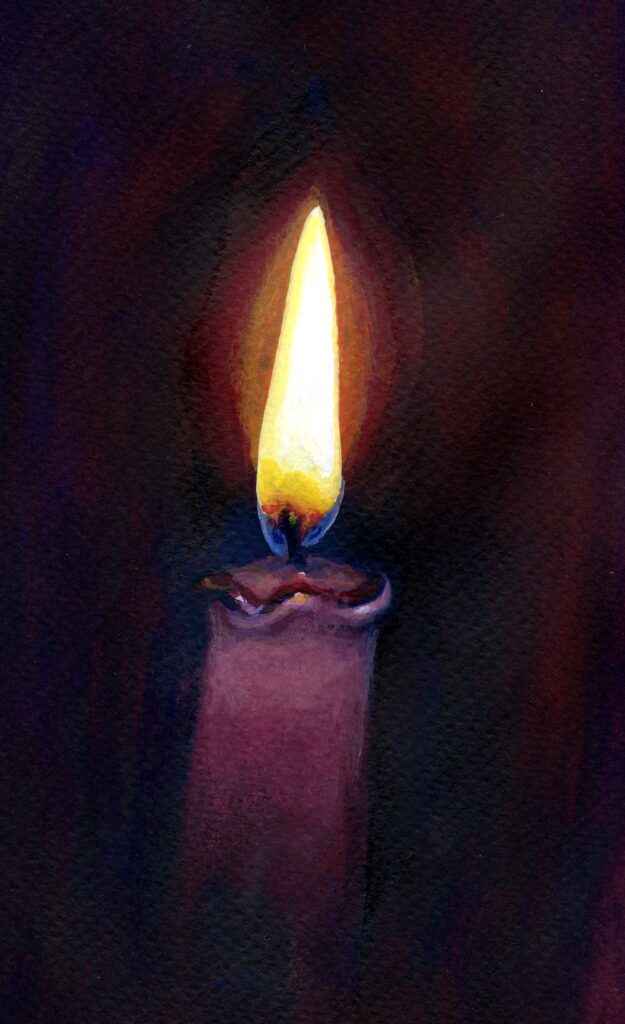
Watercolour and gouache on burgundy pastel paper
Fire is natural light. We can cause fire to happen but it is a natural phenomenon and unpredictable in its shape and form which is as flickering and fluid as water. There are some similarities with the way fire and water behave visually; the explosive bursts of fire from natural causes or rockets exploding in the sky are not so different from fountains spraying water as pressure is released by a valve; fire can also pour down volcanic mountains. A difference is that we see water because it reflects light but fire is the light source. Visually it is the difference between the sun and the moon. In our thought processes when we depict fire we depict power and potential danger, even when this is in the form of a humble candle.
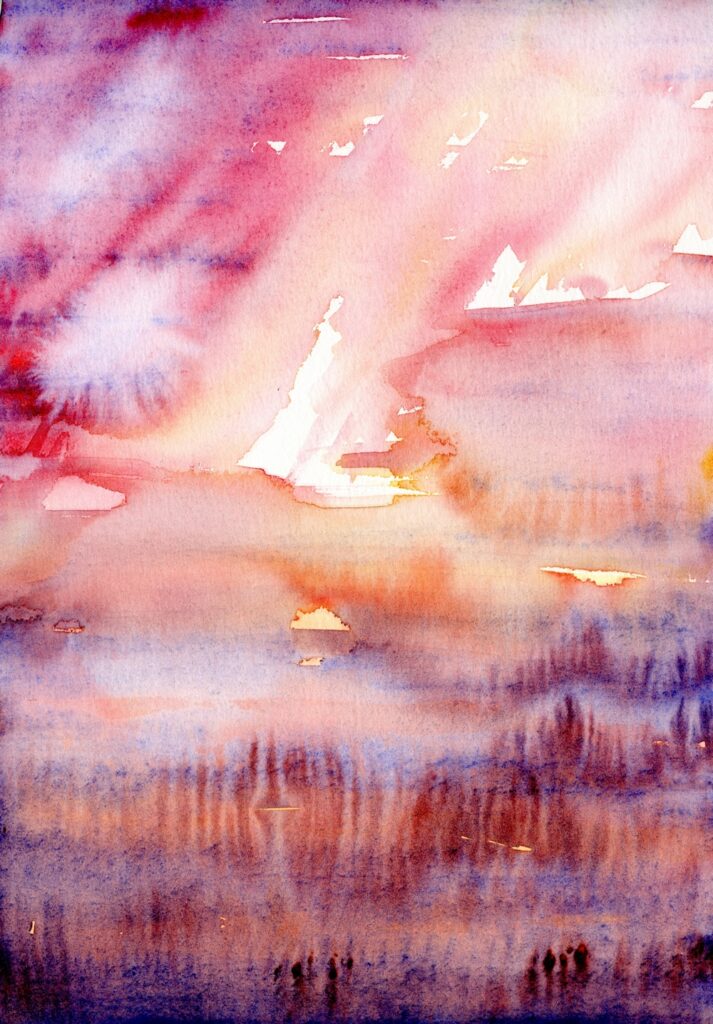
Watercolour; flames masked and rest worked wet in wet
Perhaps the disconnect between the power of fire which we harness domestically and its destructive nature, whether natural or harnessed for war is why we find the flickering flame so exciting.
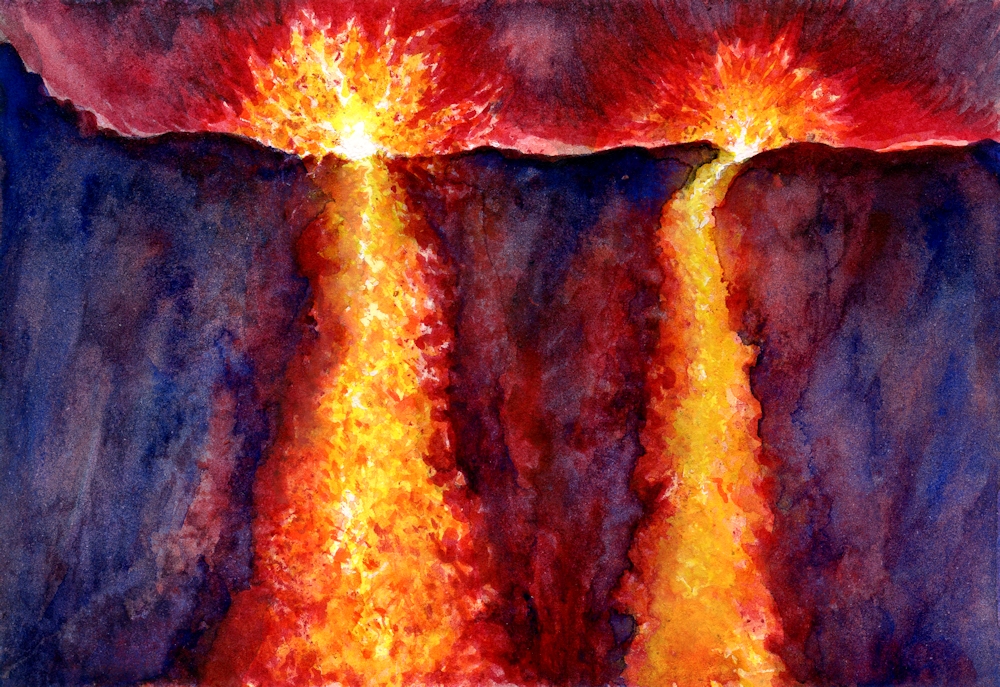
Gouache
That’s the philosophy bit done! Now for a look at the candle;
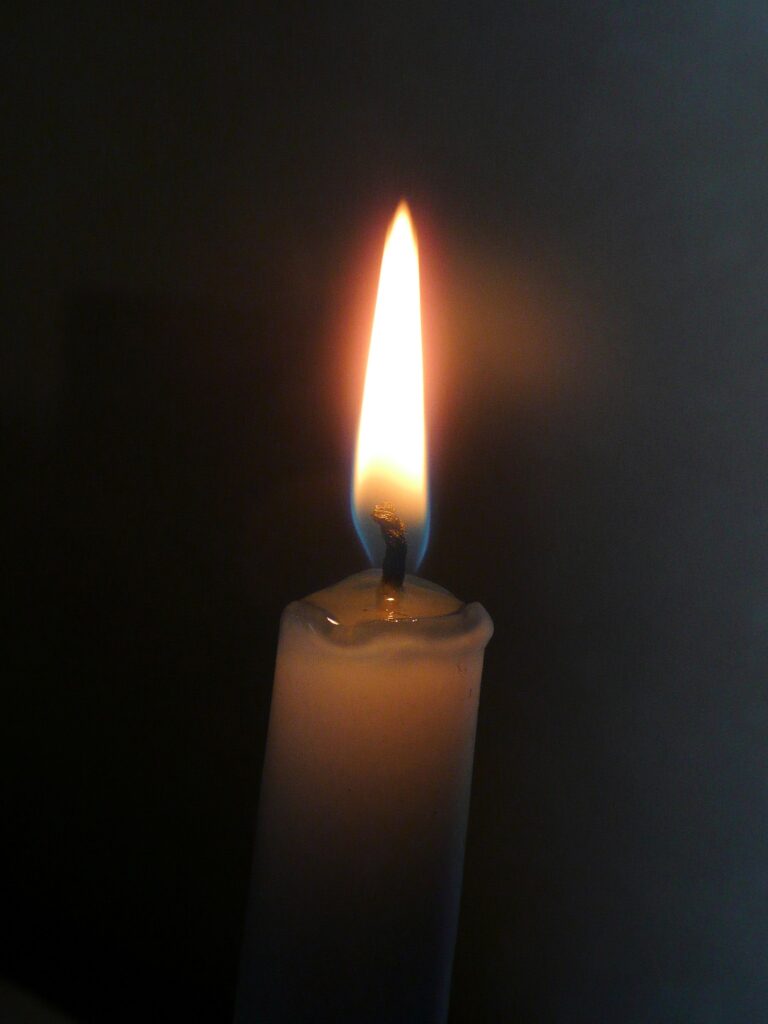
Photograph:
The “halo” is not necessarily the sphere as seen in so many Christmas greetings cards. Note the blue at the base of the flame and bands of orange and yellow. Look at the soft glow of the top of the candle itself and tiny subdued highlights in the molten wax. The wick is barely discernible against the dark background here.
Lastly note how the reddish halo gradually merges with the dark ground; colours from dark orange to deep red before becoming indistinguishable from the red/black darks.
If you wish to make a candle study you may like to light a candle, taking sensible safety precautions and observe the colours you see. Your colours and tones may be very different from those in the photograph above so observation is the key to developing a realistic painting.
In 1982 to 1983 Gerhardt Richter made some very beautiful and photo-realistic oil paintings of candles, closely observed against different backgrounds. These look deceptively simple but are carefully painted with huge skill in handling the paint where gradual transitions from light to dark occur. References to these can be found on this week’s Pinterest board at:
https://www.pinterest.co.uk/jhall1282/lights-in-art/fires-candles-fireworks-bonfires/
Alongside works by;
Georges de la Tour: more candles and candle light; look at how faces reflect the candle light in his works
Joseph Wright of Derby: volcanic eruptions and a fire burning a cottage down at night
And Bonfires by the contemporary artist Brent Cotton.
This should supply you with plenty of ideas for next week’s painting. I would like to see work either from your imagination or a fire situation you have experienced; from an erupting volcano to a child’s birthday celebration or Christmas candle.
Looking forward to seeing
Your paintings;
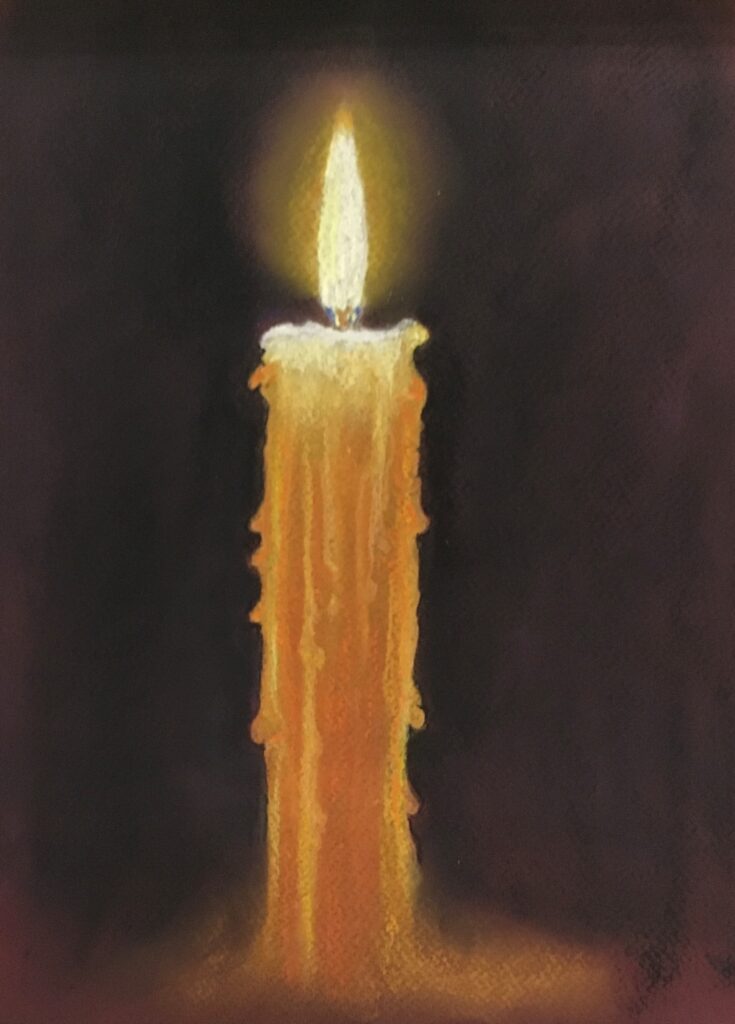
Pastel by Heather
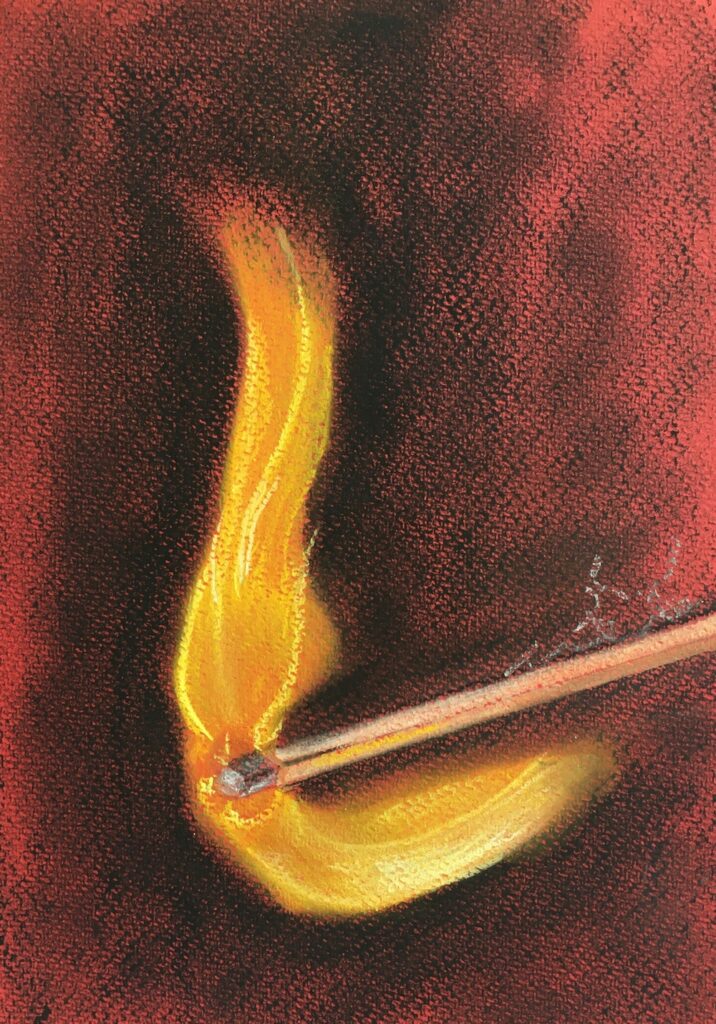
Pastel by Heather
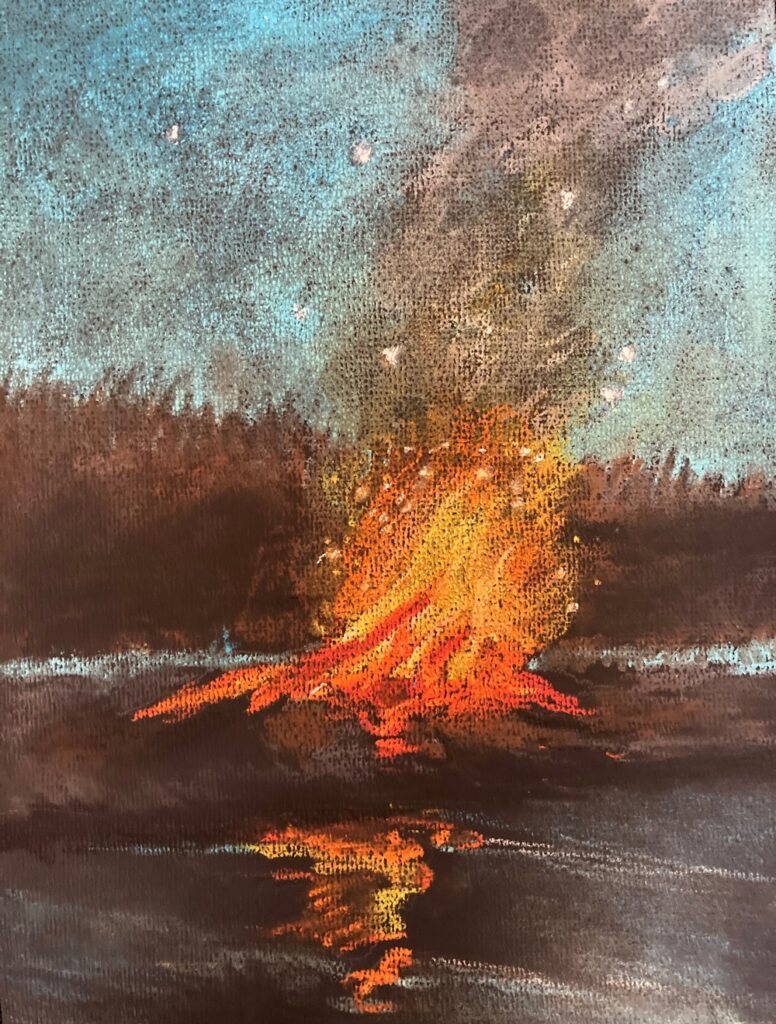
Pastel by Shane
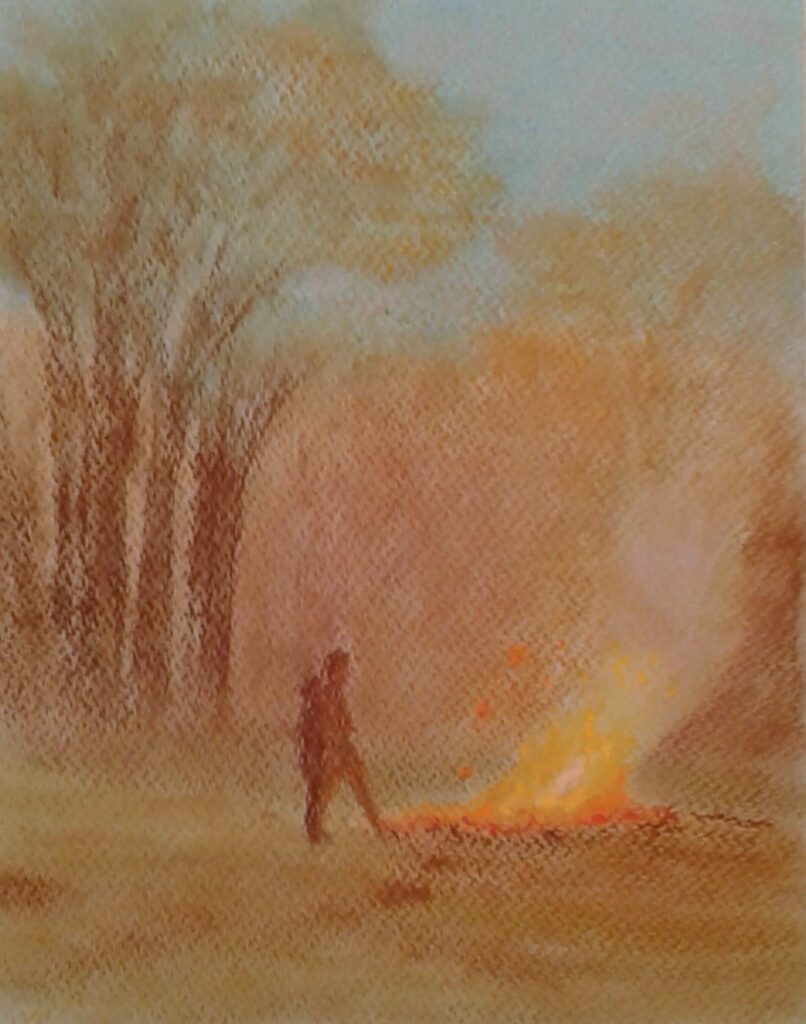
Pastel by Barbara
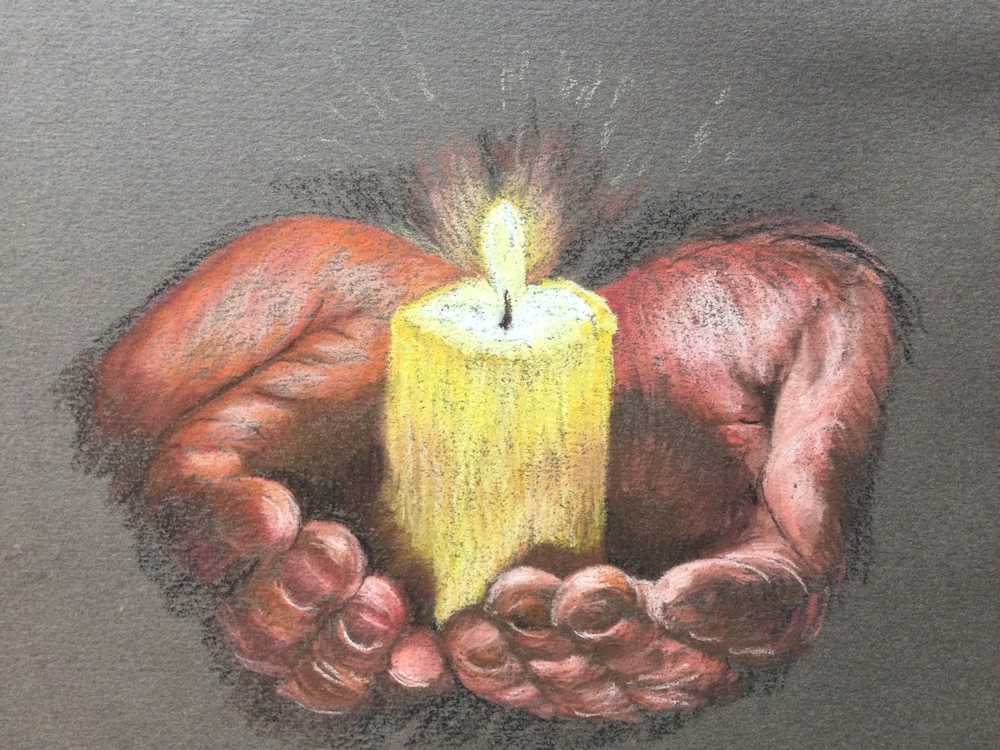
Pastel pencil on pastel paper
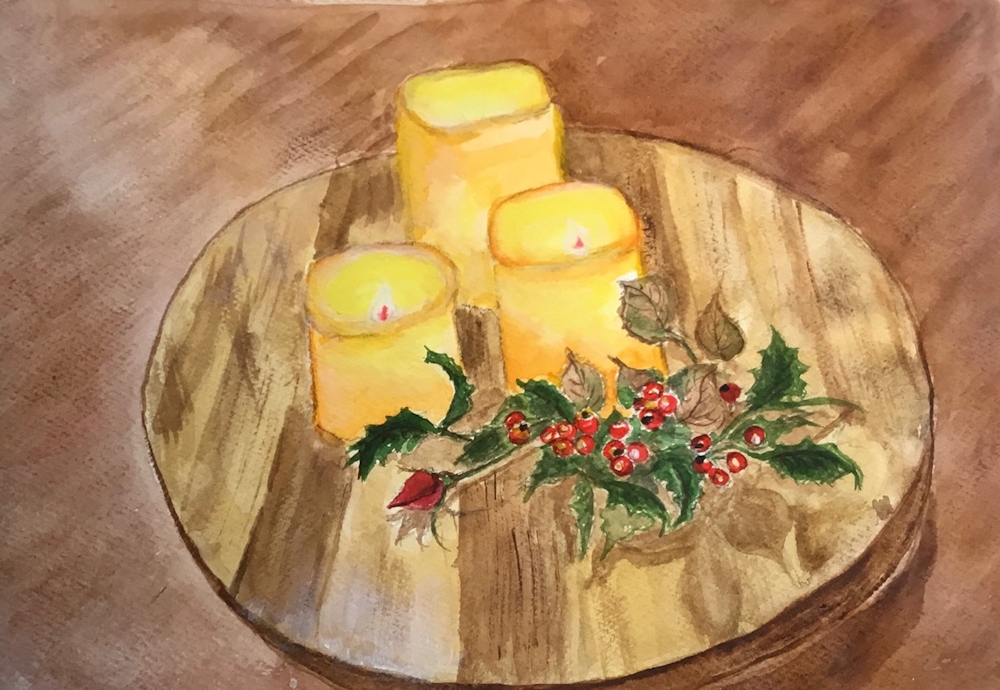
Watercolour
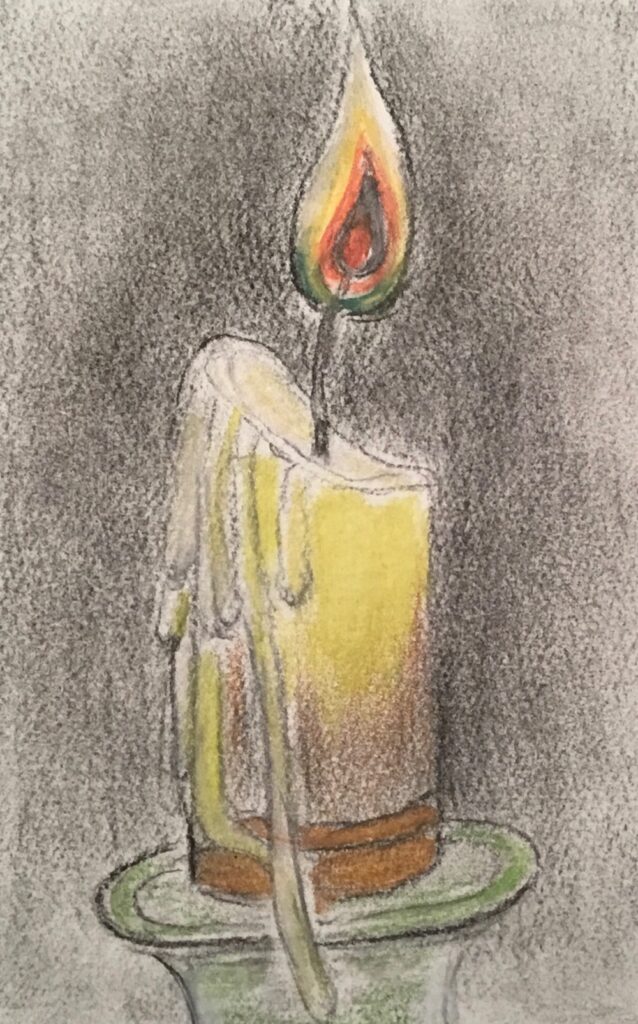
Charcoal and coloured pencil
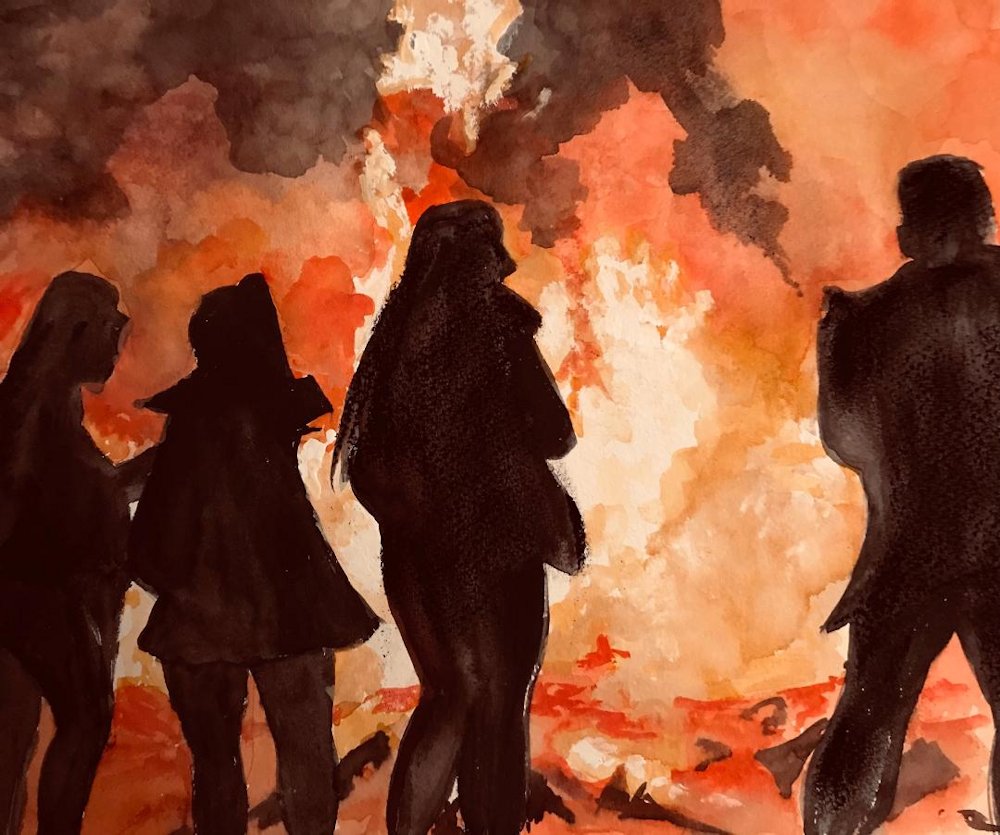
Watercolour by Sarah
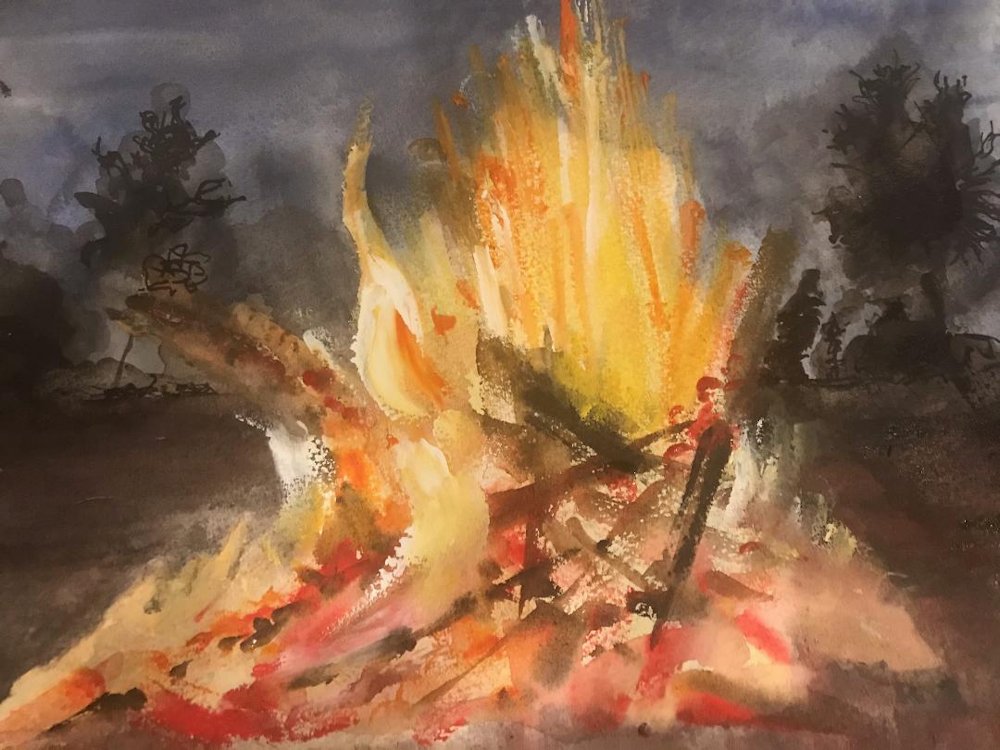
Painted with brush and finger by Sarah
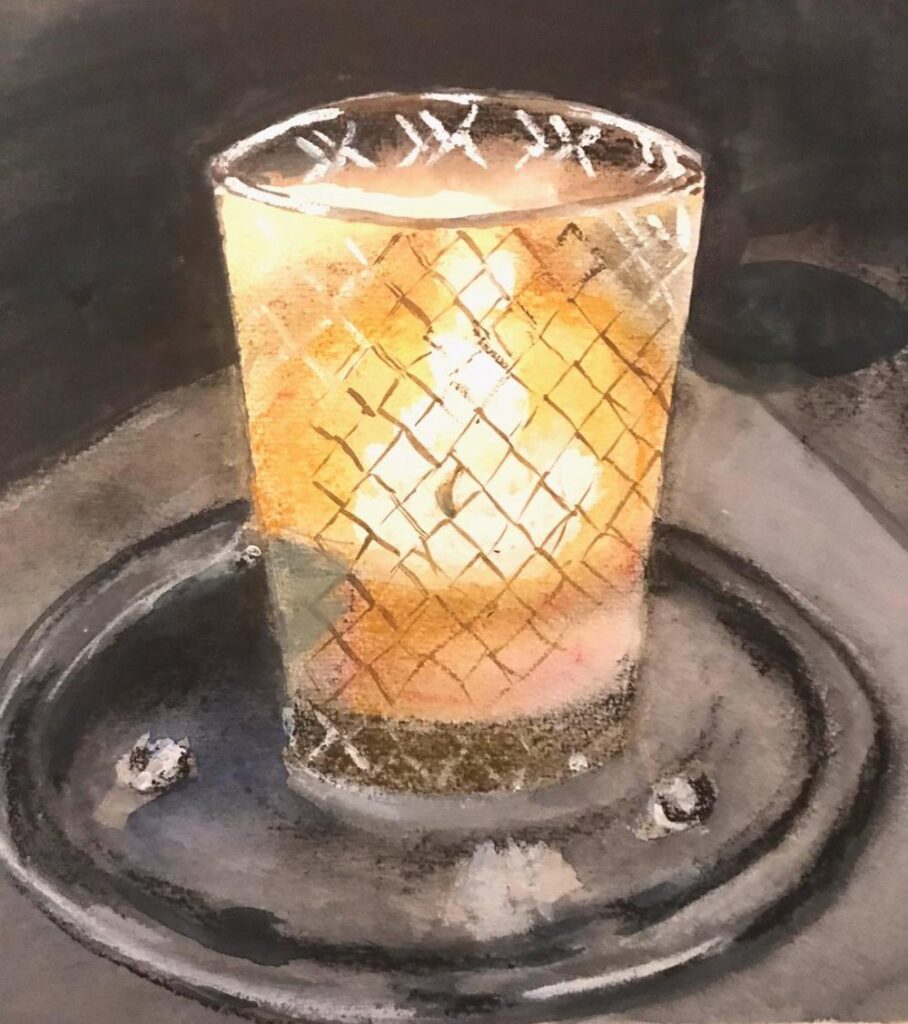
Watercolour and pastel by Sarah
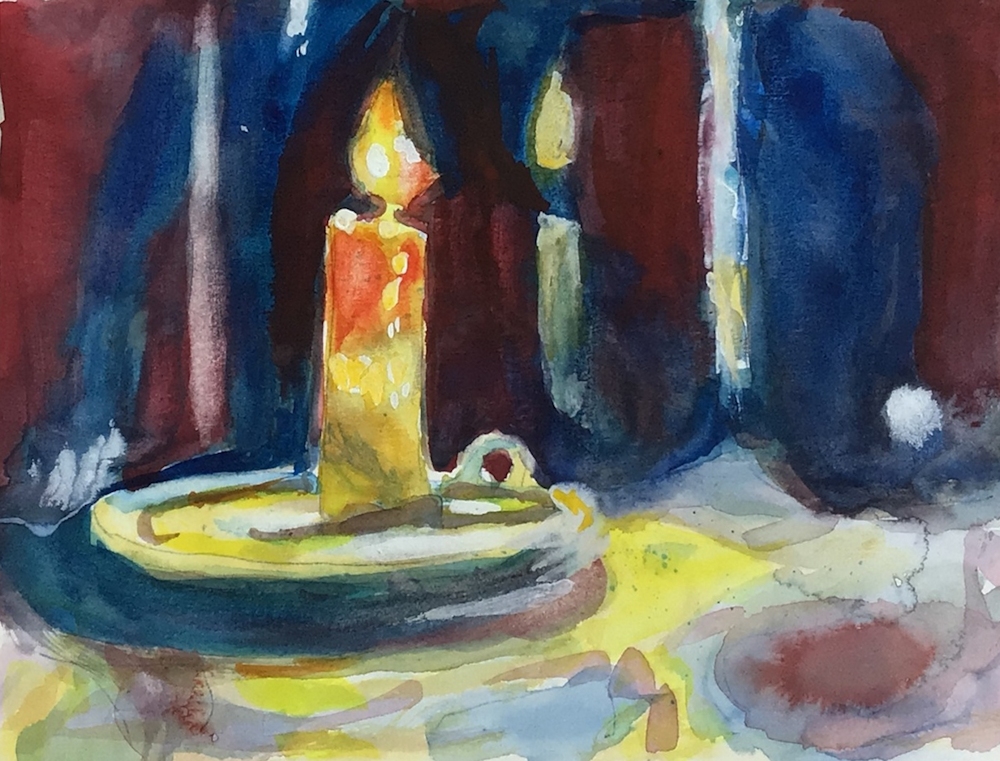
Watercolour by Maricarmen
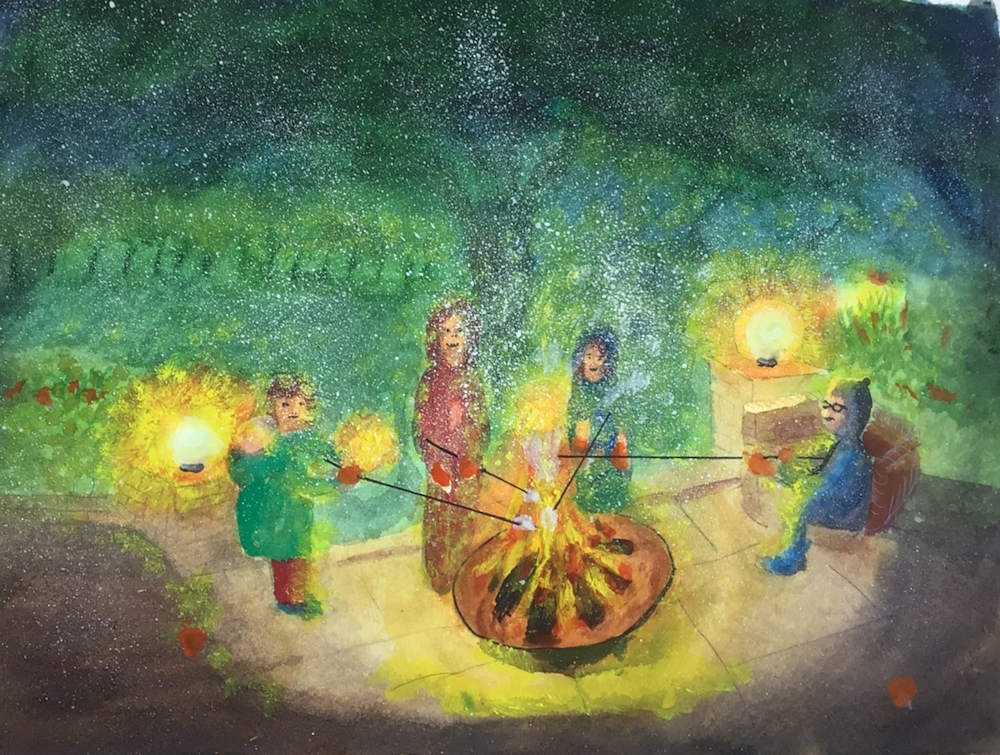
Watercolour by Maricarmen
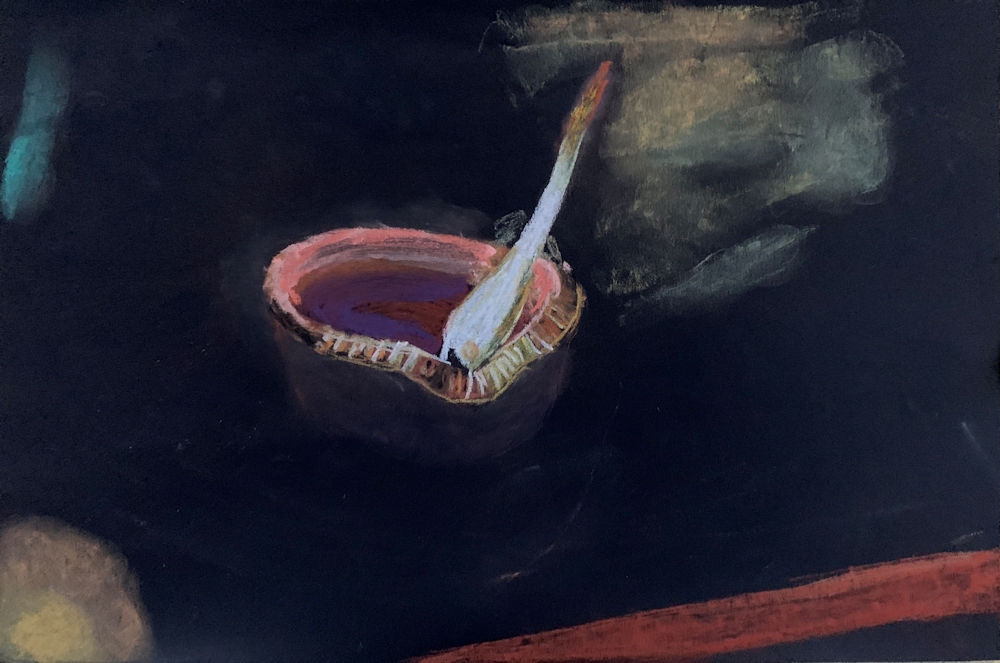
Pastel by John
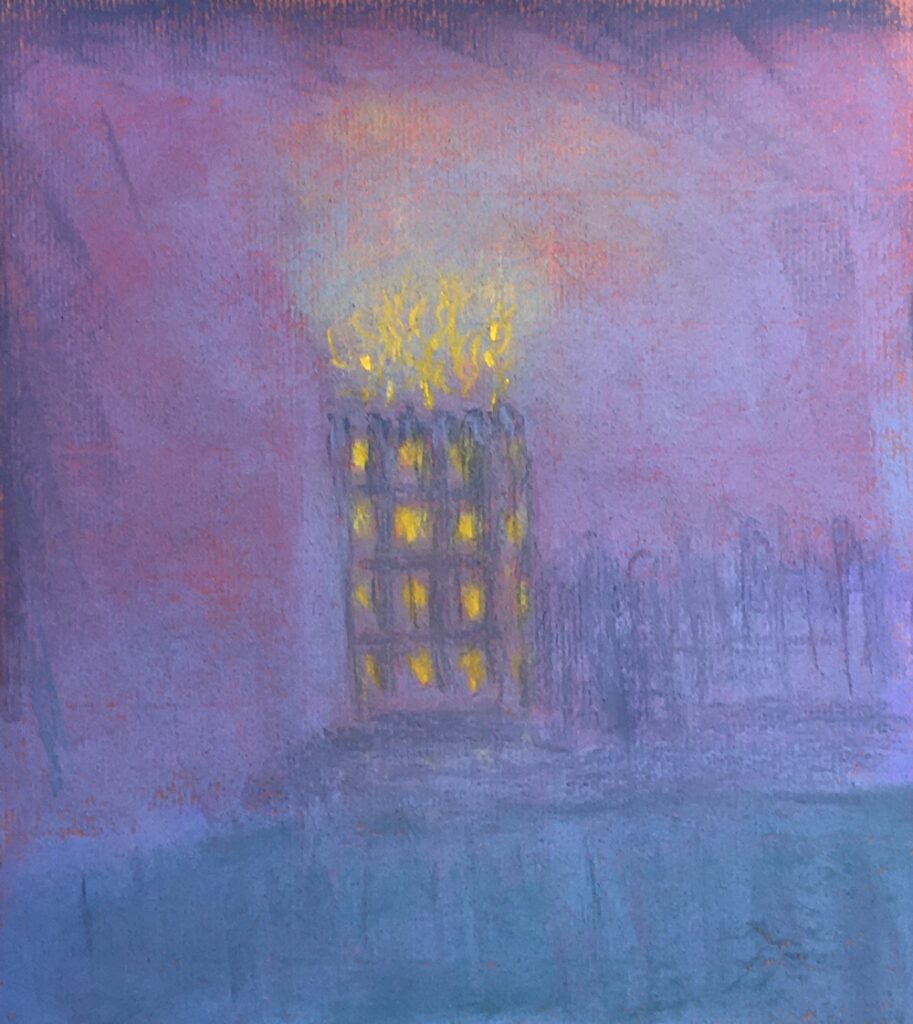
pastel by Shirley
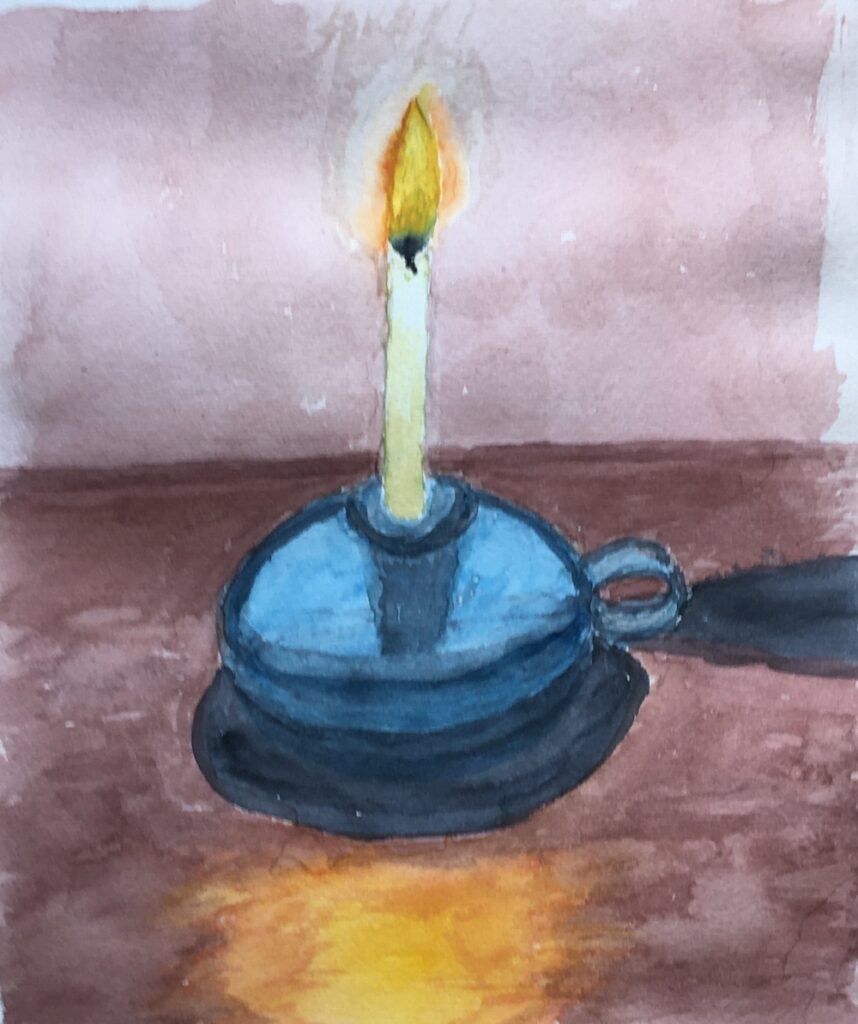
Watercolour by Shirley
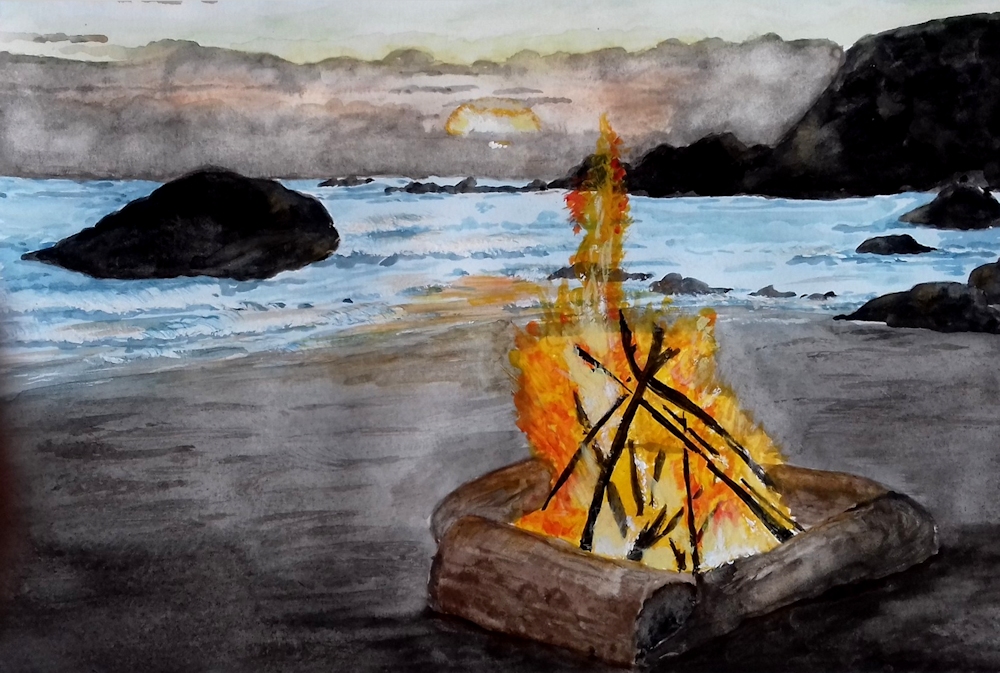
Watercolour by Liz
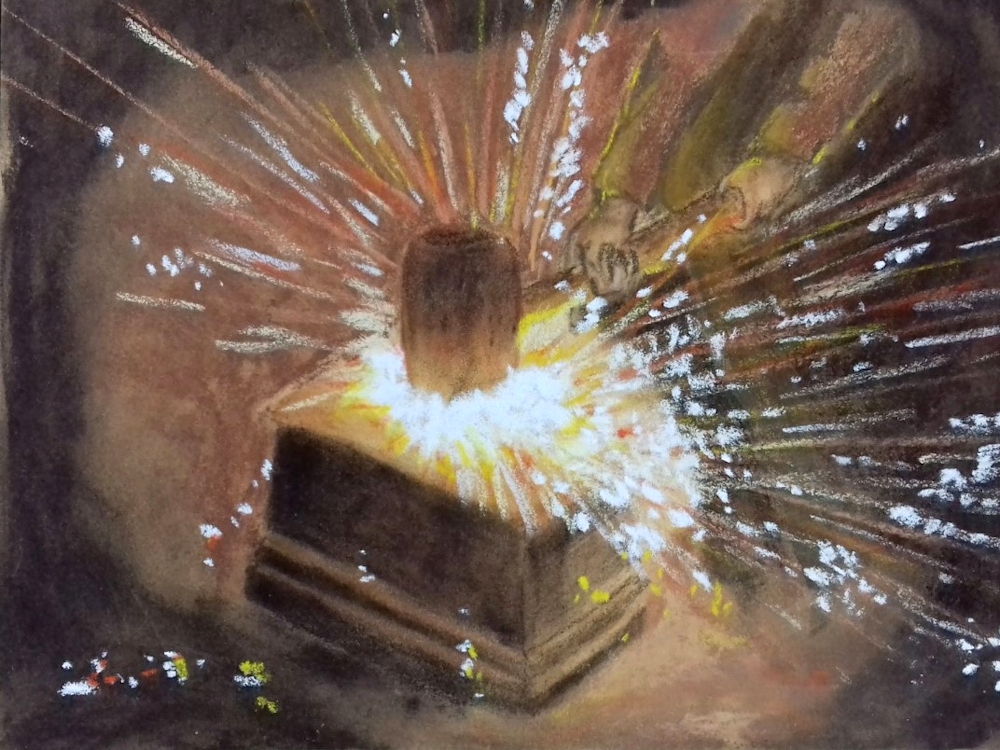
Pastel by Liz
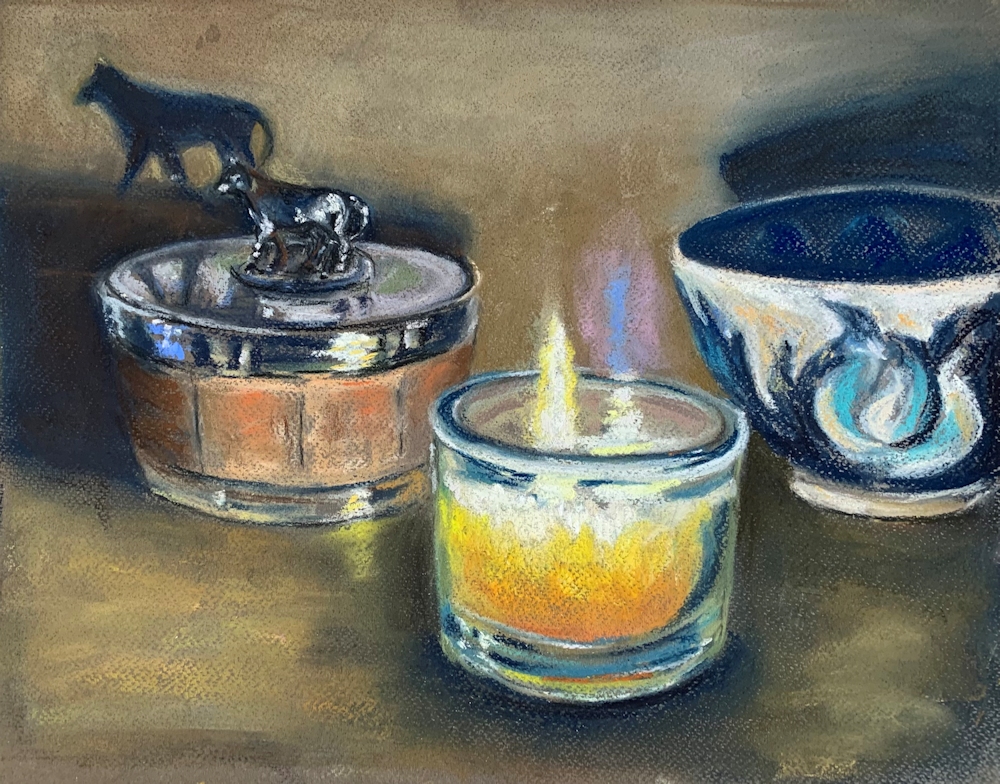
Pastel by Jan
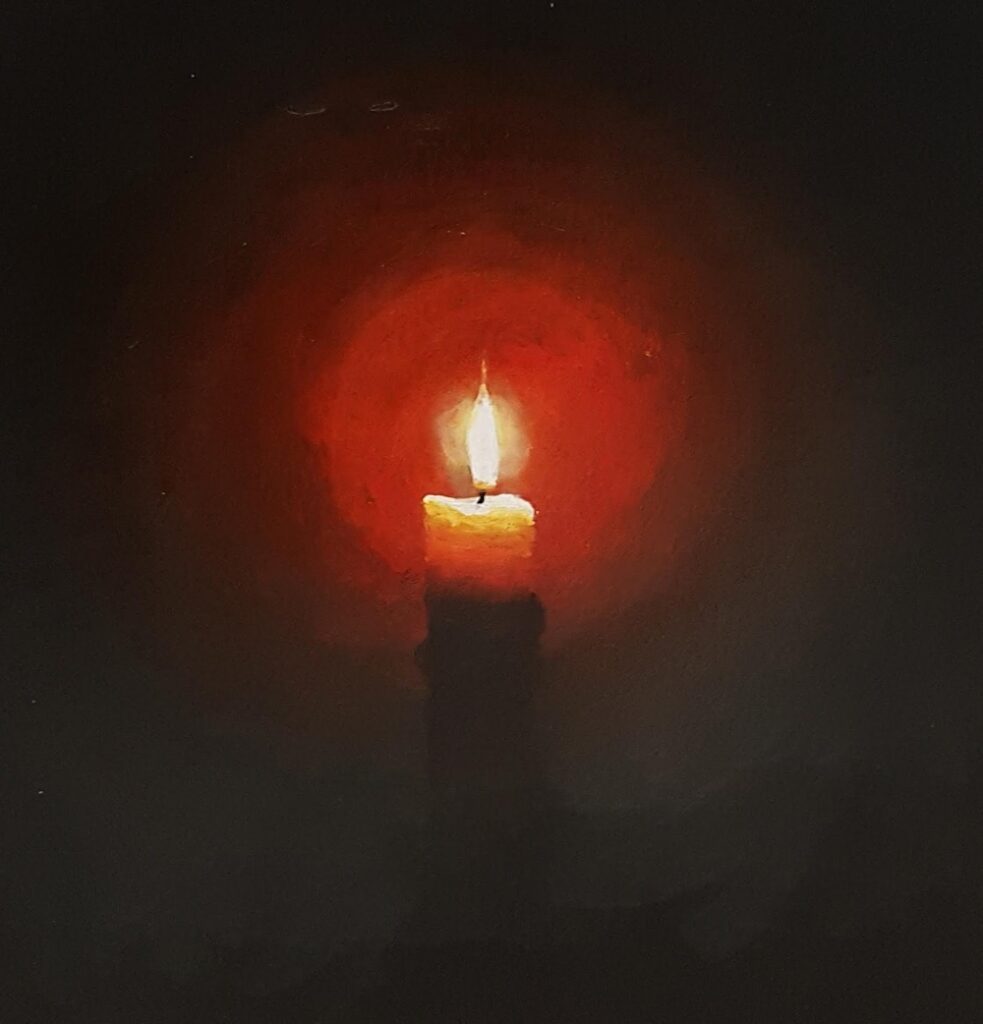
Acrylic by Malcolm
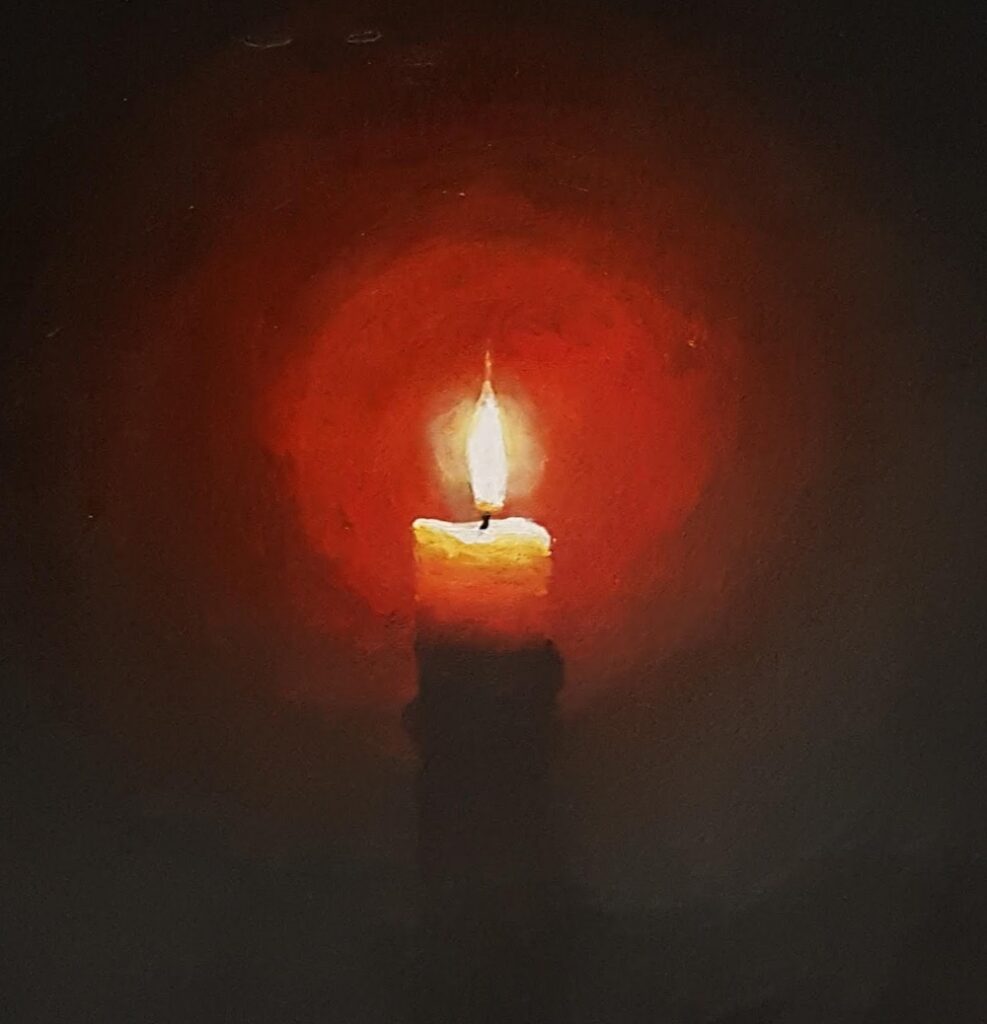
Acrylic by Malcolm
Lights in the Sky, Lights from the Land: Harbour and River Lights
November 10, 2020
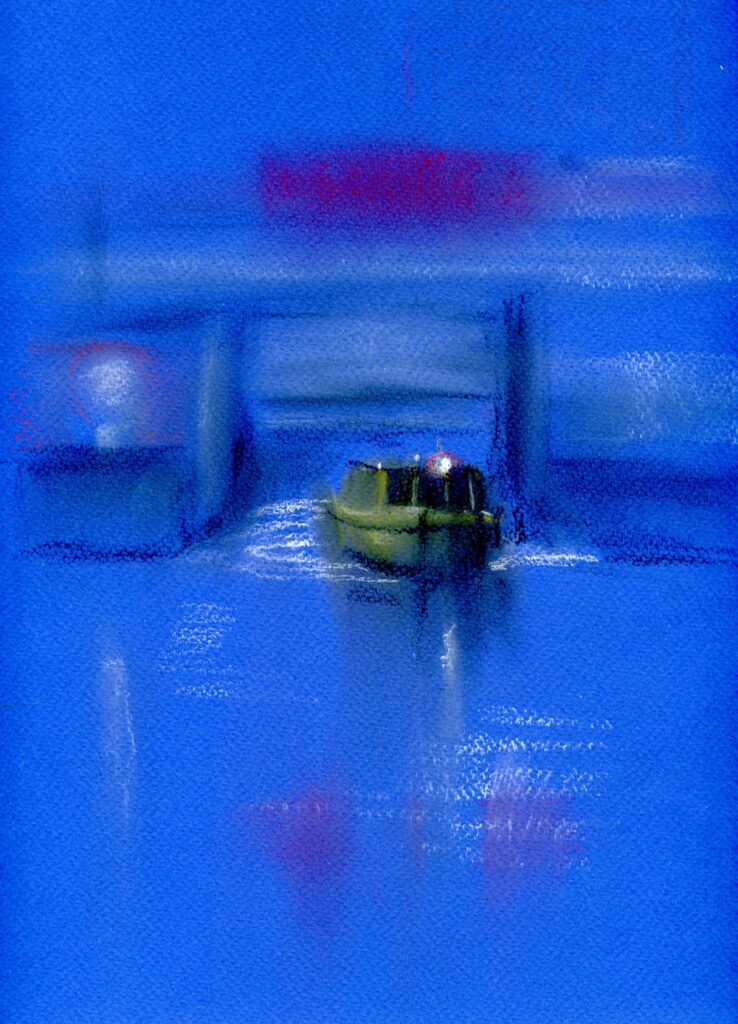
Pastel on blue paper
This week we are moving toward the coast, rivers and canals for inspiration and your challenge will be to produce paintings including a light source and its reflection in water. The reflection will not only be affected by the position of the light source to its reflection but also the prevailing light conditions; mist or the darkness of night and whether the water is calm, rippling or rough.
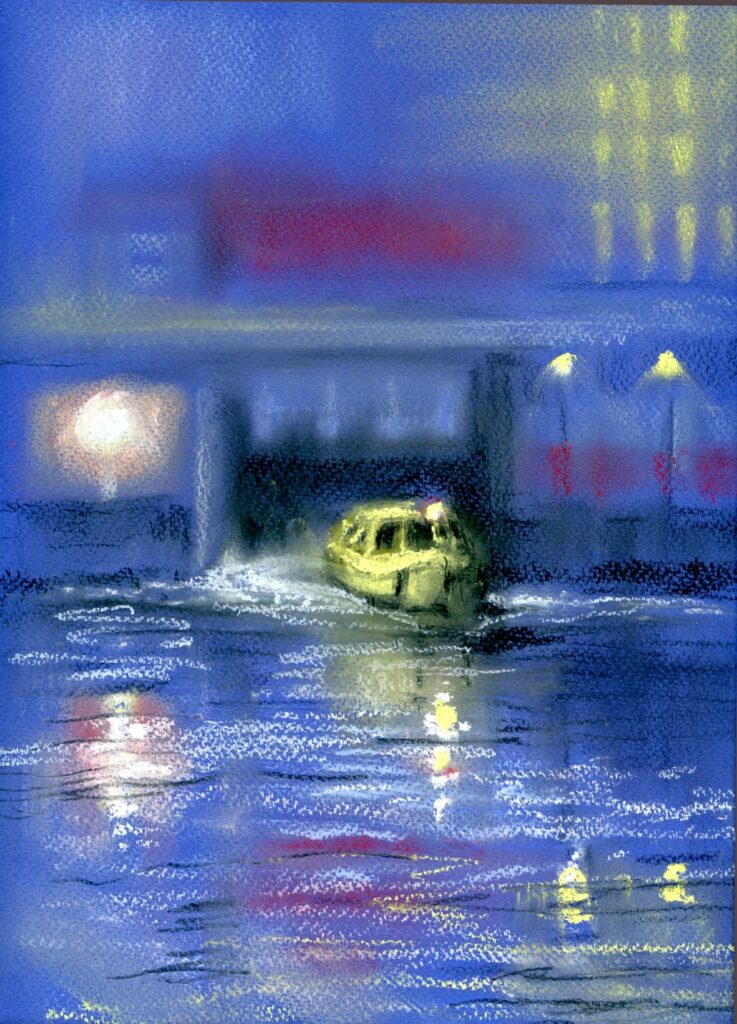
Pastel on blue paper
This has been developed from the first picture and has a completely different atmosphere.
Look at photos of rivers and the sea where any light is reflected and look at how reflections are interrupted and sometimes scattered by waves.
Apart from the vertical positioning of any reflection take special care that each reflection is directly below the light source being reflected. This is seen very clearly both in works by Whistler and Andrew Gifford. better still take a walk along the Thames in the early evening.
The medium is very much your choice and as last week you may work from your imagination or from a reference, preferably of a place you know. James McNiell Whistler is famed for his series of “nocturne” paintings of the Thames. The darkest of these are full of drama and the most subtle have that beauty of early morning stillness. Examples of Whistler’s nocturnes alongside works by Andrew Gifford and the Canadian artist David Haughton can be seen on this week’s Pinterest board at:
https://www.pinterest.co.uk/jhall1282/lights-in-art/harbour-lights-lighthouses-and-docks/
Also included are some imaginative works by Charles Philippe Jacquet. The artist’s rather surreal compositions combine his ideas with an almost believable reality. In reviewing some of your own photographs you may be inspired to adapt them to an imaginative approach or to paint a more representational painting. If your reference is complicated, consider making a study of part of it and experiment with little sketches before homing in on a final composition.
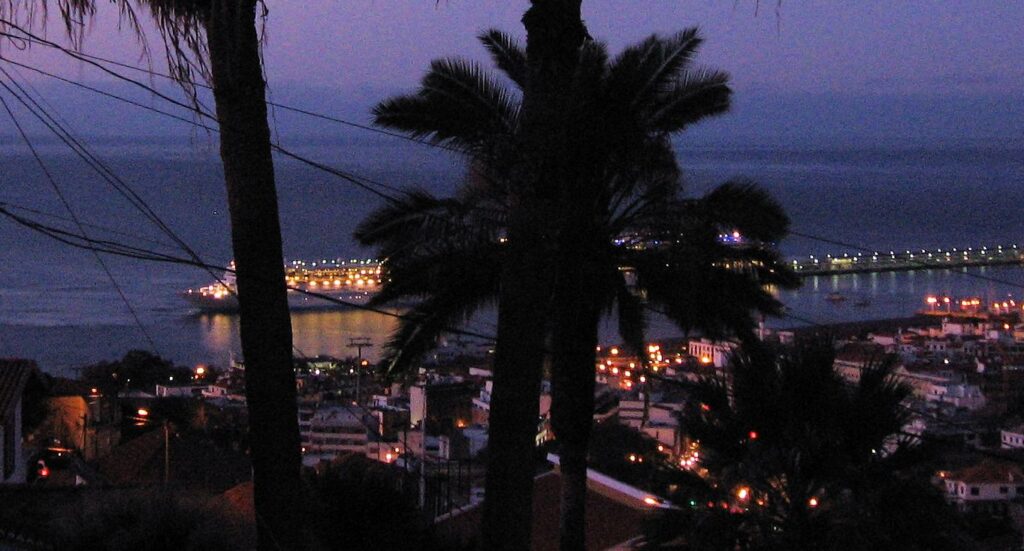
Lastly I couldn’t resist including this photo of a cruise ship leaving Funchal; the antithesis of the little yellow boat that carries commuters and tourists alike from Leeds Dock.
If you have very little in the way of references for lights reflected in water at night or evening from boats or buildings on the shore, make a sketch or photo of one of the bridges or part of the Thames shoreline at dusk. Maidenhead Bridge has plenty of lights. Alternatively, if you would like to try a more surreal approach why not choose a building you know and perch it with fully lit windows on a rock in the middle of a lake and imagine your own private lighthouse!
Your paintings:
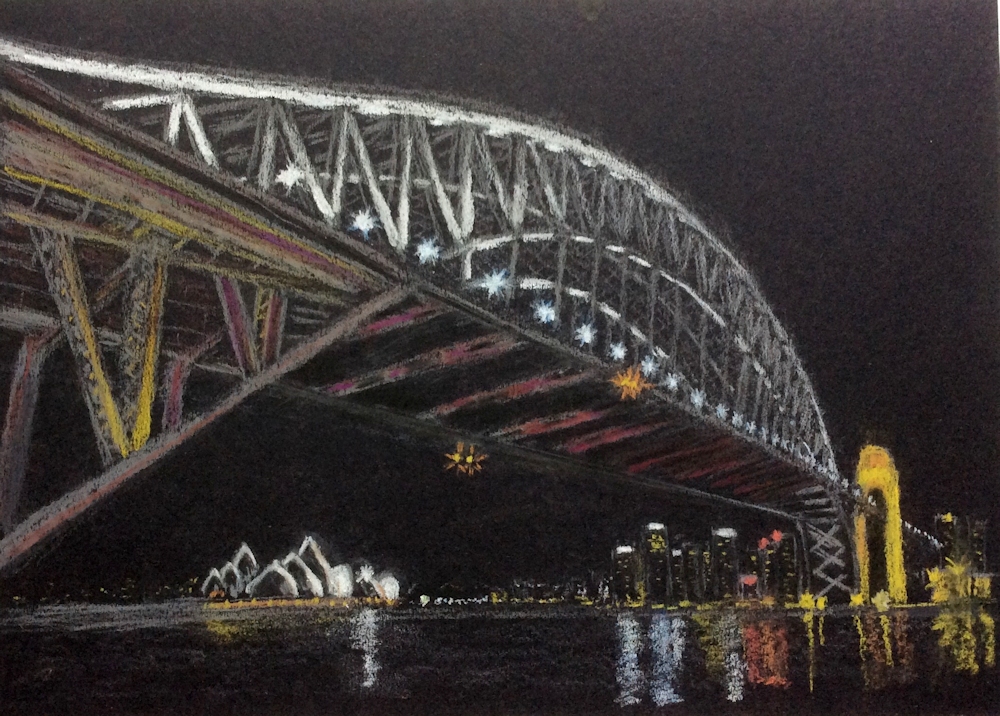
Pastel on black paper by Barbara
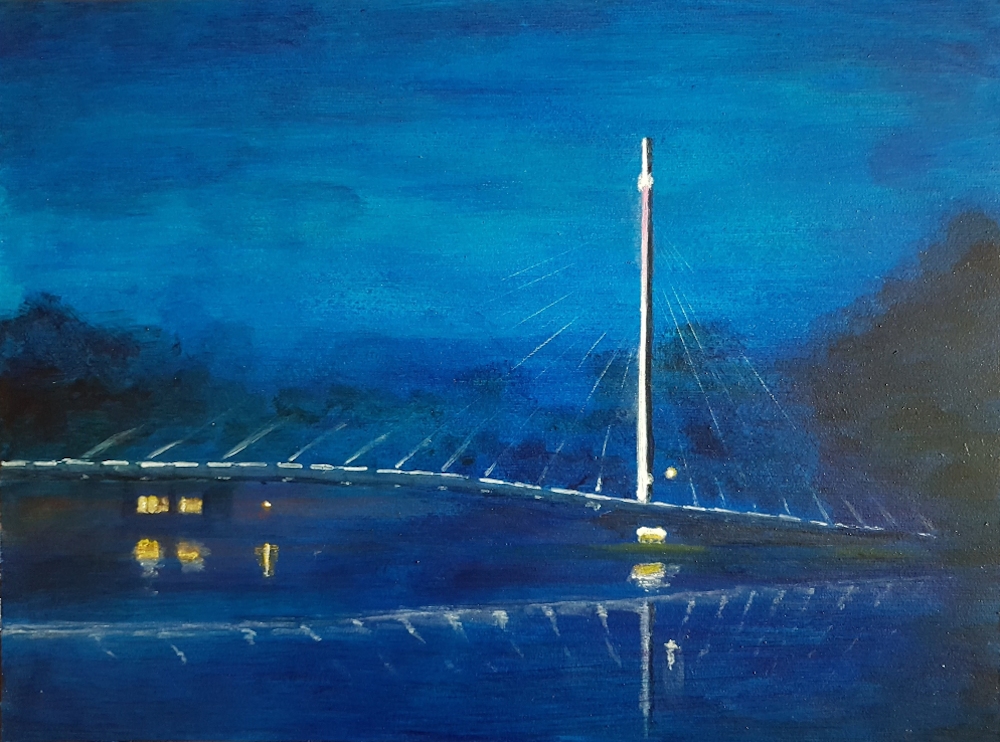
Acrylic by Malcolm
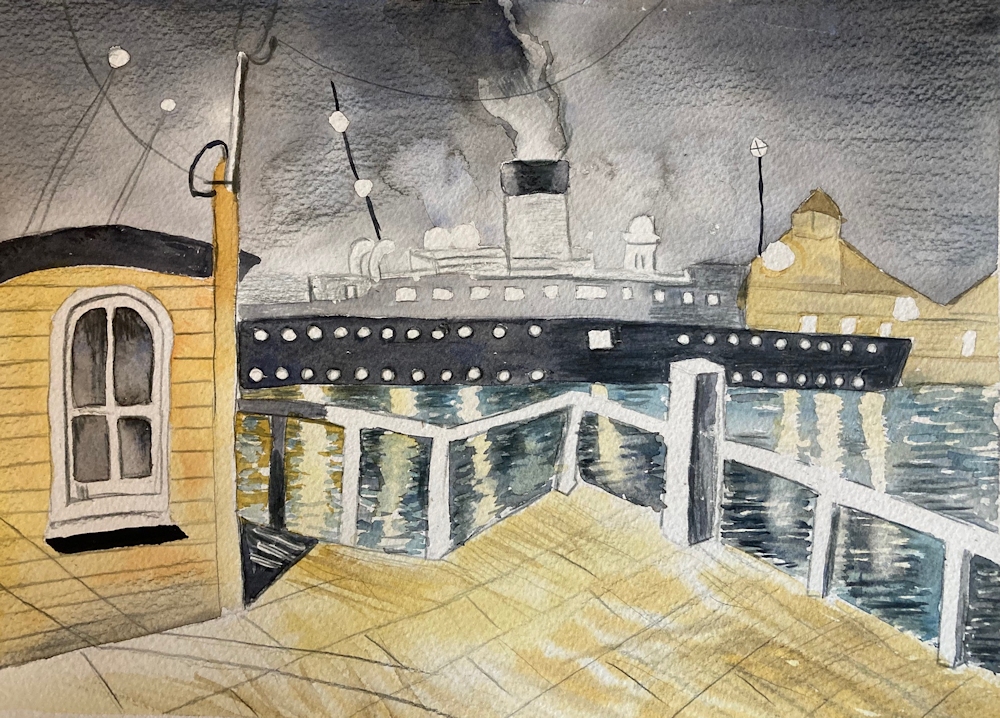
Watercolour by Shane
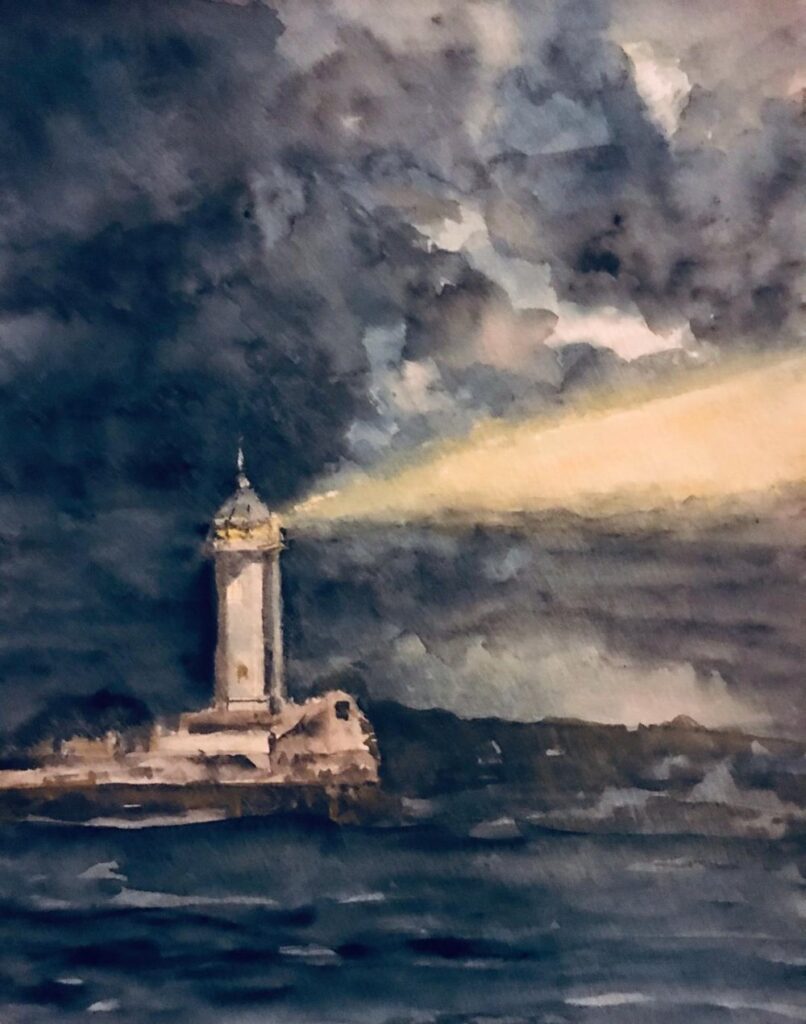
Watercolour by Sarah
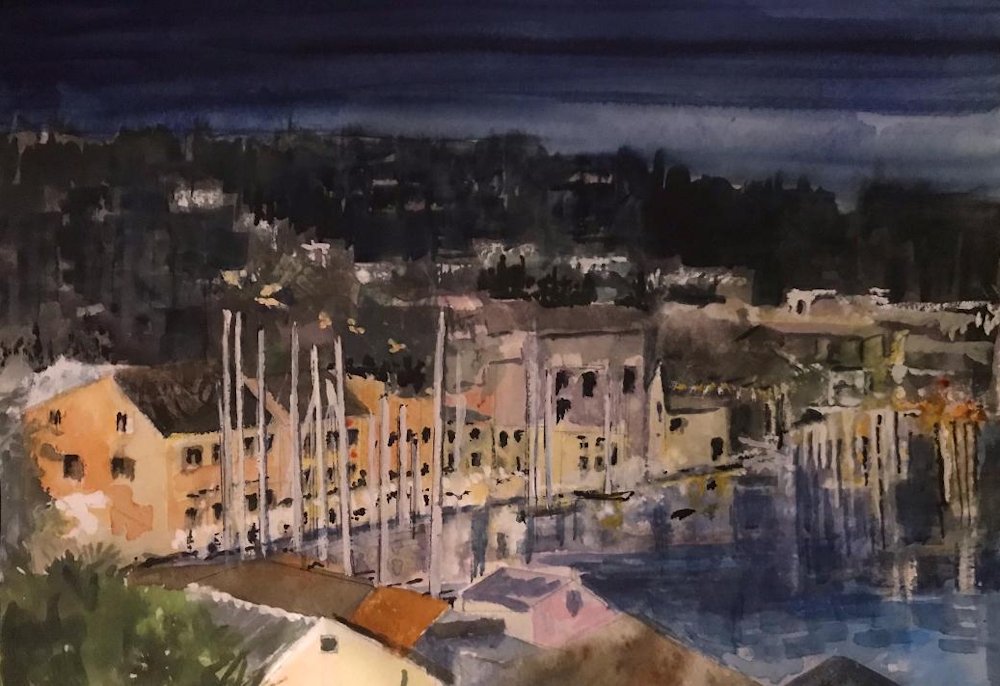
Watercolour by Sarah
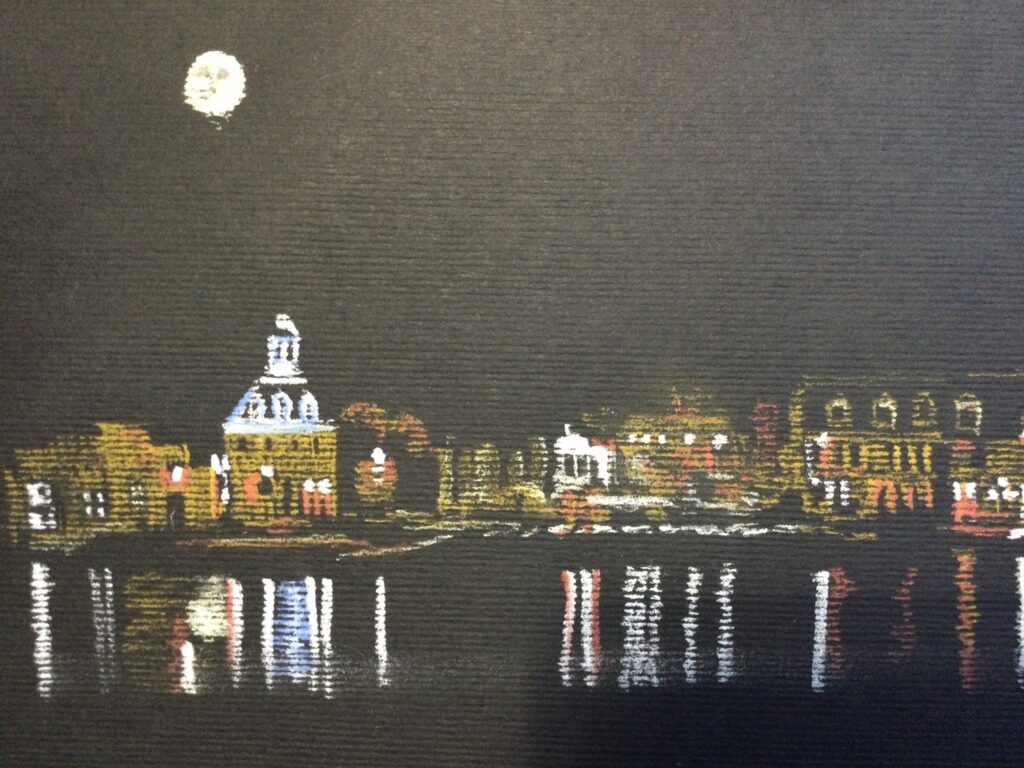
Pastel by Jane
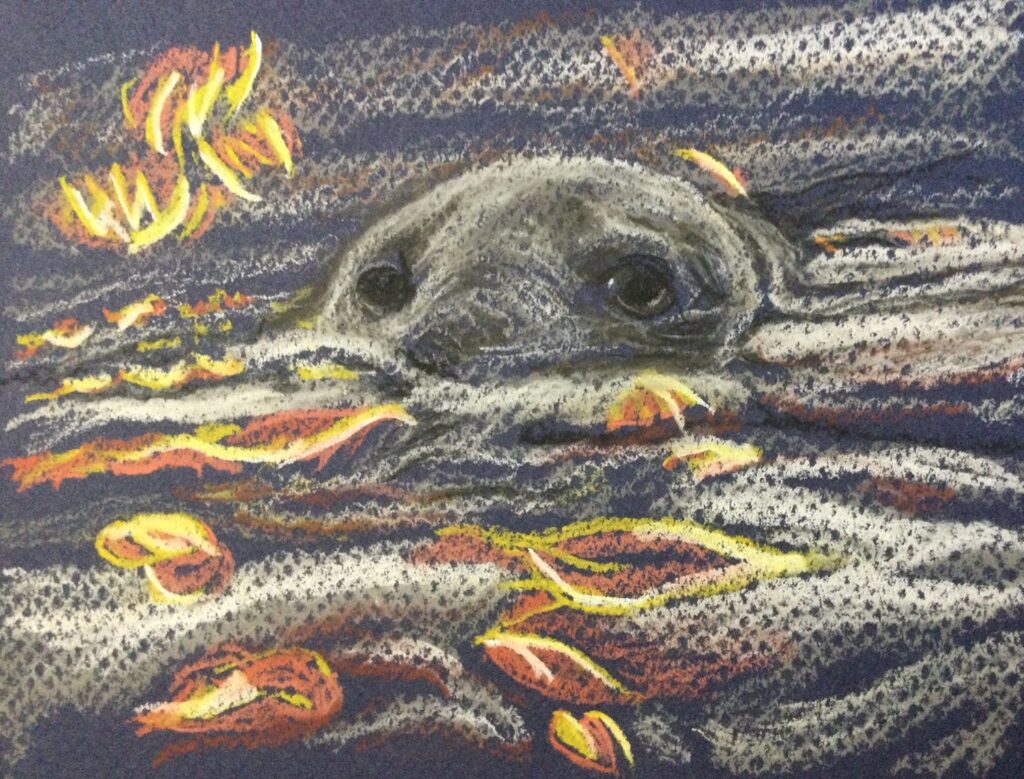
Pastel by Jane
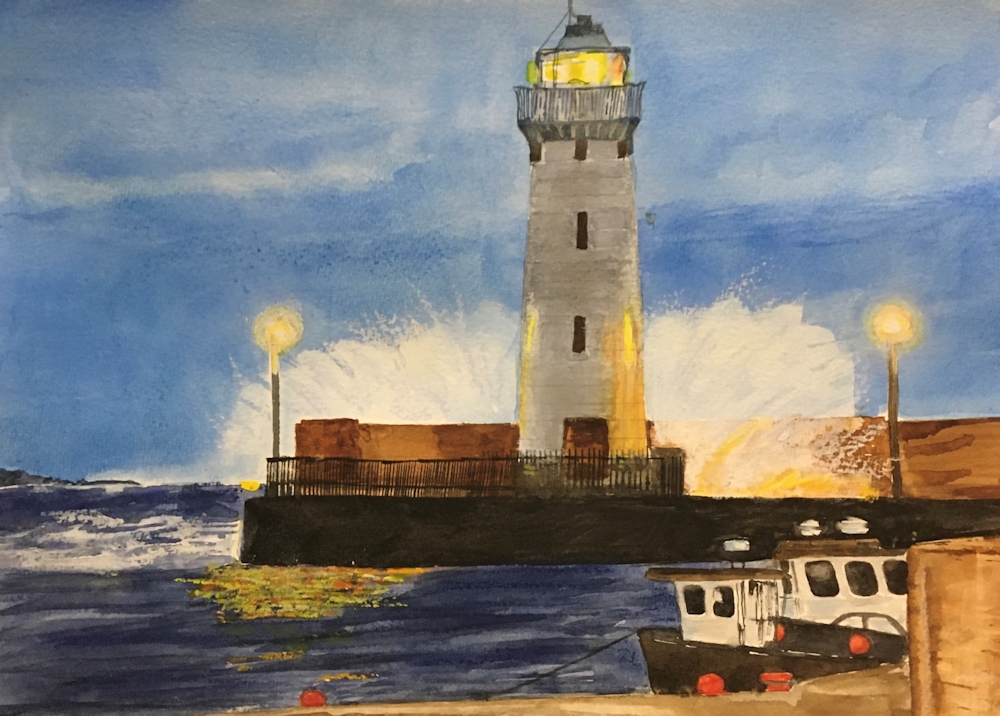
Watercolour and Pastel by Heather
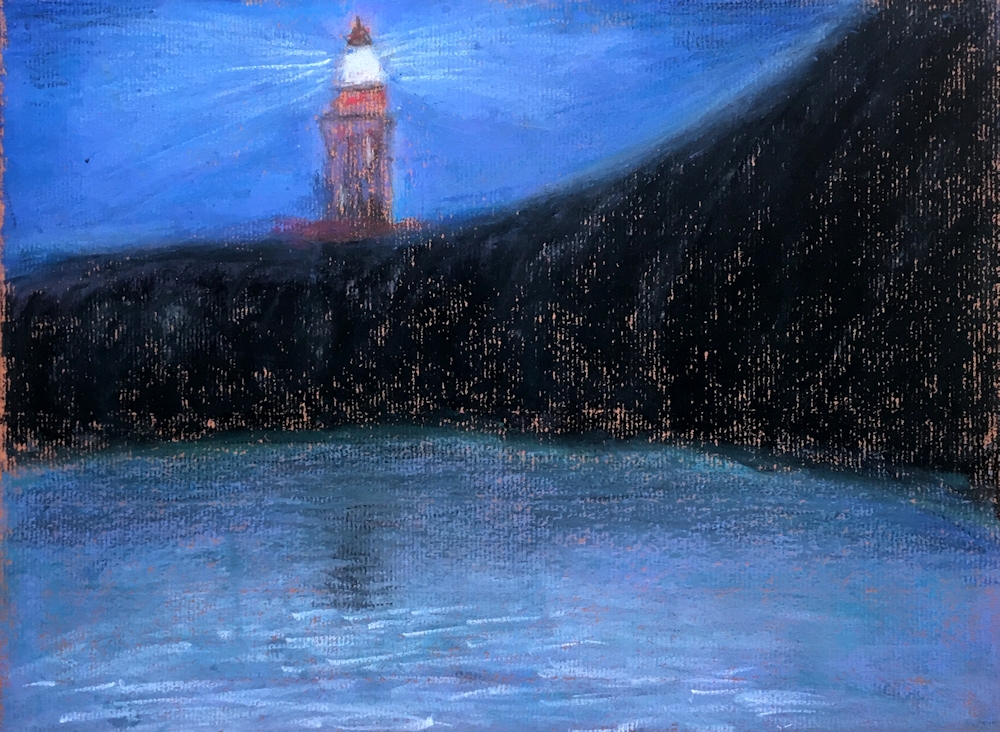
Pastel on terracotta paper by Shirley
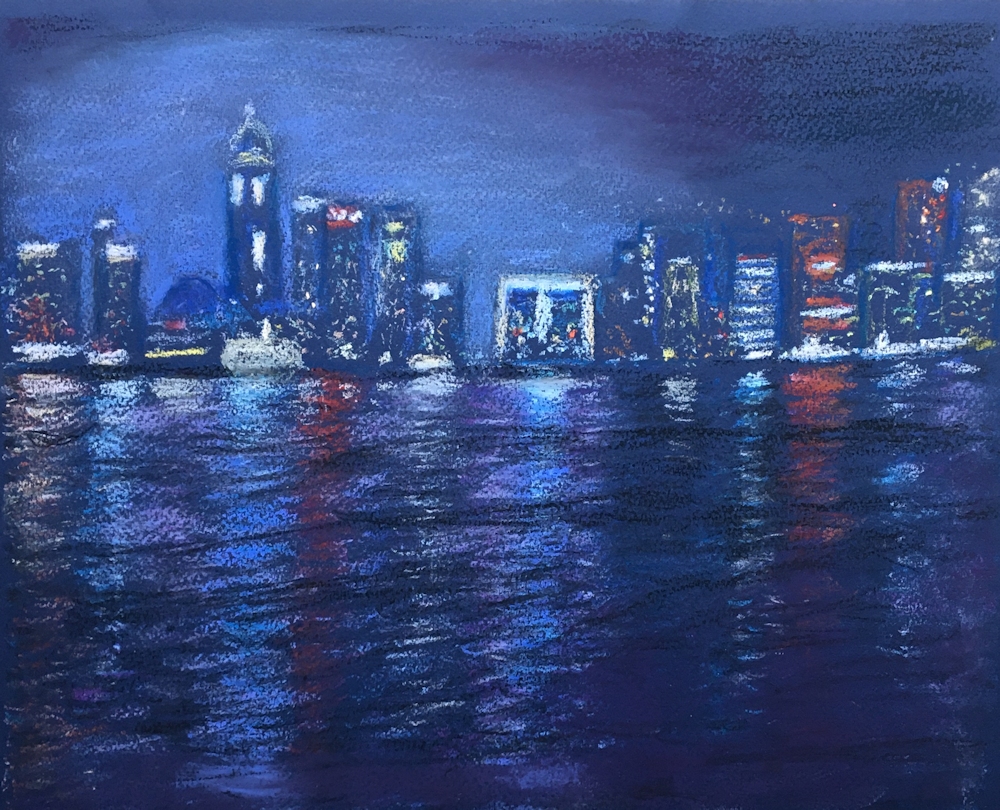
Pastel on dark paper by Shirley
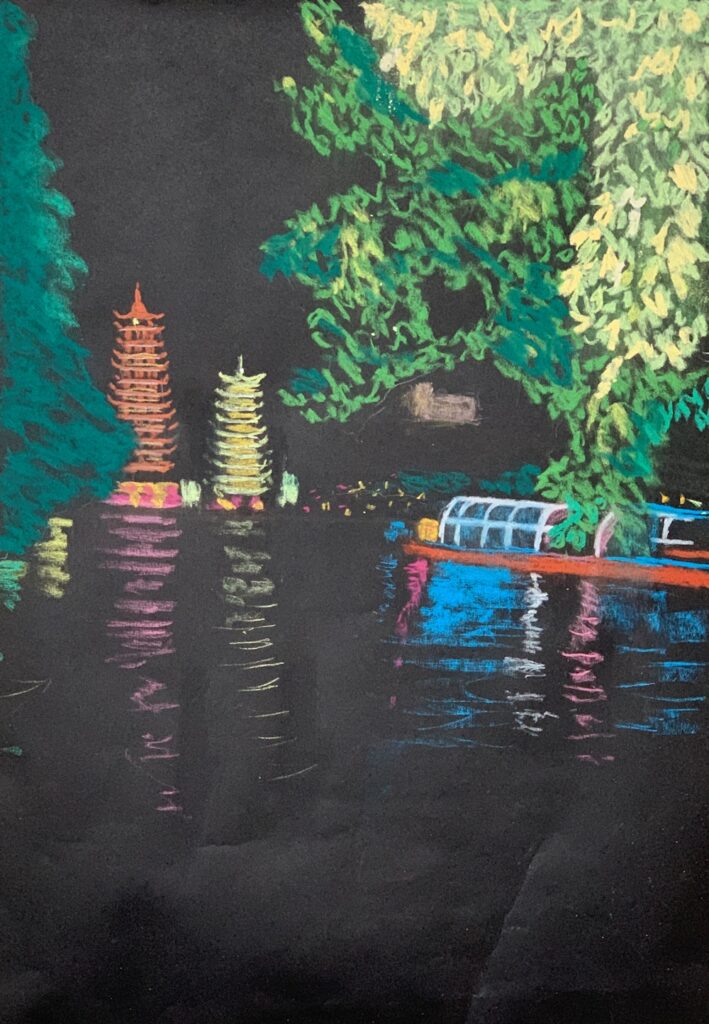
Pastel by John
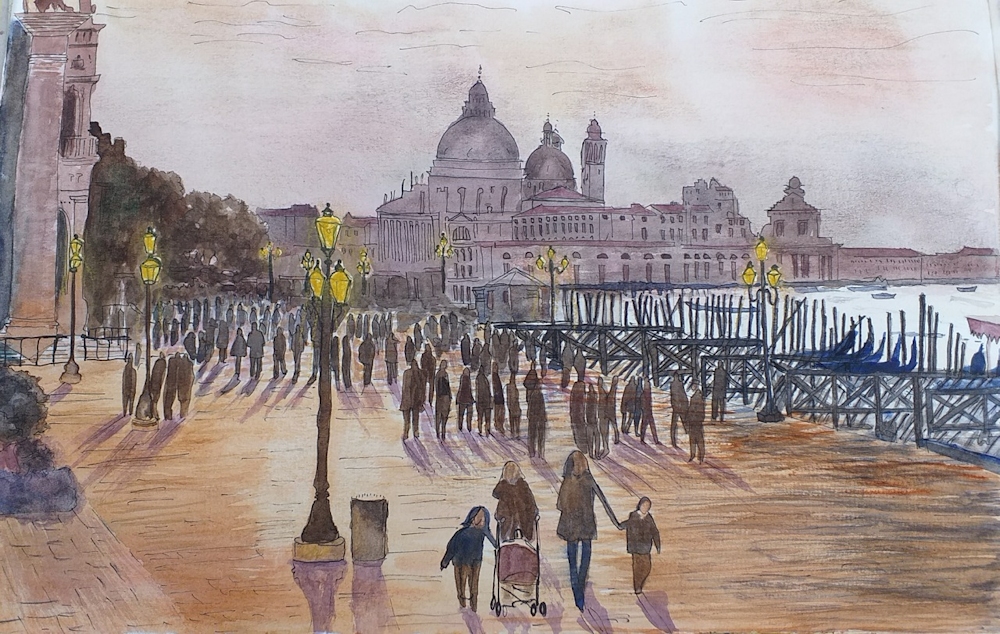
Watercolour by Maricarmen
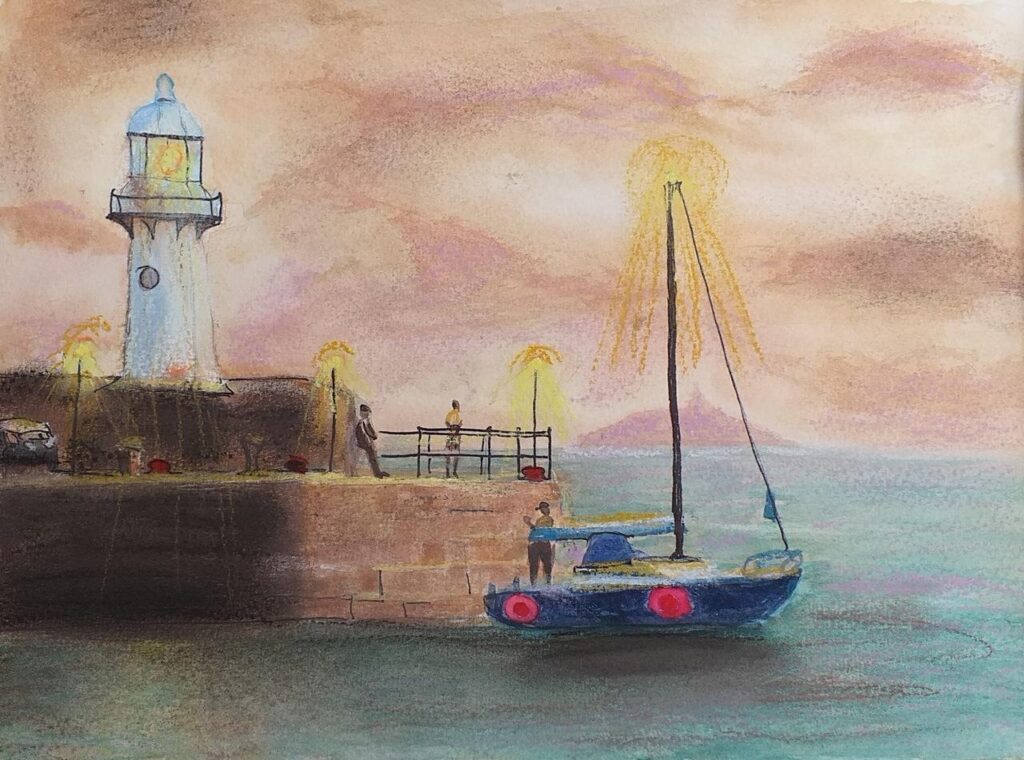
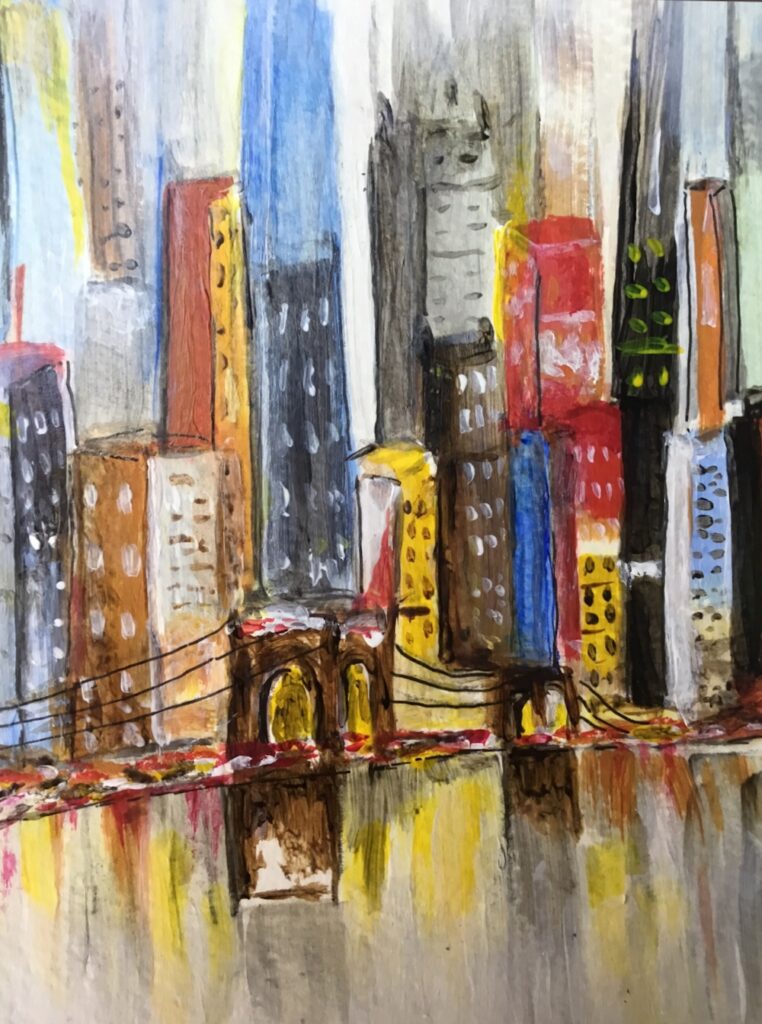
Watercolour by Ann
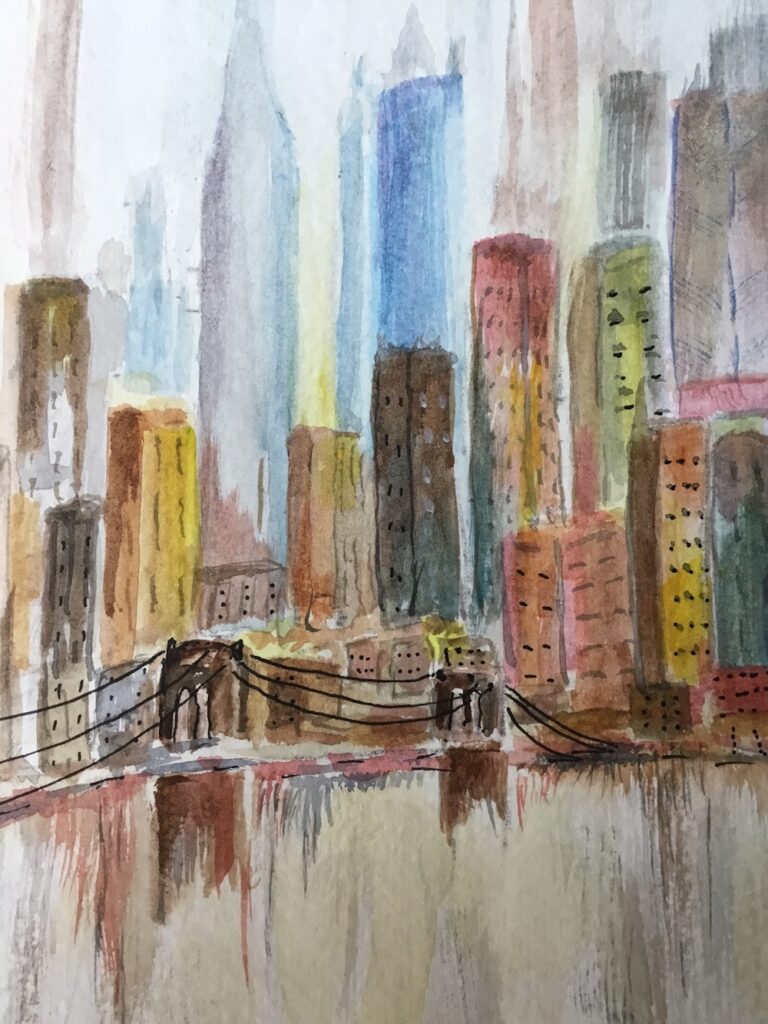
Watercolour by Ann
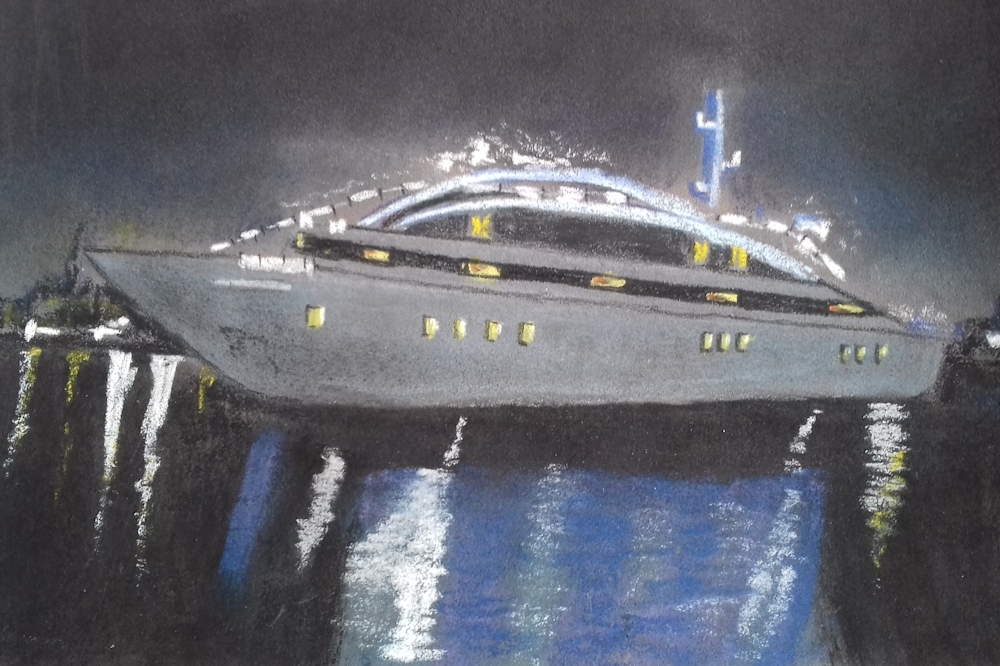
Pastel by Liz
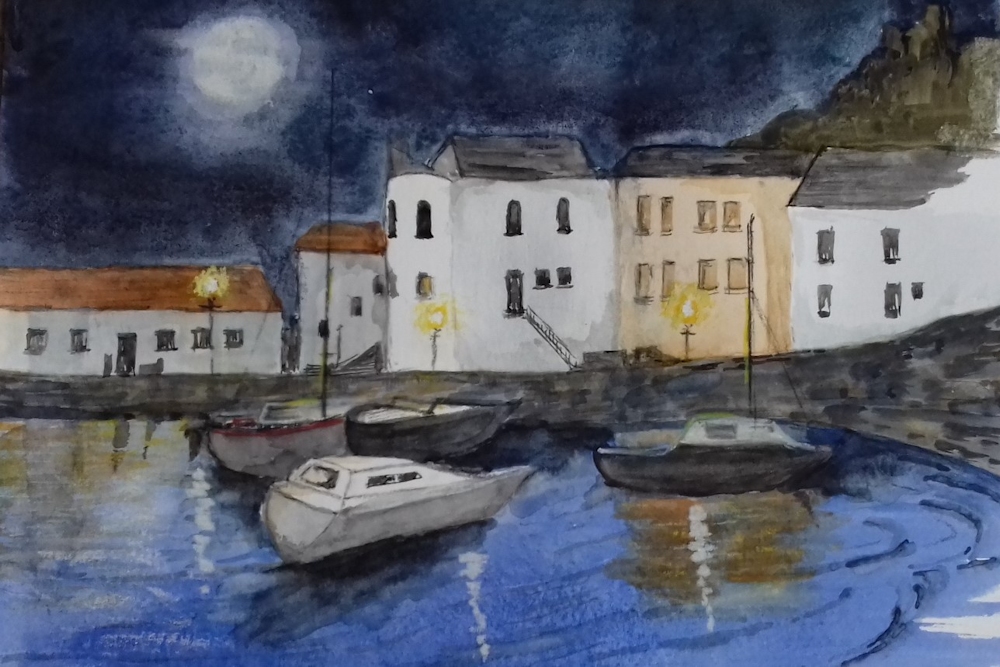
Watercolour, highlighted with pastel by Liz
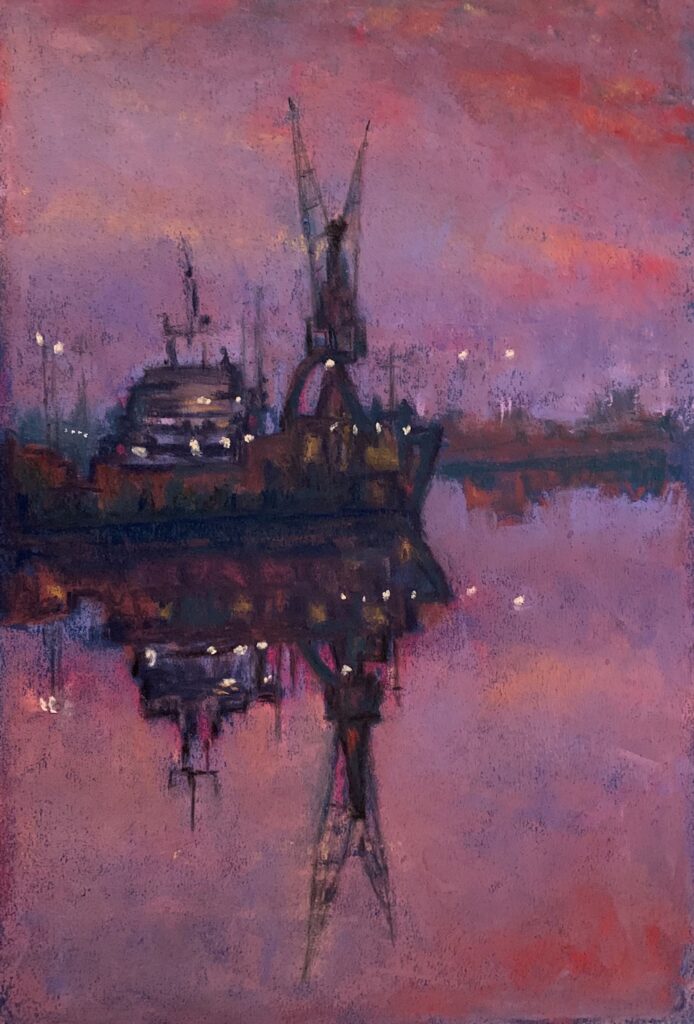
Pastel on dark blue paper by Jan
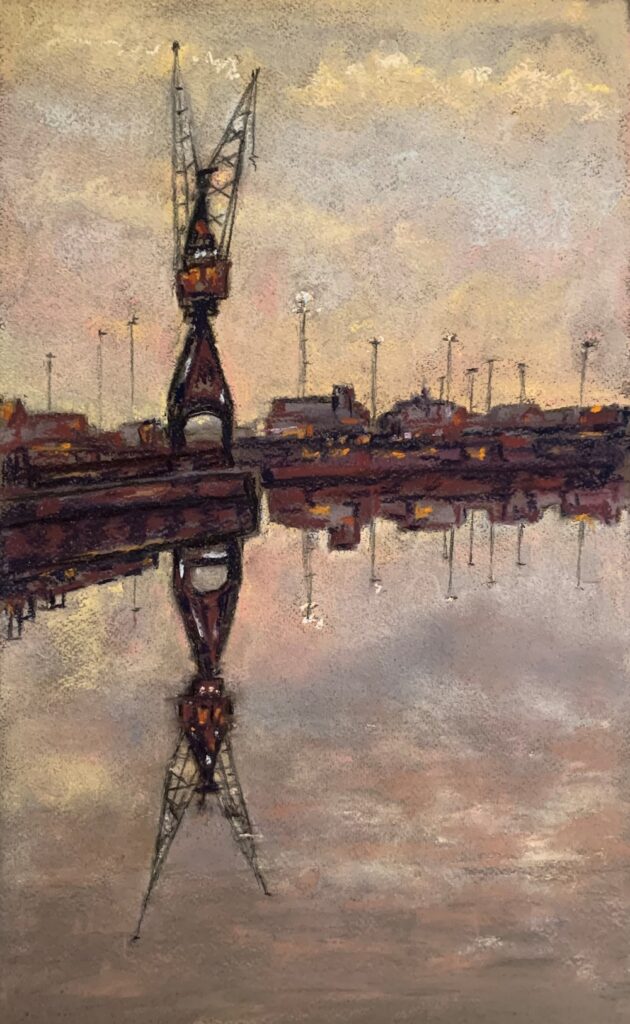
Pastel on grey paper by Jan
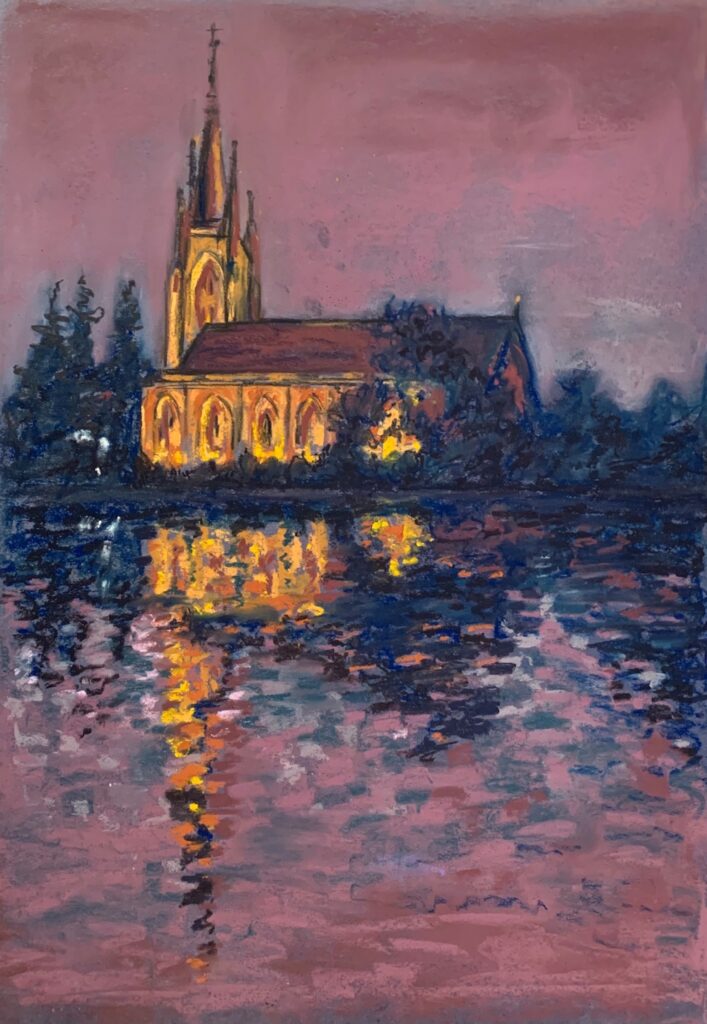
Pastel on blue grey paper by Jan
Lights in the Sky; Lights from the Land; Street and City
November 3, 2020
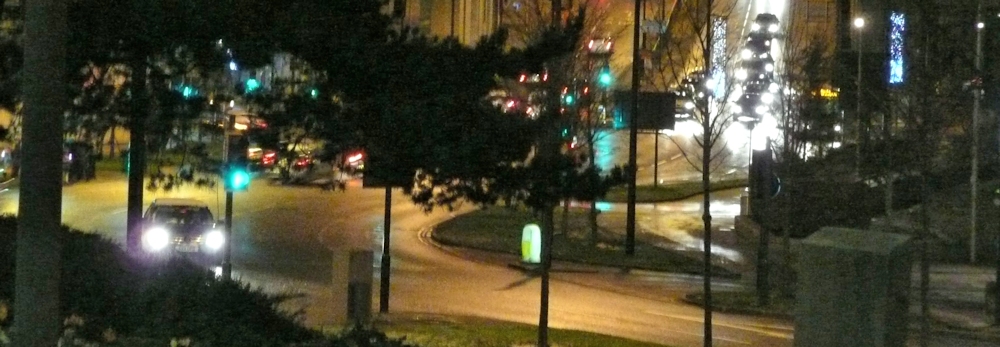
This week we’ll consider street lights and other urban lights. The principles are exactly the same as last week; huge tonal differences between the light source and its surroundings.
Last week you were invited to make a very representational painting or to use your imagination to invent a moonlit scene. This week you may consider a representational approach or look at the abstract patterns made by traffic and street lighting which would work very well in pastel on dark papers. A few ideas for working in pastel or watercolour are outlined below.
If working in pastel or opaque watercolour you may like to consider working on a dark or mid toned paper. Often street lights are on well before the light fails completely and in this case a mid toned paper may be useful enabling you to easily make some areas lighter and others darker, perhaps using the paper as one of the tones/colours in your painting.

This photo could be interpreted as an abstract pattern of lights and dark.
When using pastel and a very dark blue paper, like midnight blue or even indigo, black will make that even darker for the very deepest tones but use it sparingly. As last week you may need to place your shapes by working with a mid-toned pastel pencil before blocking them in and reserve your palest pastels for the light sources; light from windows, street lamps etc.
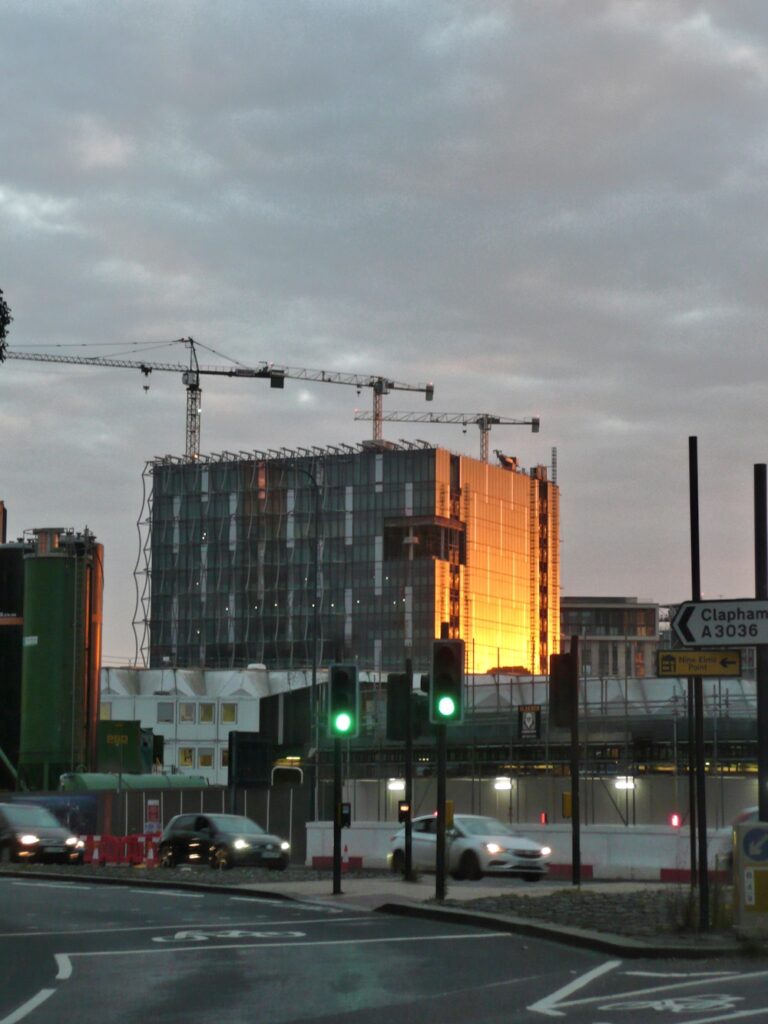
If you are working in watercolour plan out your composition so that you can either reserve the lightest and white areas by painting around them or by using masking fluid. Remember not to apply your washes till the masking is absolutely dry. Then work as you would usually working first the pale areas, then the middle and lastly the darkest washes. Your palest washes may be washed over pretty much the whole of your paper, lending unity to subsequent washes and you may like to drop in mid tone colours in some areas at this stage.
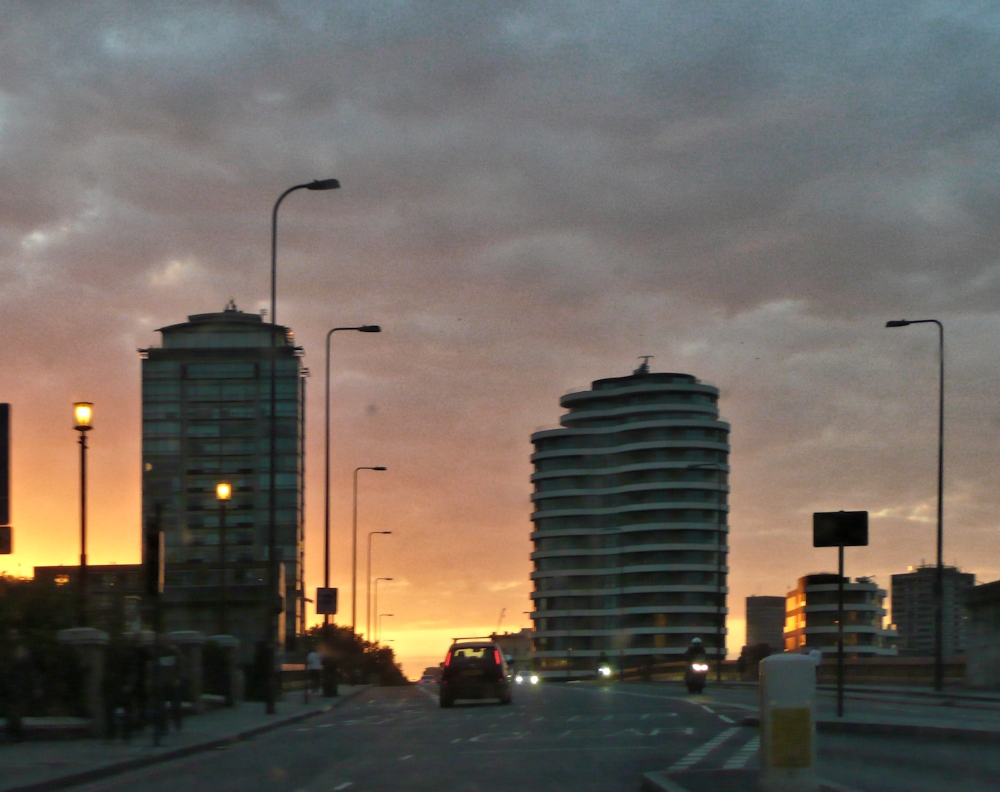
Do look at your reference carefully as there may be areas of reflected light and sharp edged shadows.
The photographic references include a dark night time scene from Bradford and some in London at twilight where the shadows are diffuse and there is less glare from each light source.
Try to avoid reflections in water this week as that will be the subject of the following week’s challenge. Stick to street lighting, traffic and car lights, shops and window lights and even cafe lighting. If you are feeling more ambitious try a floodlit building, sports stadium or building site.
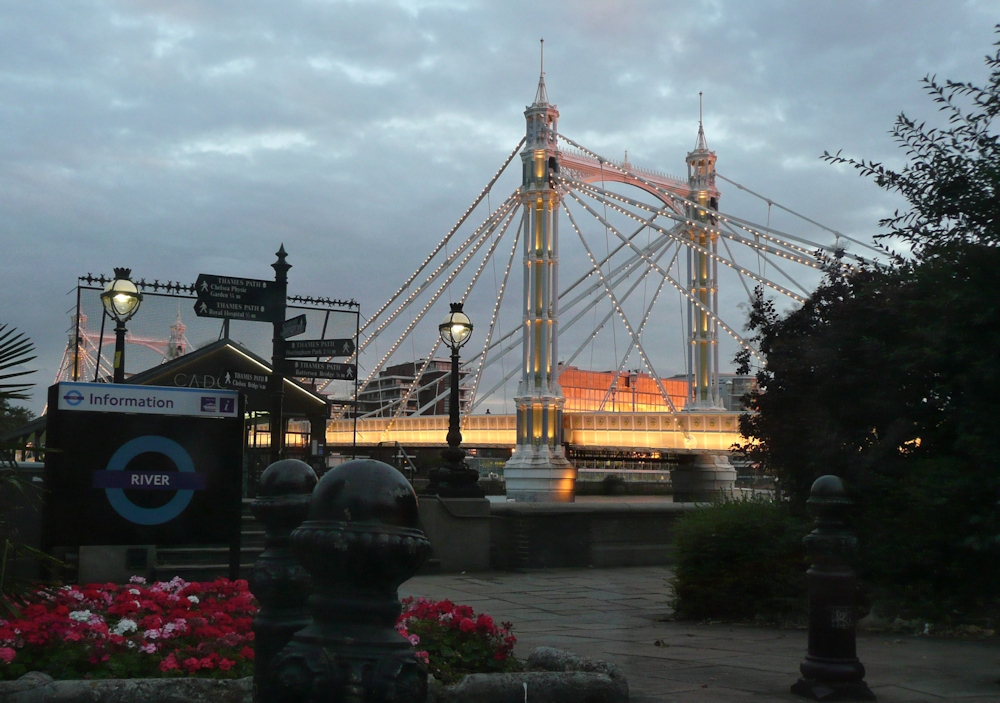
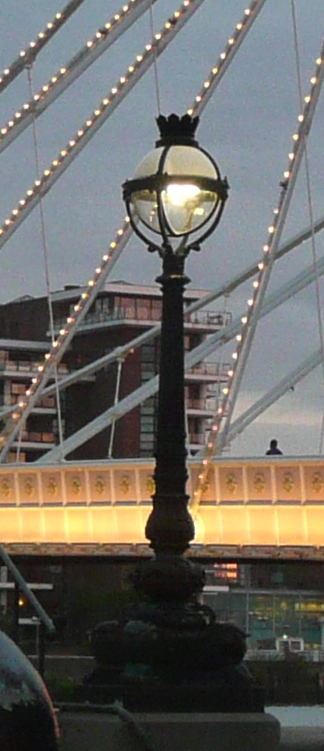
Look at how the light is emitted from the light source. It may appear as a round dazzle of light as round the sun or from a torch. It may be directed as the floodlights illuminating a building or stadium. You may even see “pools” of light on the ground.
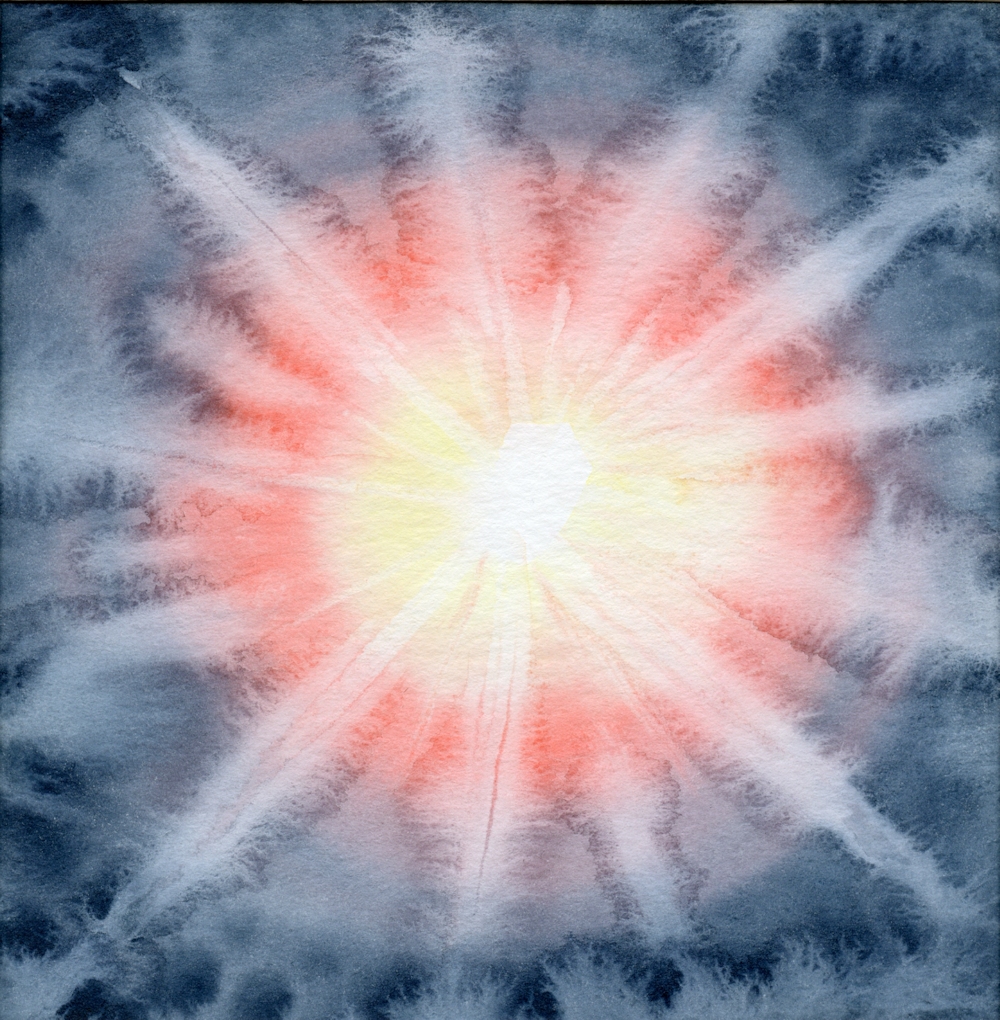
Concentric rings of wet in wet colour were lifted while wet with a small piece of dry paper towel twisted to form a point. This was dragged from the centre outwards, making creative backruns.
Hope this gives you some ideas and there are examples of how several artists have tackled this subject on the Pinterest Board link below.
https://www.pinterest.co.uk/jhall1282/lights-in-art/street-and-city-lights/
Works by John Atkinson Grimshaw, Frederick Childe -Hassam and Whistler are featured and also works by the Czech artist Jacob Schikaneder. I especially like his tramway scenes. These artists all worked over a similar period about 1890 to 1920.
Have fun and don’t forget to photograph/sketch some fireworks ready for the week 5 challenge.
Your paintings;
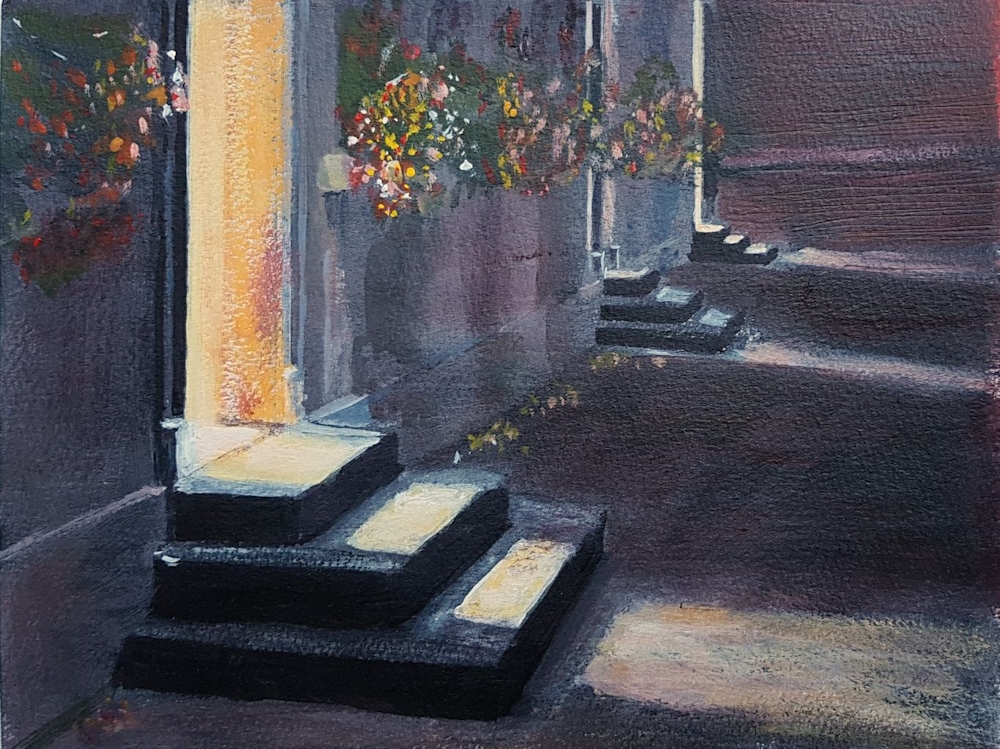
Acrylic by Malcolm
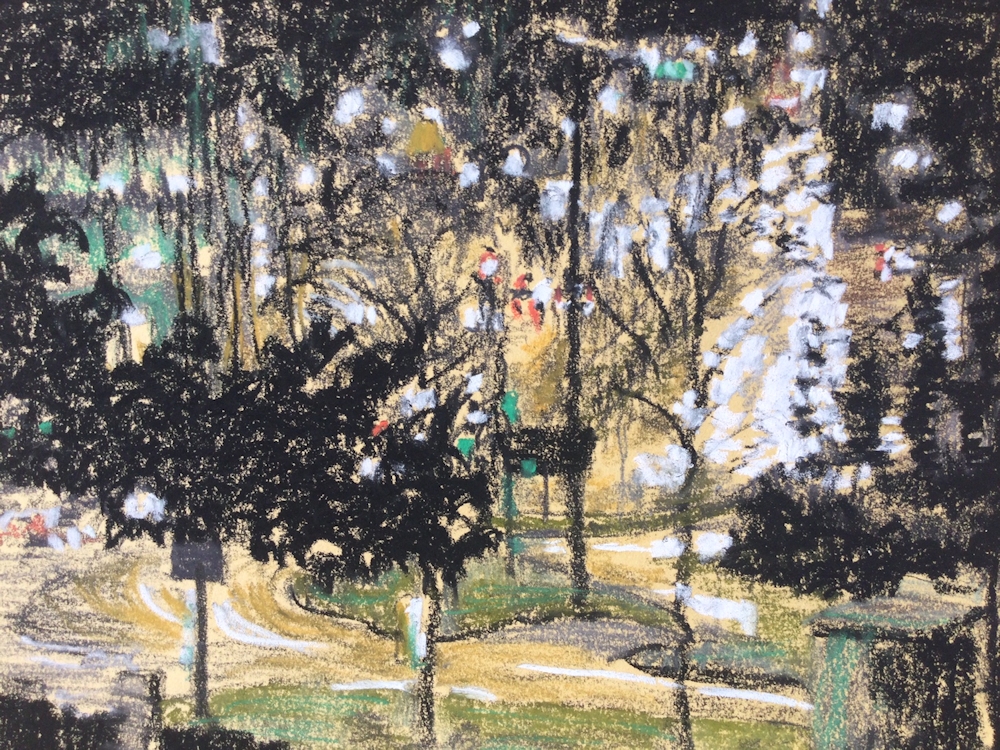
Pastel by Jane
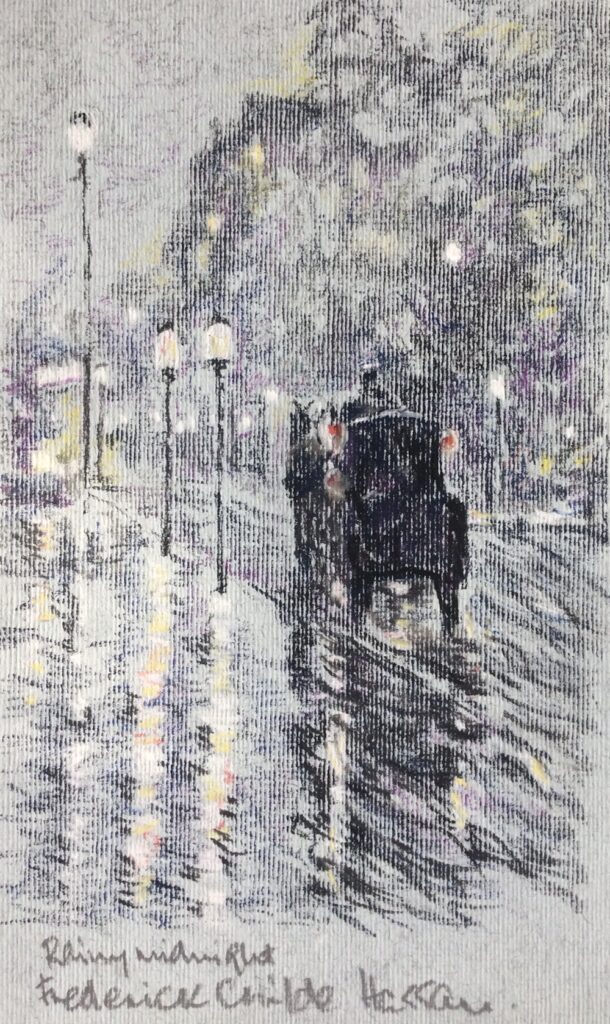
Pastel by Jane
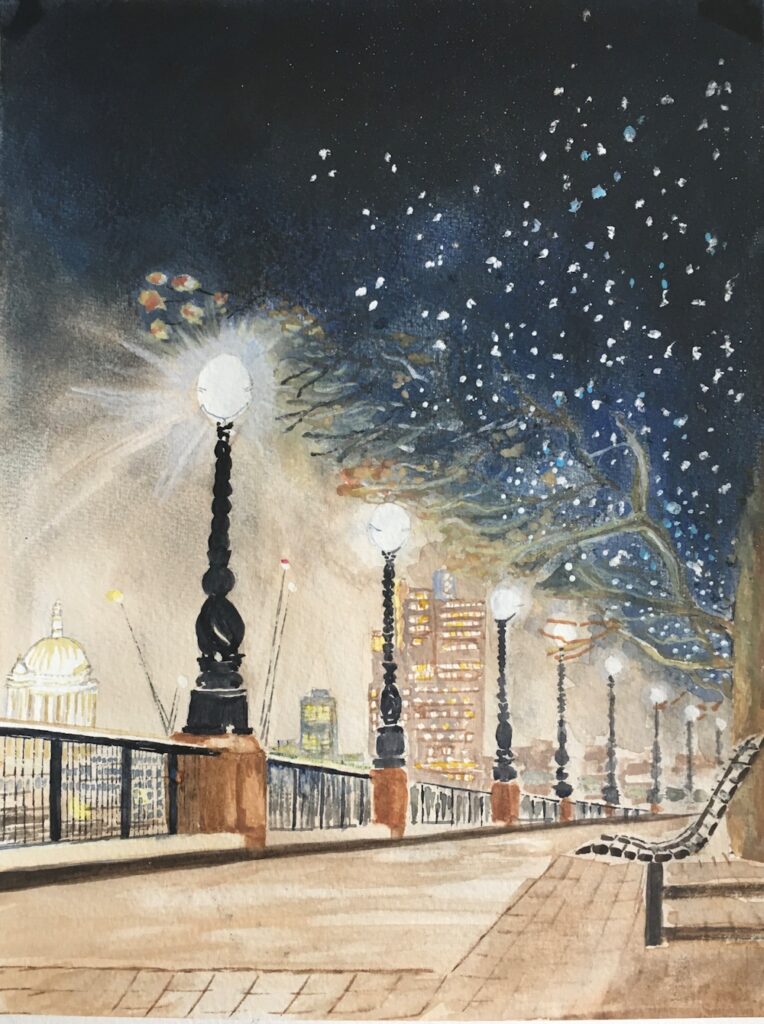
Watercolour by Heather
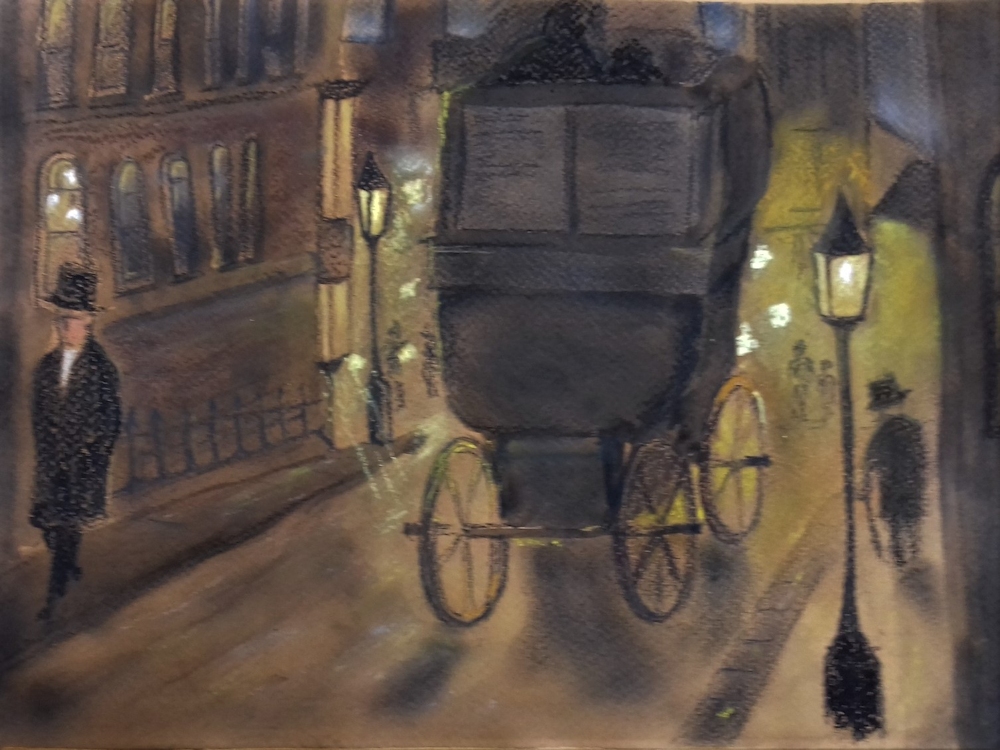
Pastel by Liz
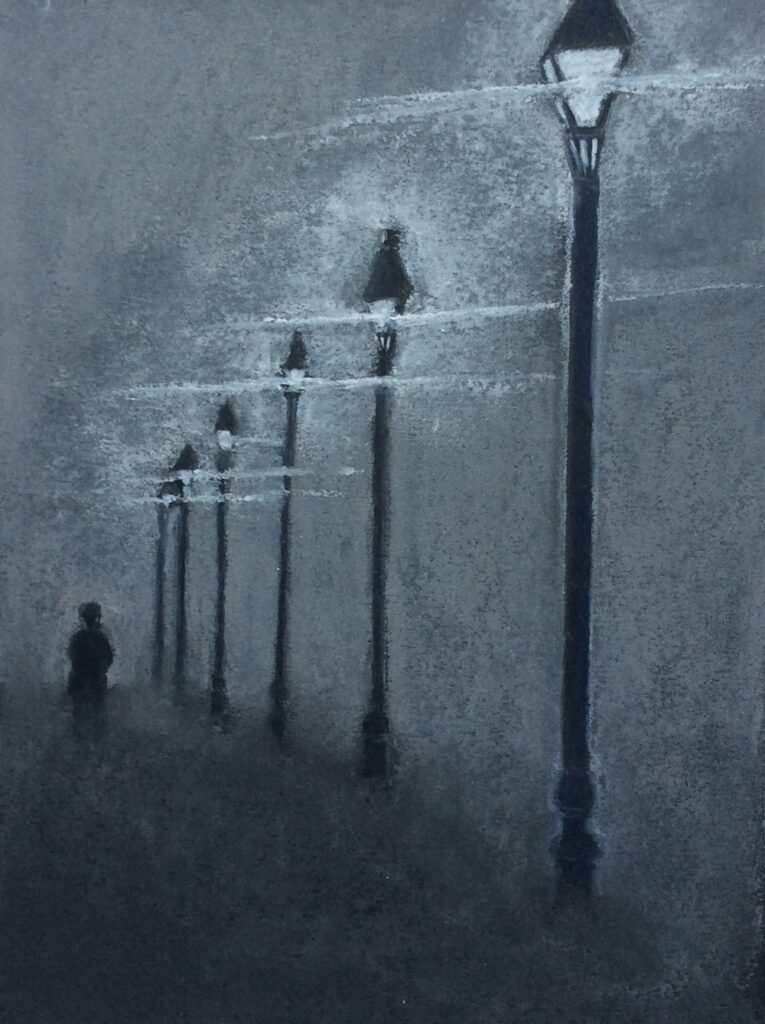
Pastel by Barbara
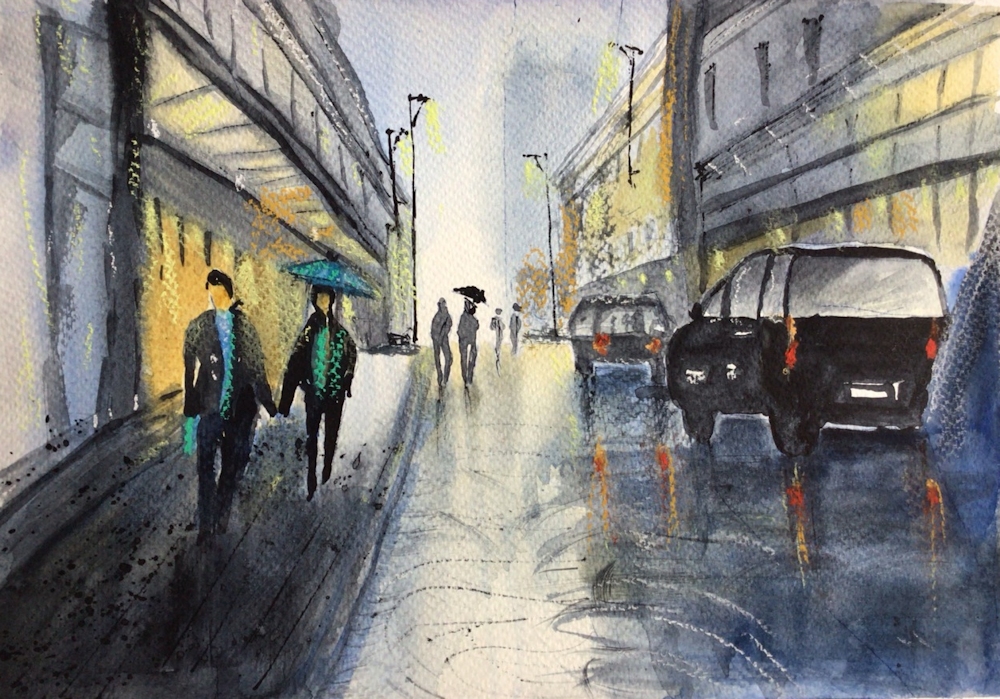
Watercolour and Pastel by Maricarmen
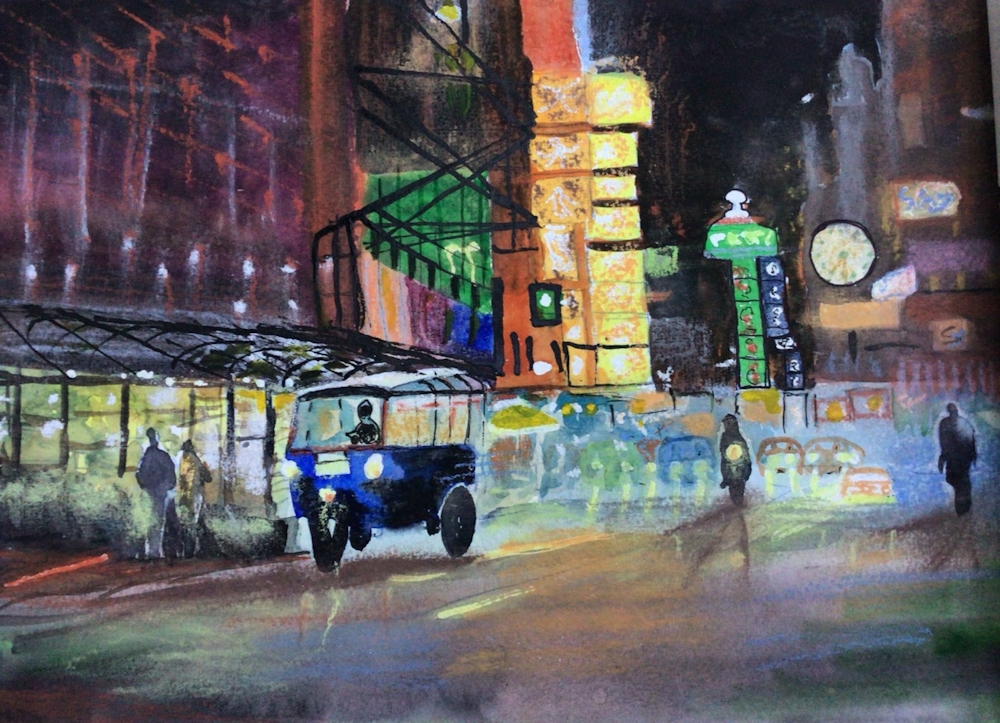
by Maricarmen
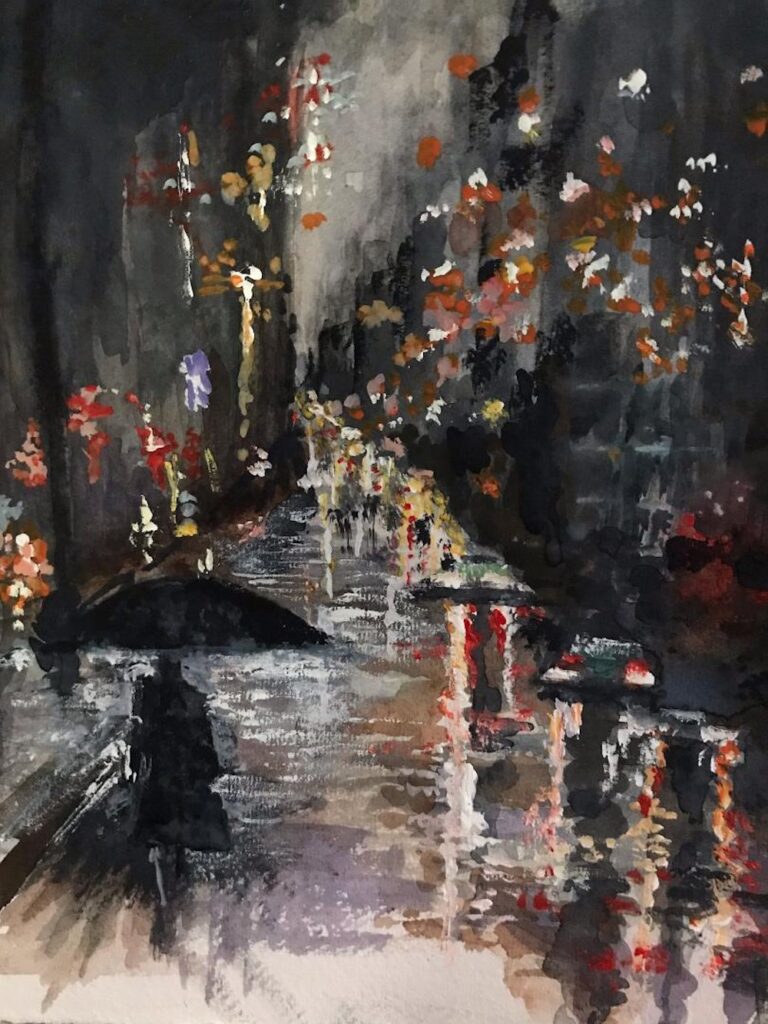
Watercolour after Chin H Shin by sarah
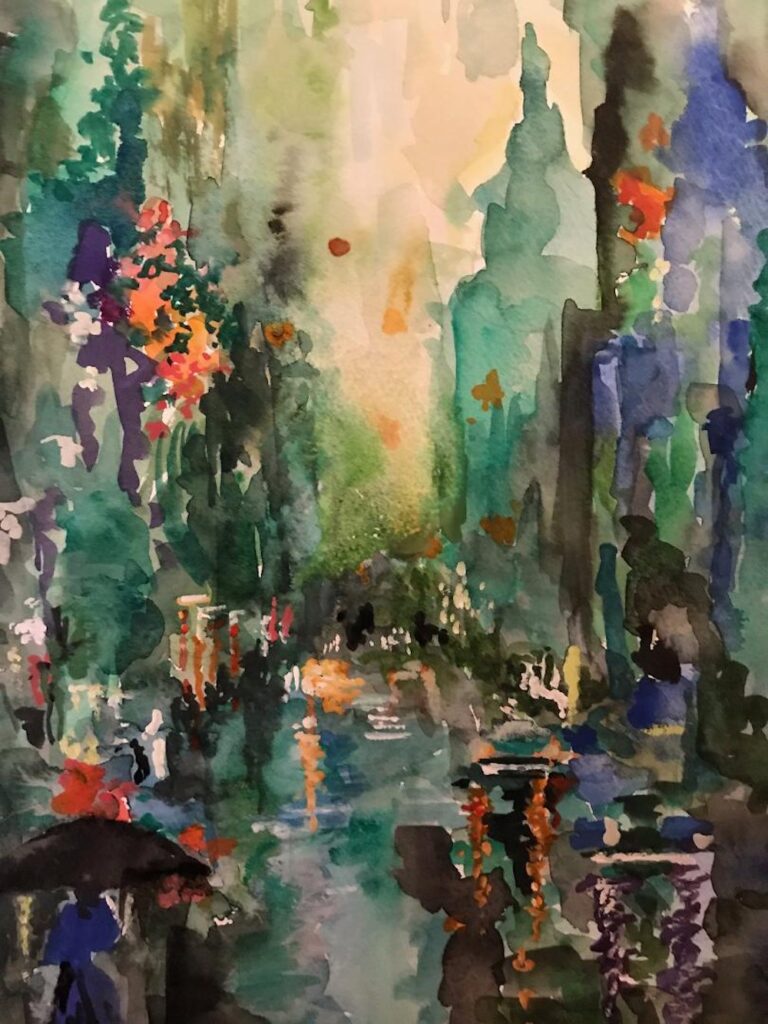
Watercolour after Chi H Shin by Sarah
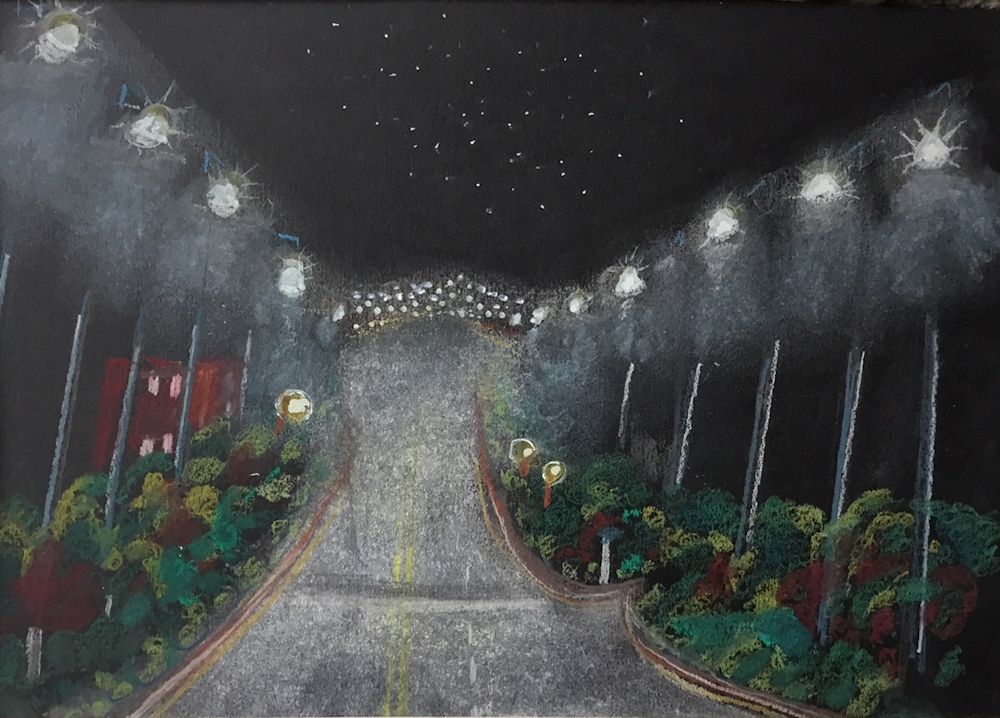
Pastel by Ann
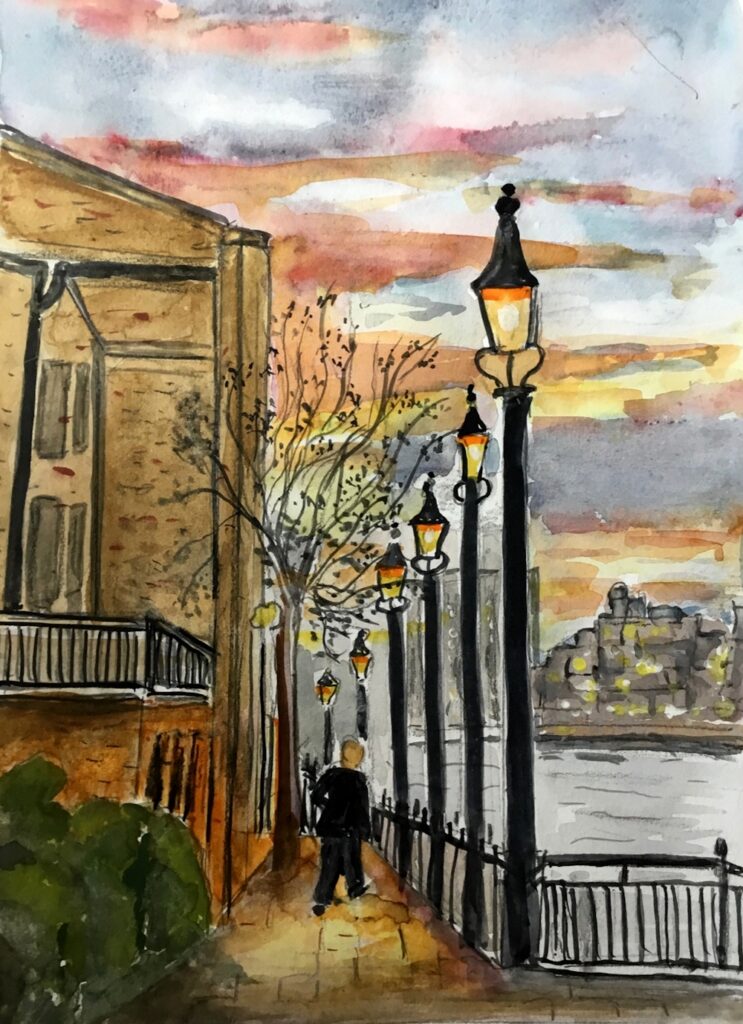
Watercolour by Ann
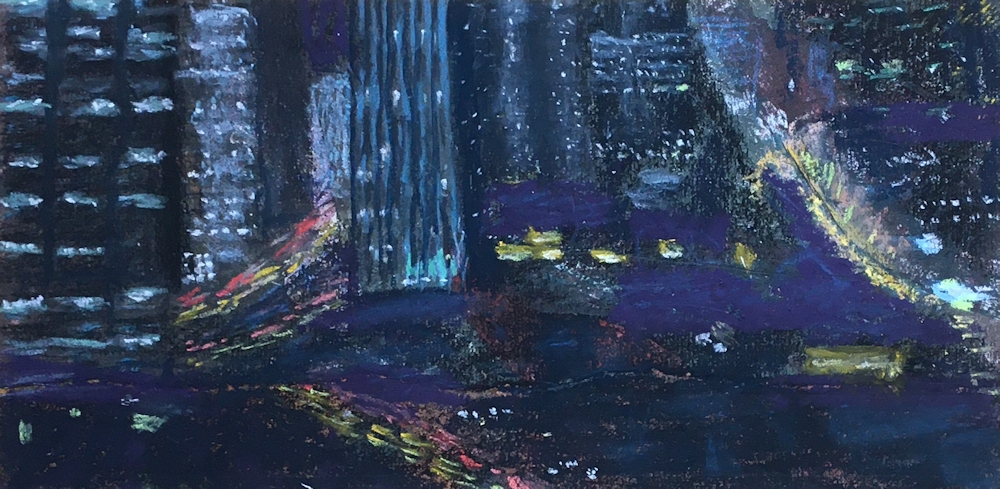
Pastel by Shirley
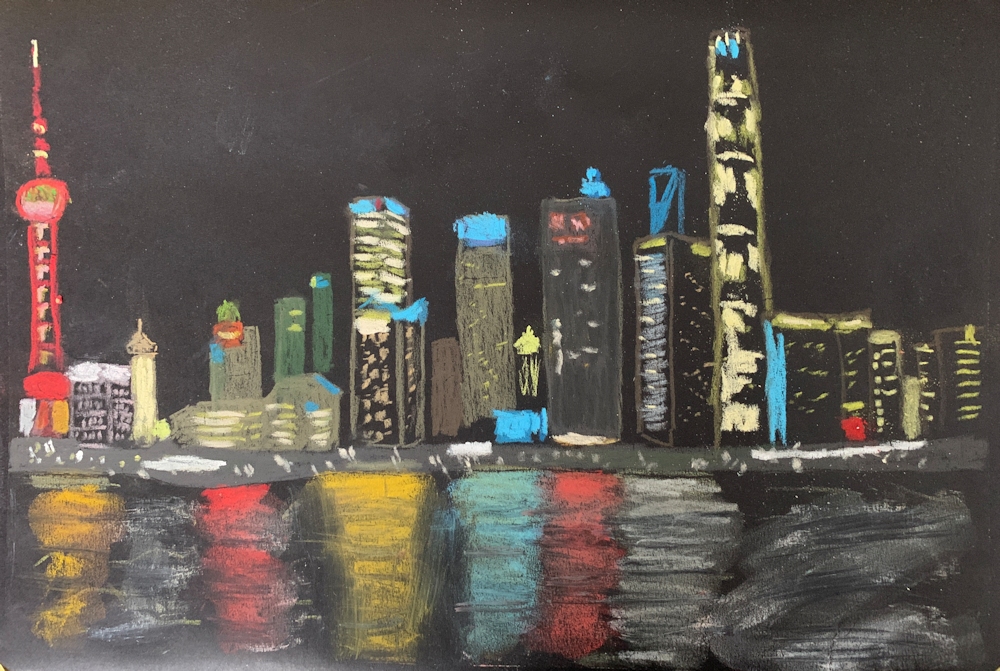
Pastel by John
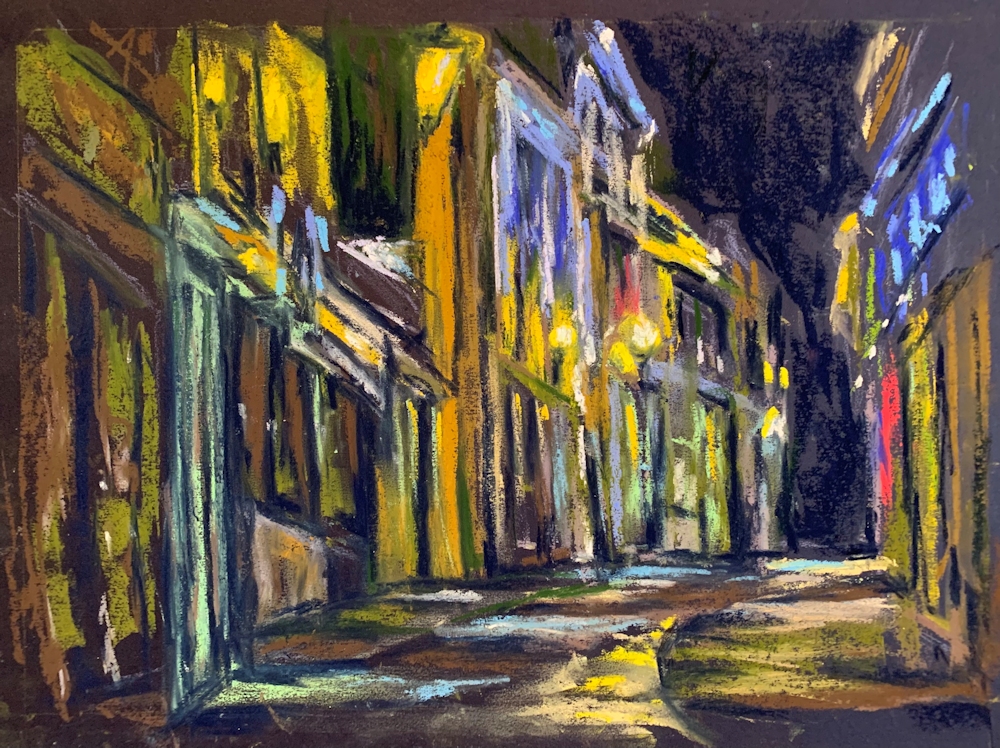
Pastel by Jan
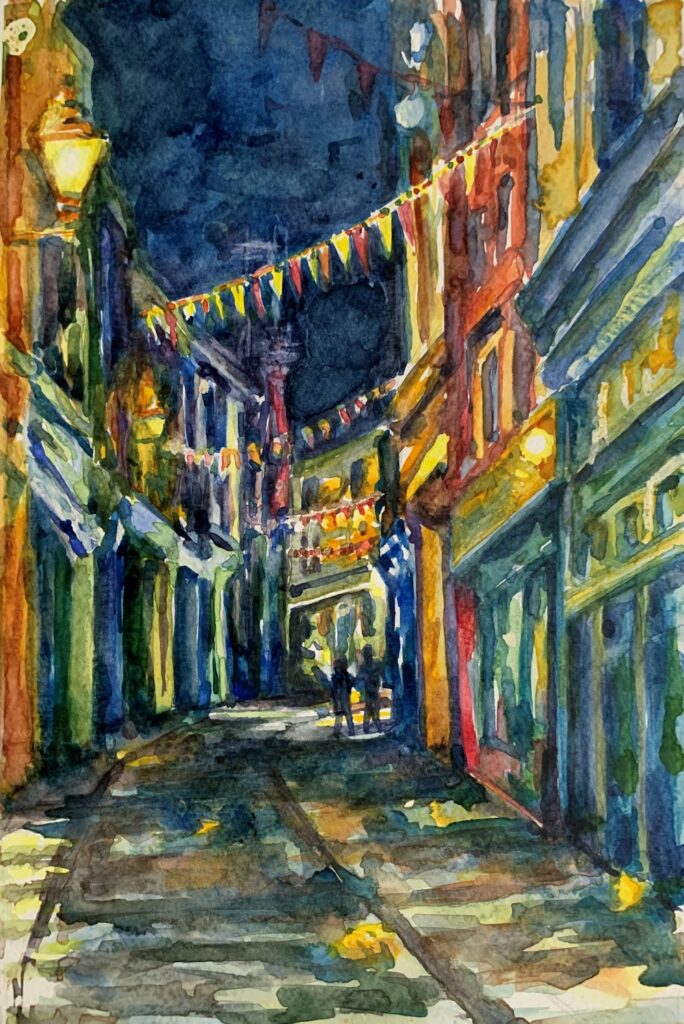
Watercolour by Jan
Lights in the Sky, Lights from the Land: Moonlight
October 27, 2020

These fields seemed like a magic staircase in the landscape so I transformed this very green daytime scene into the pale yellows and dark blue of moonlight
This week’s challenge is the moon and its effects on the landscape. You may paint an observed scene or introduce something more imaginative. The works of Turner and Samuel Palmer combine large elements of observation with imagination. Much smaller than the sun its size is often exaggerated in paintings; look at Turner’s watercolour sketch of Shields Lighthouse, 1823-26.
Several of Turner’s works together with works by Samuel Palmer and the contemporary artists John Caple and Richard Cartwright and others feature on the Pinterest Board titled Lights in the Sky, Lights from the Land, section: Moon and Stars, Link below;
https://www.pinterest.co.uk/jhall1282/lights-in-art/moon-and-stars/
Another featured artist is the Victorian artist, John Atkinson Grimshaw of whom Whistler famously remarked “I considered myself the inventor of nocturnes until I saw Grimmy’s moonlit pictures.” This is unbelievably arrogant in the face of moonlit paintings by Turner, Palmer etc. years earlier. However it is really worth studying Whistler’s nocturnes of the Thames which we’ll look at in a couple of weeks time.
The moon’s light being a mere reflection of the sun’s light is less bright, but is most often depicted during the hours of darkness, so affords huge contrasts with the darkened skies. Because of the darkness the palette used for painting moonlit scenes is generally less colourful and may be depicted in near monochrome.
This week you may work in pastel which will work very well on a dark paper, perhaps a very dark blue or even a dark burgundy colour as in the demonstration piece below. If you are working in watercolour you may choose a white paper as in the illustration above, or if you consider working in gouache, or white added to your watercolours, again you may like to choose a dark paper. Pastel papers can be stretched in the same way as watercolour paper, or you could work in gouache on an off cut of mount board.
The images below show stages in creating a moonlit landscape based loosely on the Eden valley in Northumberland.



Below are a few suggestions for painting the moon in watercolour.




Whatever your medium, compared with the sun the moon is a tiny object though it appears a good size from earth because of its proximity. It sheds a much paler silvery light on the landscape which is very different from the vast range of hues revealed by direct sunlight.
Your challenge for this week is to paint a picture of a moonlit landscape with the moon visible in the night sky. This may take the form of a very imaginative scene as in the works of John Caple or Richard Cartwight or something more literal. Have fun!
Your paintings:

Pastel by Barbara

Soft pastel and oil pastel on dark blue pastel paper
Oil pastel touches were added for the snow in the foreground.

Pastel on dark grey Pastelmat

Pastel

Pastel by Heather

Watercolour by Heather

Watercolour

Watercolour by Jan

Watercolour by Jan

Pastel by Jan

Pastel on buff paper by Shirley

Pastel on print making paper by Shirley

Watercolour by Maricarmen

Gouache on black paper by Maricarmen

Acrylic and pastel

Pastel pencil and pastel

Watercolour and pastel

Watercolour and pastel
Lights from the Sky, Lights from the Land: The Sun
October 20, 2020
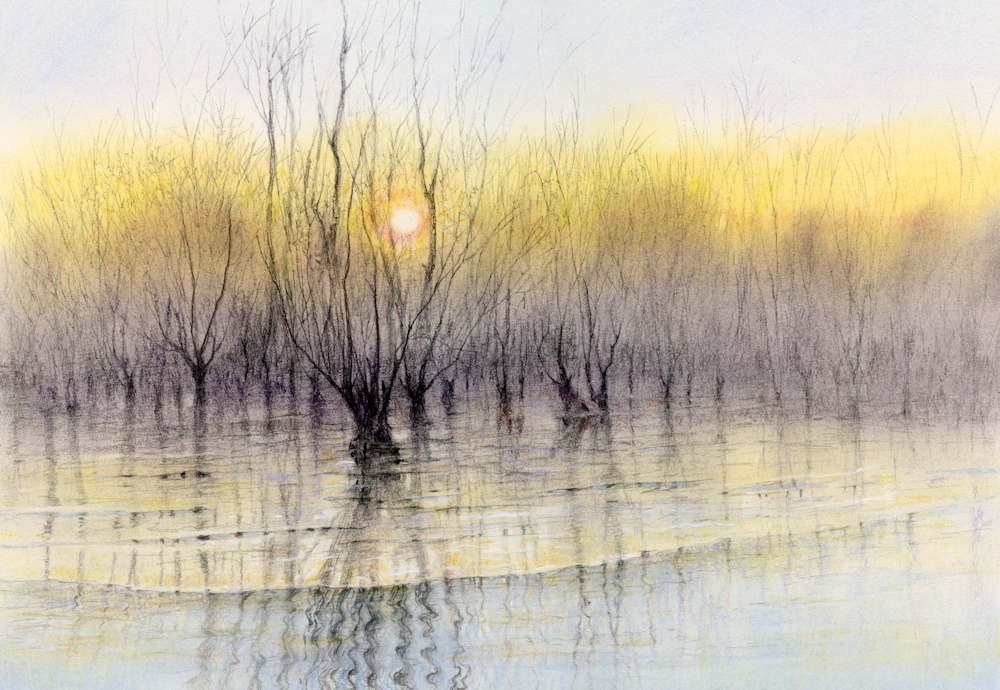
This week’s project is to depict the sun and effects of its luminosity on the landscape. As light sources, natural and manufactured are the topics for the next few weeks, I thought it would be useful to consider some general aspects of depicting luminosity.
Light sources vary in the colours they emit; some have haloes of different colours surrounding a white or paler coloured centre and others are single hued with a near white highlight at the centre. During the next few weeks we will discover some of these differences in more detail.
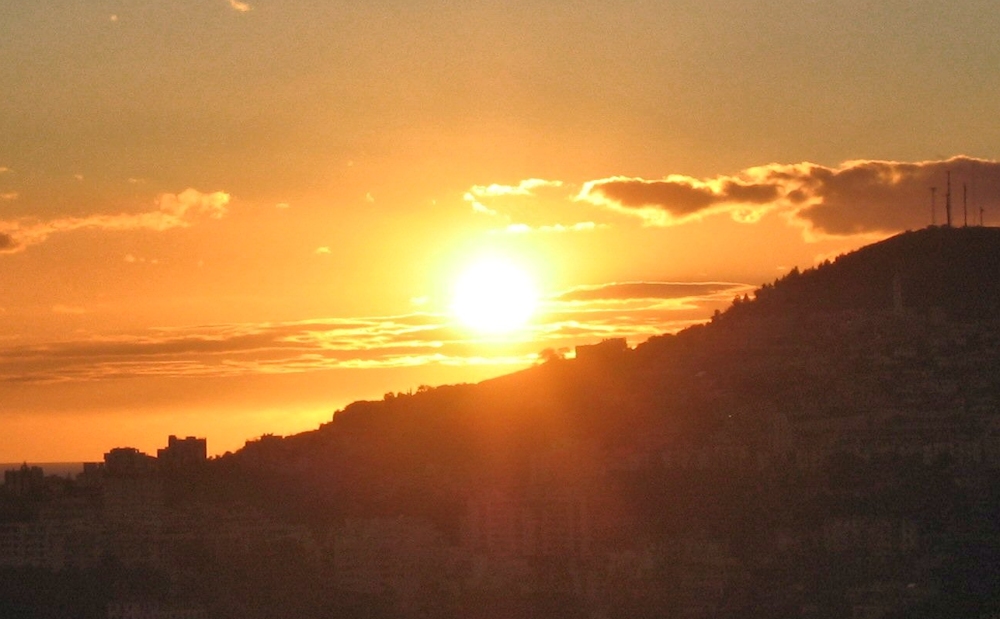
Guidelines for creating luminosity in a composition
(Some of this is rather obvious but here goes!)
1. The luminous area should be smaller than its surroundings.
2. The luminous area should be painted in paler tones than its surroundings and the highlight will be the palest tone.
3. Within the brightest part of the luminous area none of the tonal values should contrast with each other greatly. Deeper values should be painted outside this area although there may be different colours of medium tonal value outside the brightest part of the luminous area.
4. A sheen of the colours within and just outside the luminous area often pervades the entire composition. The Impressionists made great use of these effects. This can be seen in Monet’s paintings of the Houses of Parliament and the Waterloo Bridge series. The hues just outside the main illuminated feature and to a lesser extent those within the illuminated area are seen as echoes in streaks and dashes of paint, the colours that create a sheen over the surroundings area, giving the work colour unity as in the rather rough illustration below.
A link to the Pinterest board “Lights in Art” is below and you will find images of the works referenced as well as several other examples of how artists have depicted the sun and sunlight.
https://www.pinterest.co.uk/jhall1282/lights-in-art/sun/
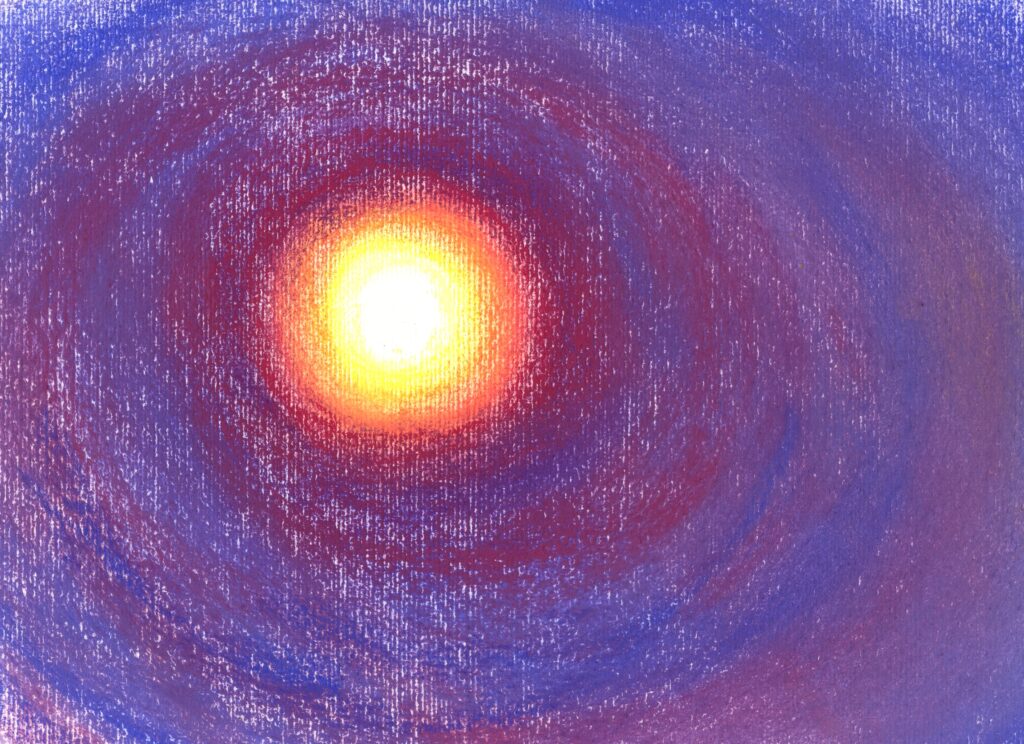
White surrounded by yellow, orange, red and purple rings; the blue surround has been streaked with mixes of the purplish red. Compare with how Monet used orange/red/purple hues in his Houses of Parliament paintings of around 1904.
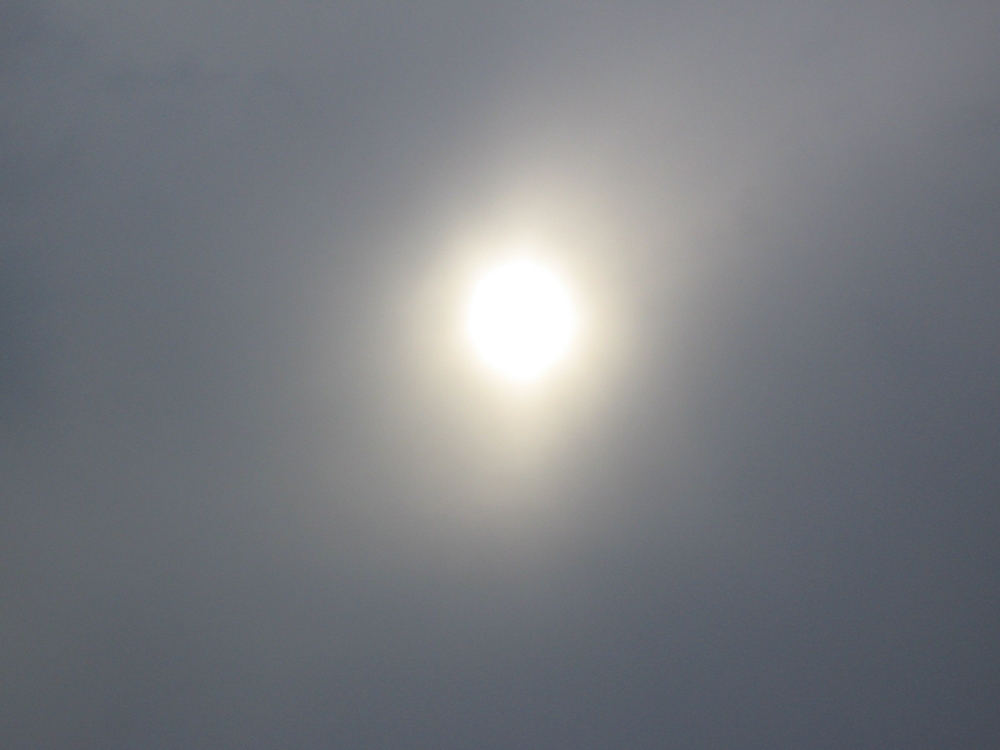
Note: white centre surrounded by less saturated (less pure) yellows and oranges than in the sunset photograph.
This sun is more like the sun in Martin Johnson Heade’s painting of “Sun over York Harbour, Maine USA”.
Colours
Luminosity may be achieved with neutral greys simply by surrounding a small white circle with rings of increasingly darker pale greys on a background of a much darker grey, or with single hue by doing the same but with a colour instead of grey.
Luminosity can also be achieved by using several hues e.g. white surrounded by yellow, then red and other colours but again choosing a darker hue for the wider area surrounding the light source.
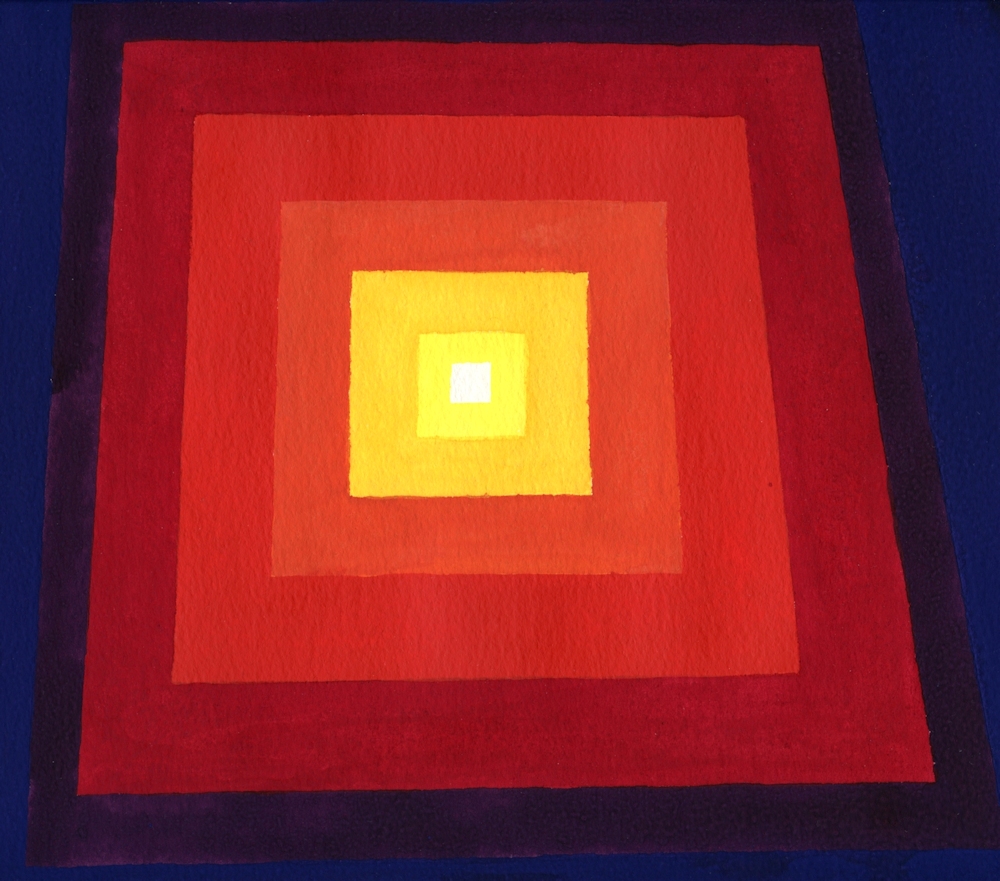
Even a white square can appear luminous!
Look at the other colours and whether they appear more or less luminous against each other.
Another way of using colour is to surround a saturated colour (pure hue) with less saturated colours or the complement of the pure hue at the centre. Again it usually works best if the surrounding hues are similar tonally or darker than the luminous area.
A good example of a pure colour being surrounded by a less saturated near complementary colour is afforded by “Impression Sunrise”, 1872 by Monet. The sun is painted as a small disc of a rather pure orange against a rather desaturated(less pure) purple cloud. The reflection of the sun is painted clearly in the water and throughout the work echoes of the orange can be seen among the purples and chromatic(coloured) grays of the rest of the composition giving the impression of the sun’s light giving a sheen over the whole work.
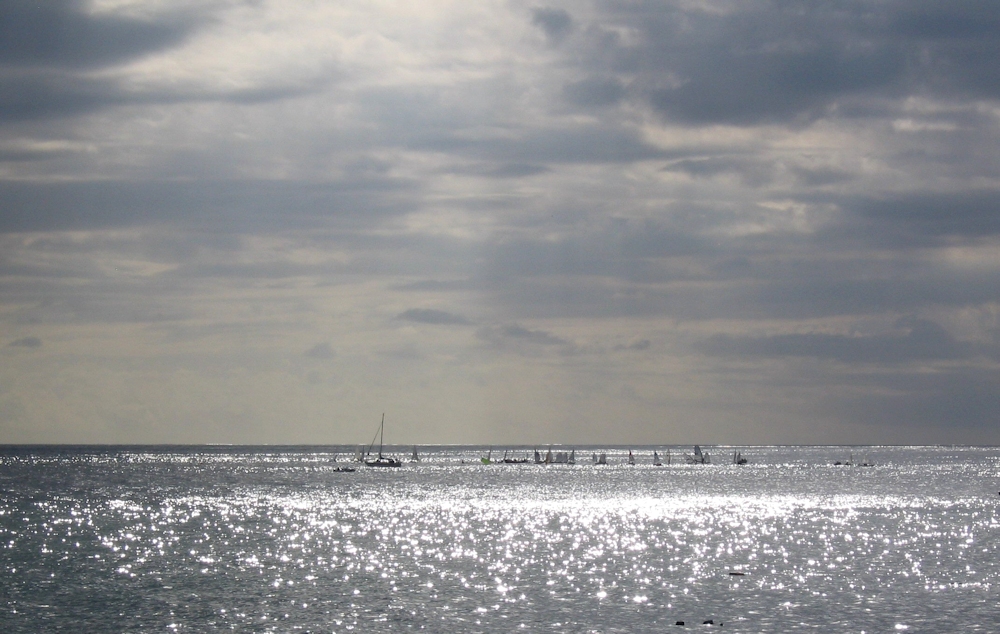
Note rather monochrome sparkle
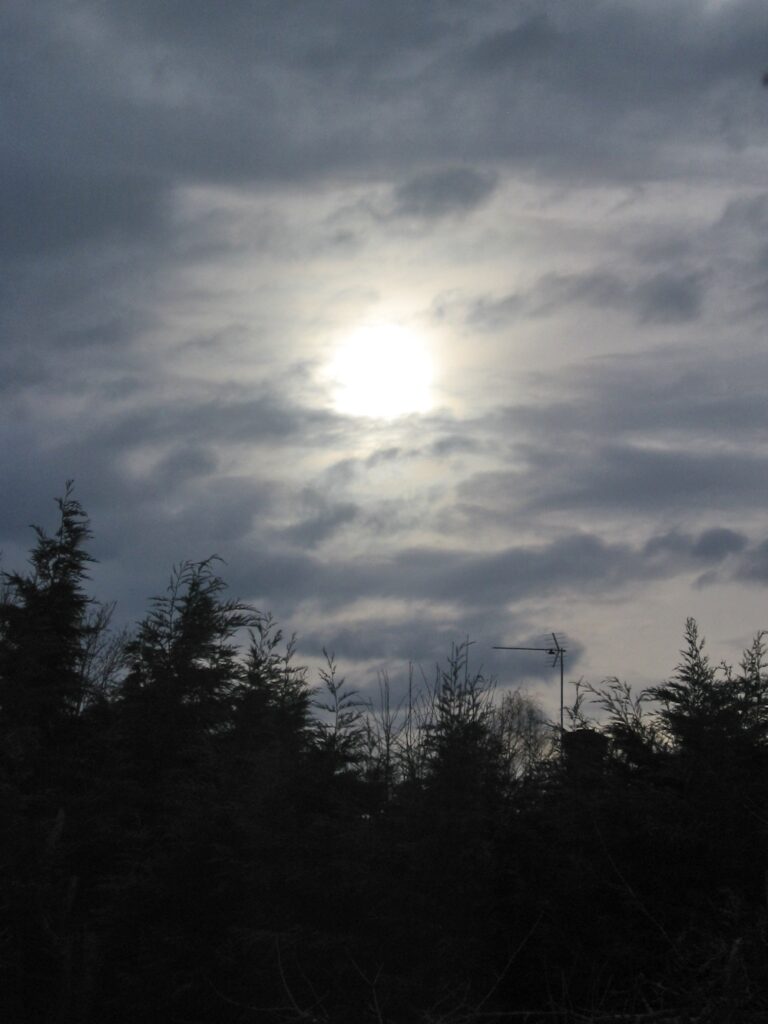
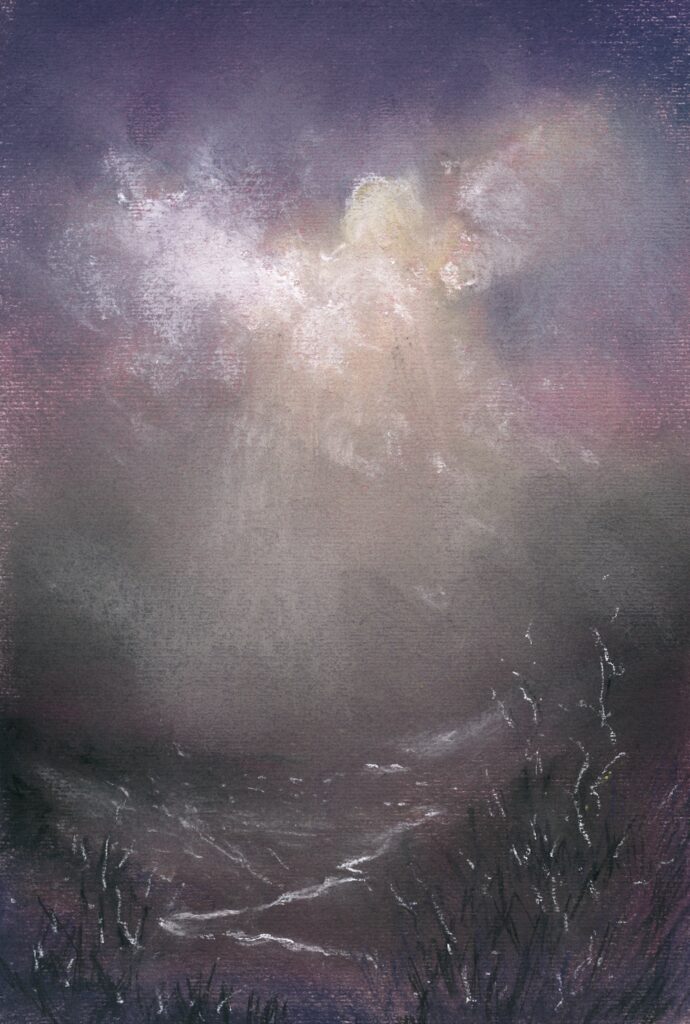
Sunlight bursting through a gap in the cloud cover and illuminating the river below.
It is of course almost impossible to depict the sun on a bright day with hardly a cloud in the sky. This is probably why most paintings of the sun involve sunsets and sunrises, or the sun in overcast conditions; its light pouring through the gaps between the clouds. Another way in which the brightness of the sun is depicted is it’s reflection in water; either as a sparkle or as a reflection of the whole sun.
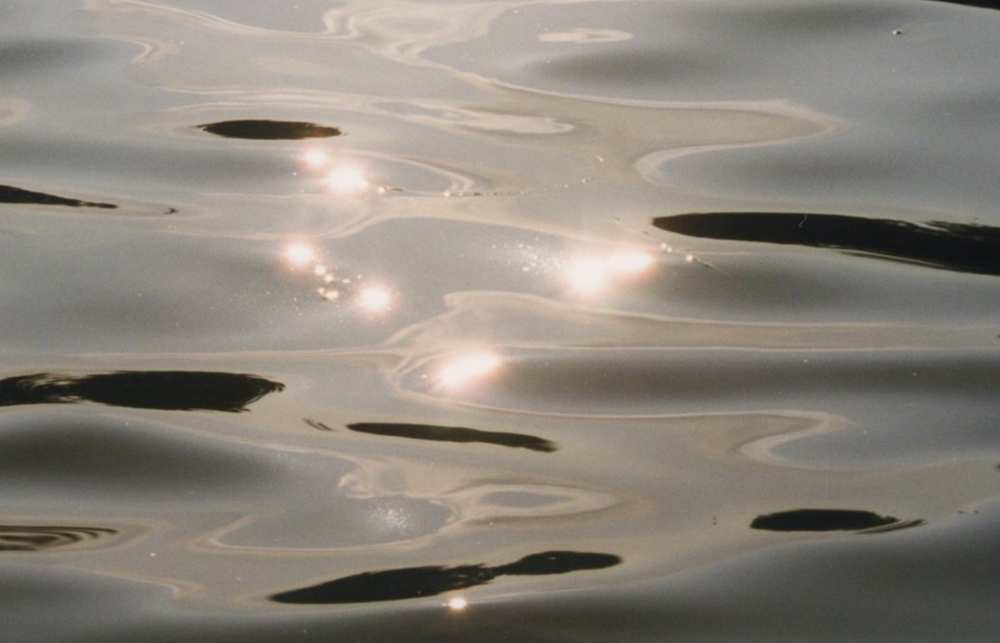
Each sparkle appears as a miniature reflection of the sun
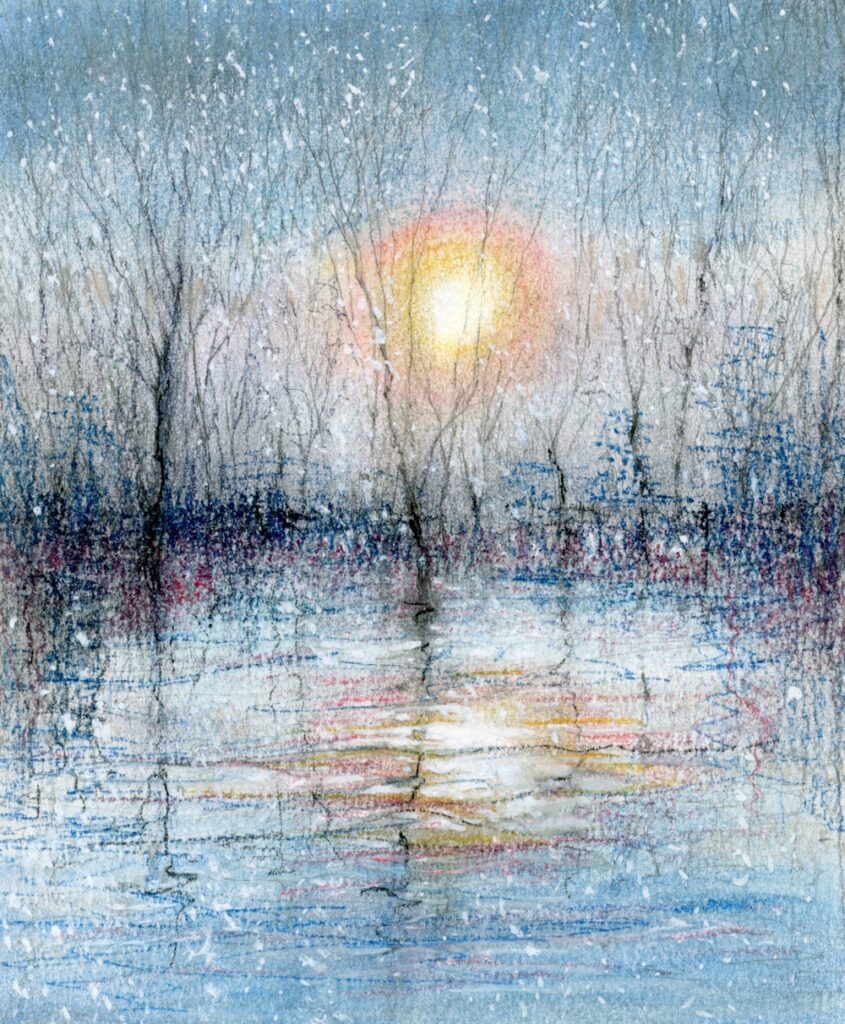
Even on the dullest day the sun appears white at the centre surrounded by a ring of pale yellow. At sunset the sun may appear white or yellow at the centre and surrounded by red orange colours or the whole sun may appear bright orange/red. The duller the day the more monochrome it appears and the sun’s reflection in water behaves in the same way.
For more ideas do visit the Pinterest Board link below.
https://www.pinterest.co.uk/jhall1282/lights-in-art/sun/
Practical
1. Experiment with making a small area look luminous using one hue and then with several hues.
2. Using pastel or watercolour or a watercolour/pastel combination make a painting where the sun is evident in the sky and may also include a reflection of the sun. The reflection may appear as the reflection of the whole sun or as a sparkle on the water.
The weather is up to you!
You may like to work your own version of one of the images on the Pinterest board, or use your own reference/imagination.
Have fun!
Your paintings:
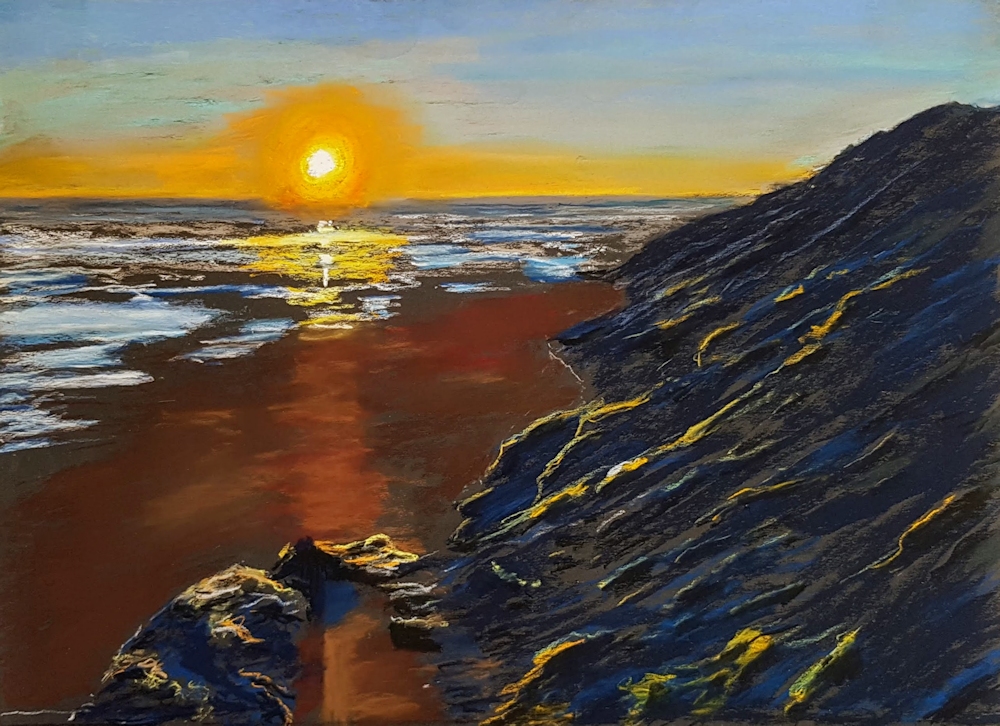
Pastel and pastel pencils on black emery paper P800 grit
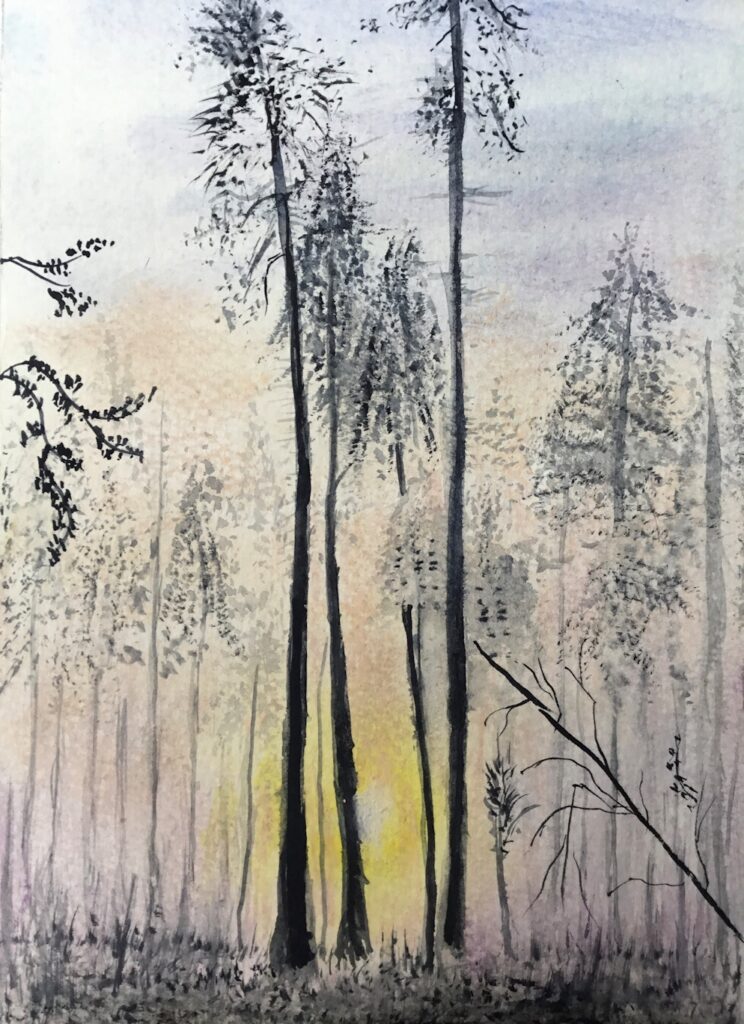
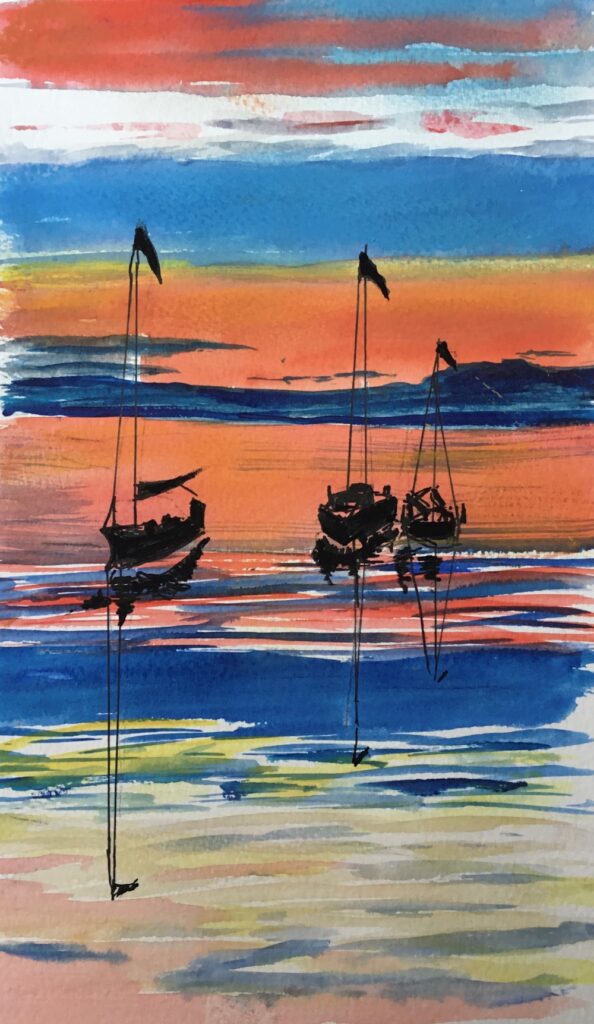
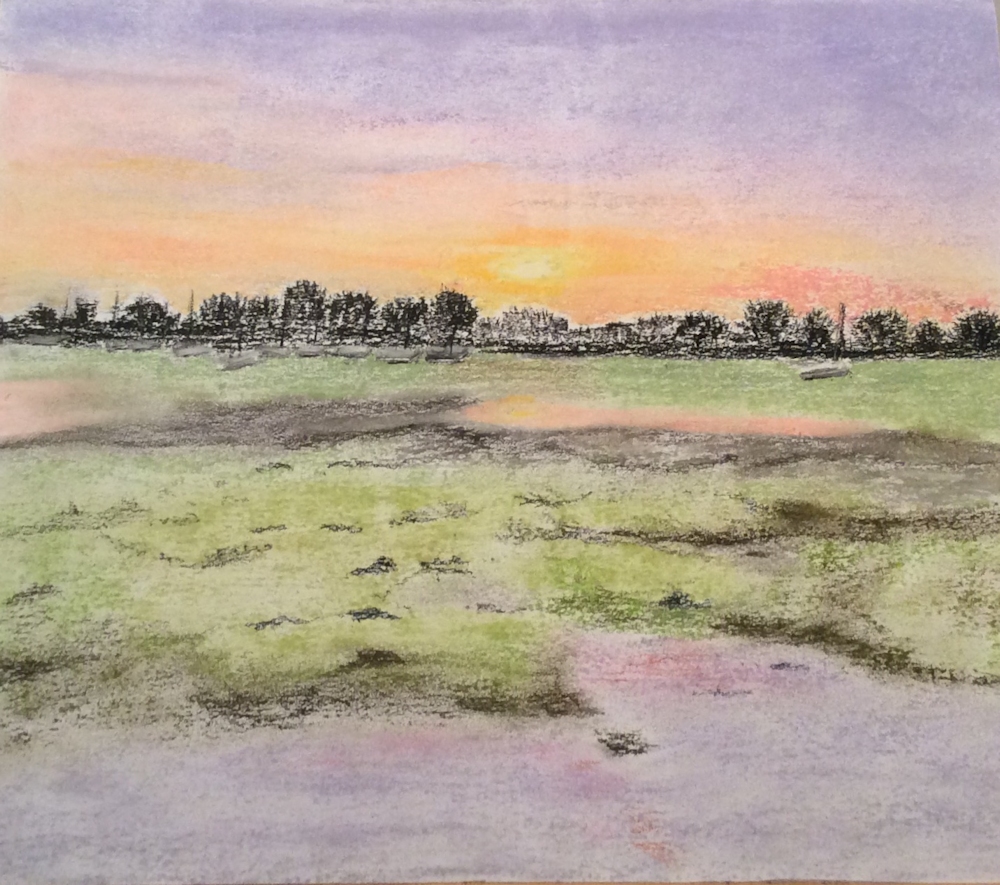
Pastel by Barbara
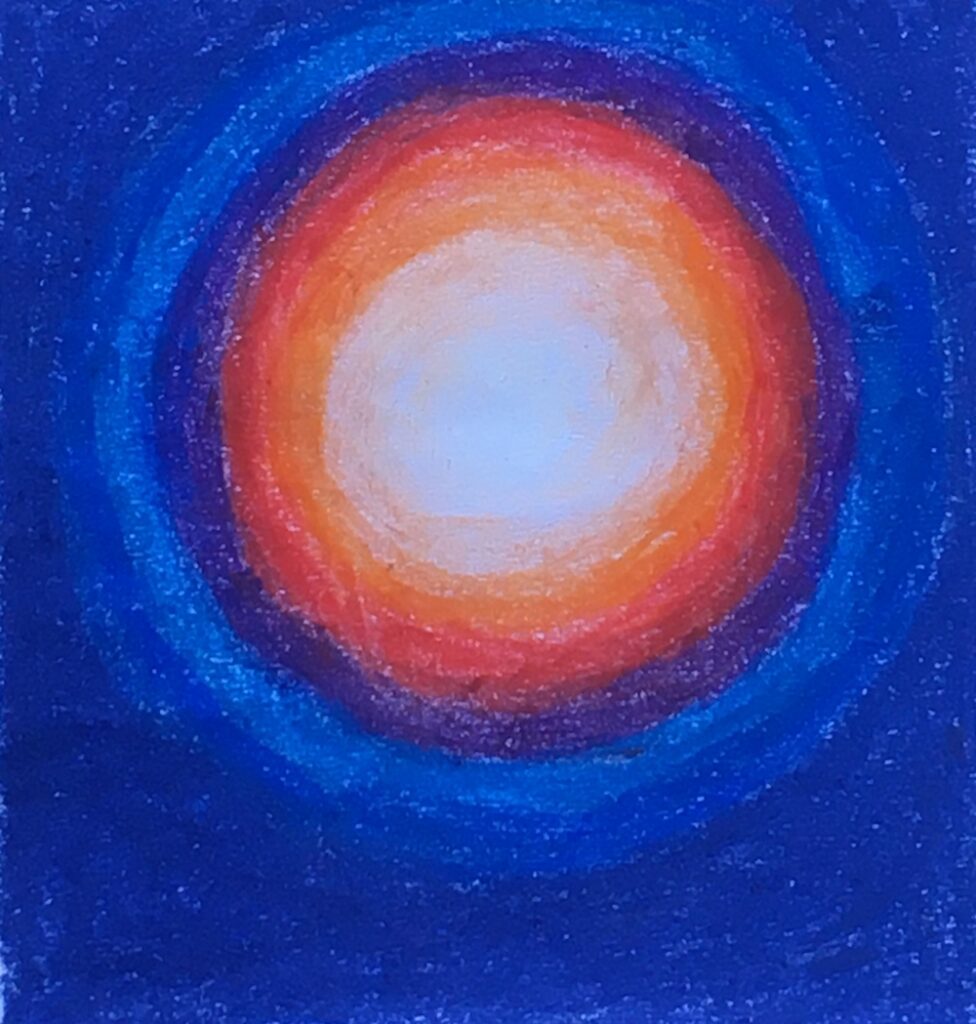
Pastel
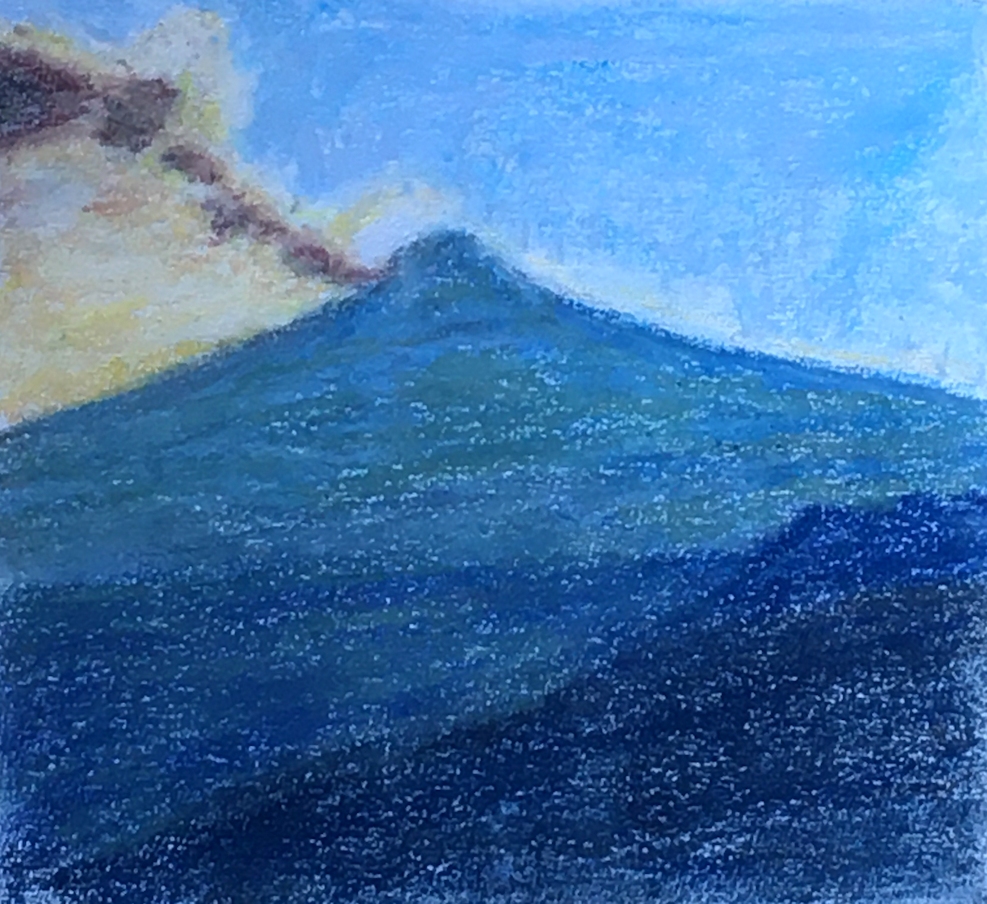
Pastel by Shirley
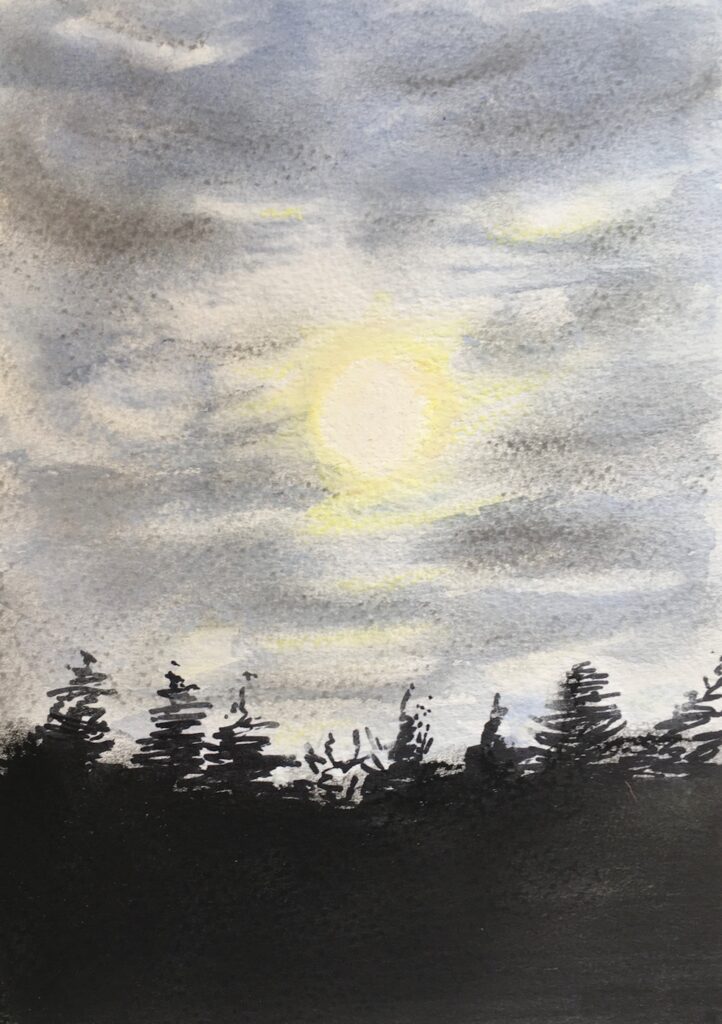
Watercolour, Sharpie Pen and Pastel
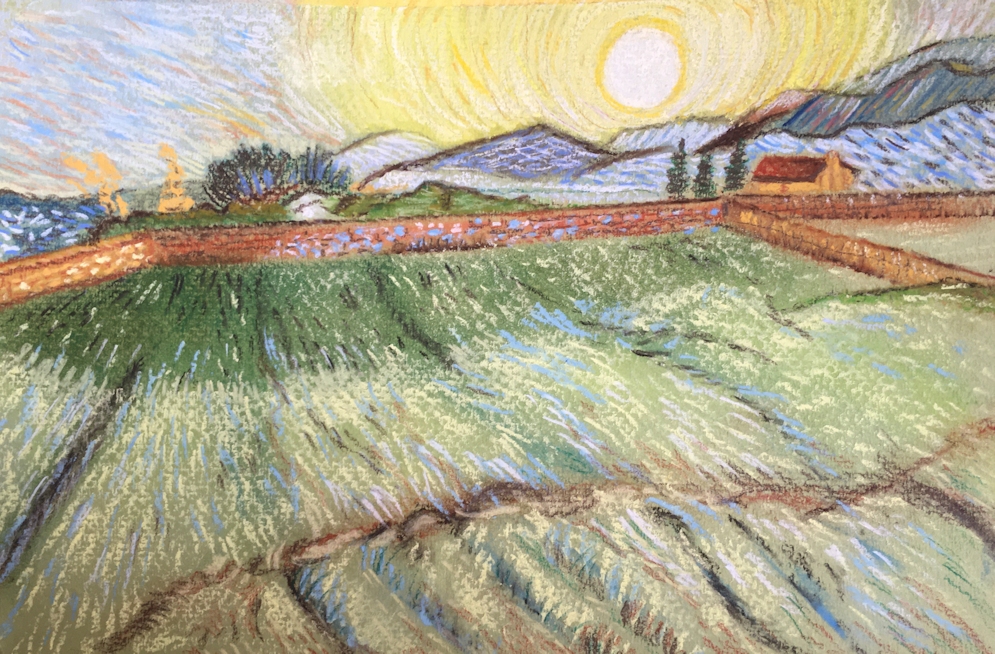
Pastel and a little Coloured Pencil
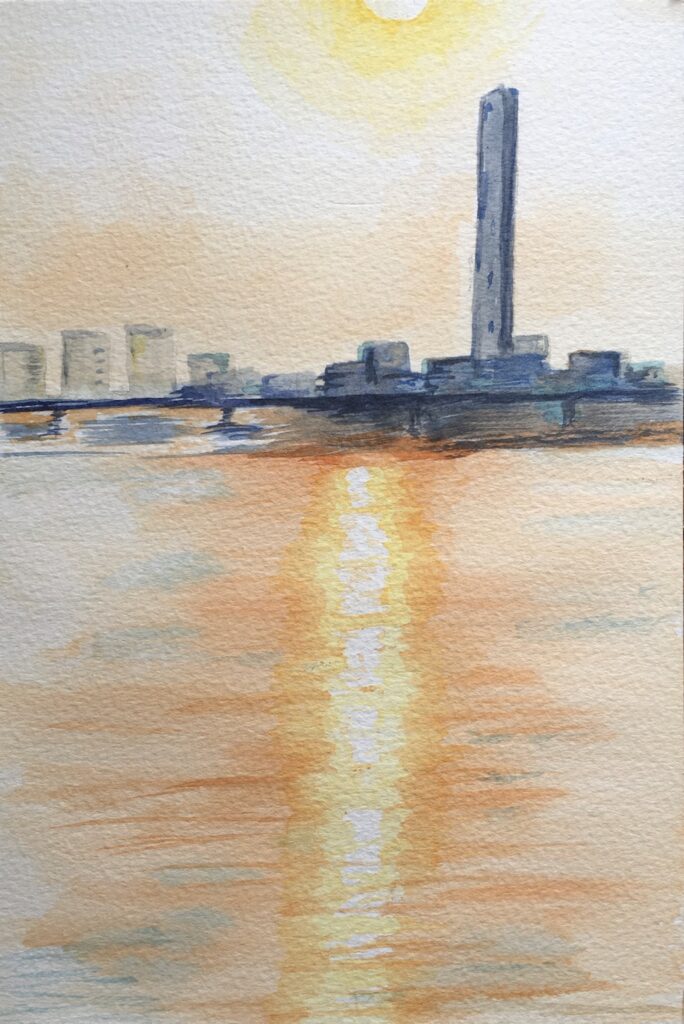
Watercolour
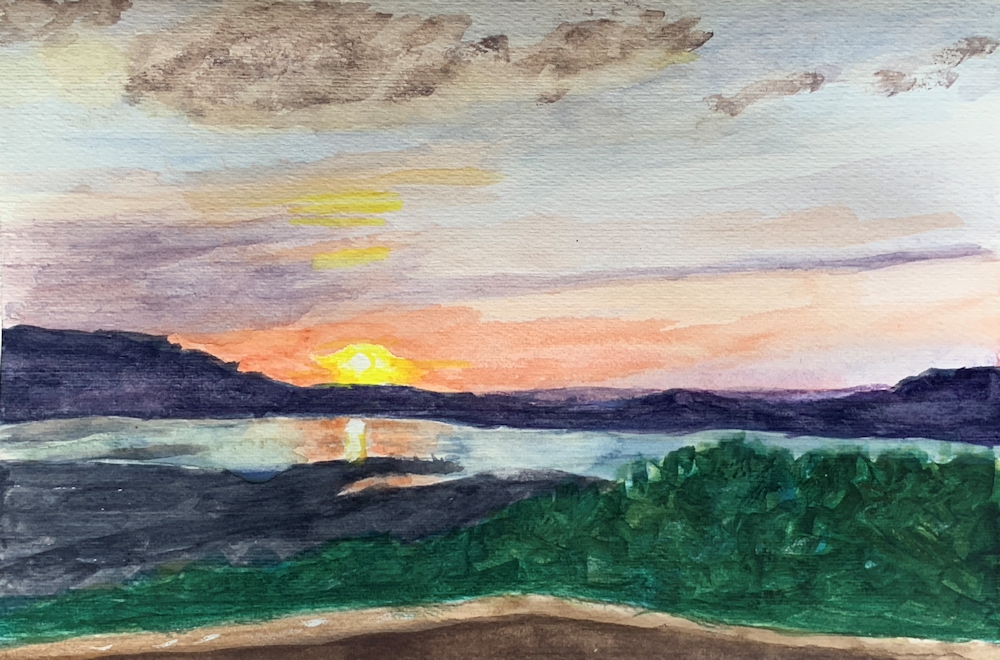
Watercolour
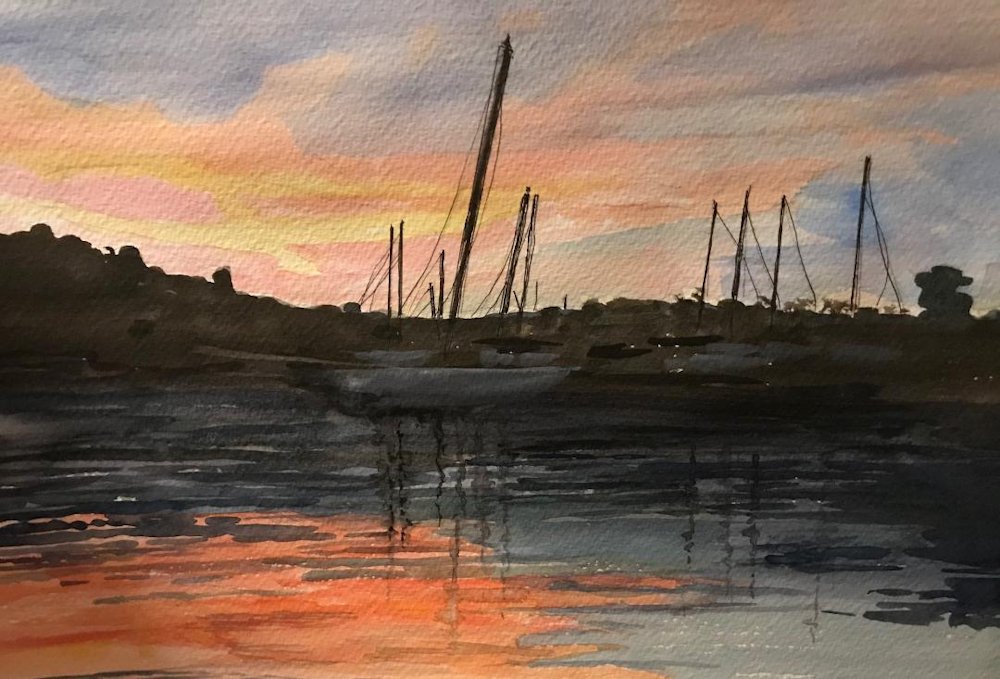
Watercolour by Sarah
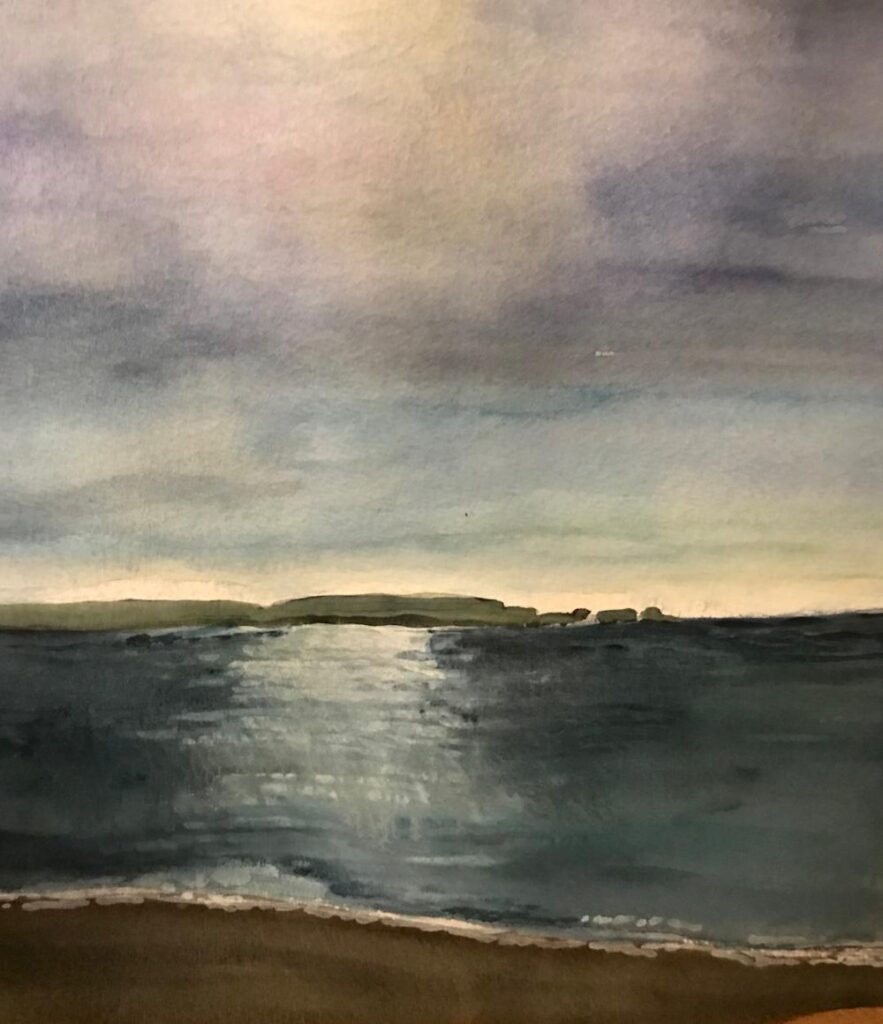
Watercolour by Sarah
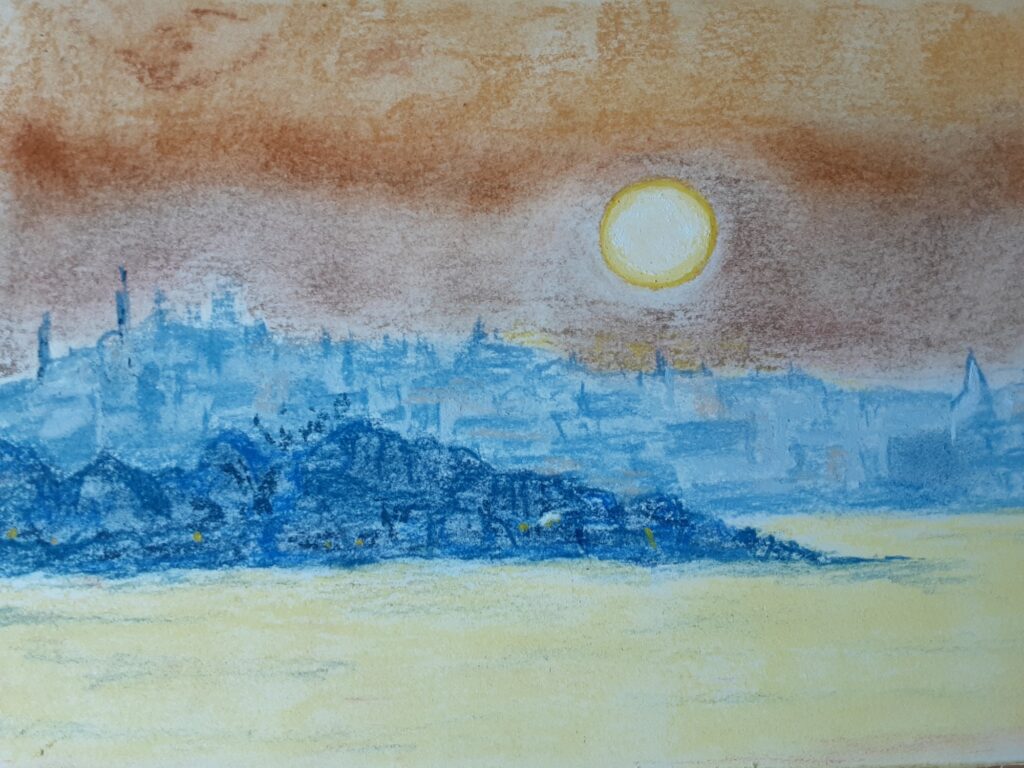
Pastel by Liz
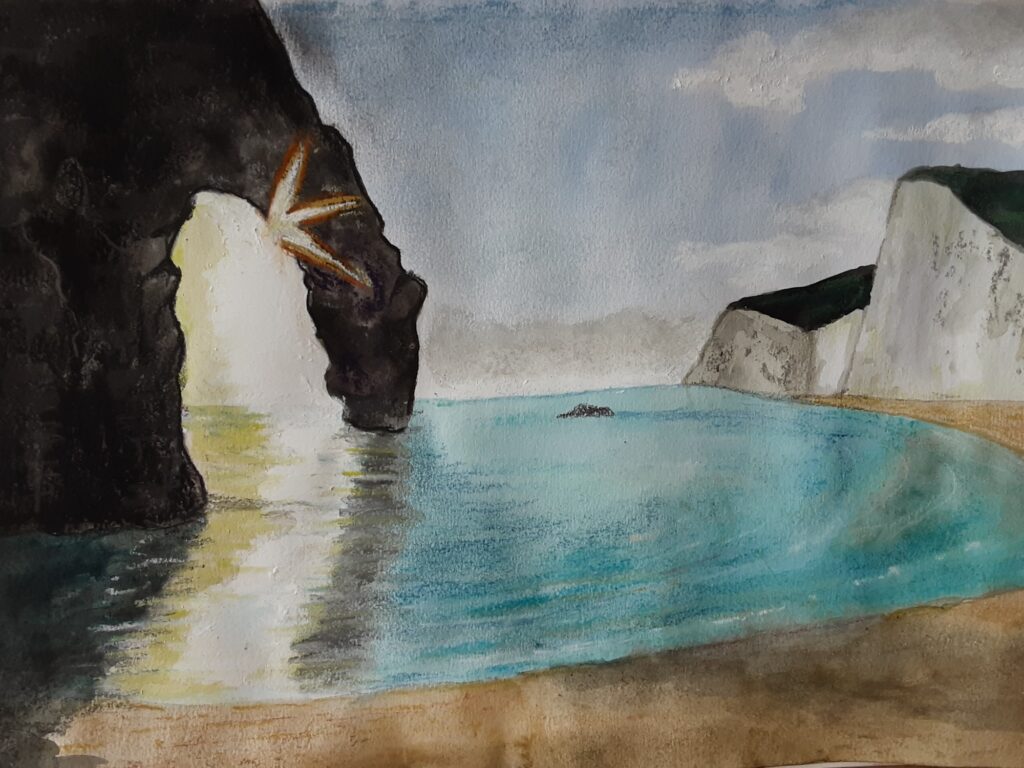
Watercolour, Pastel and Pastel Pencil
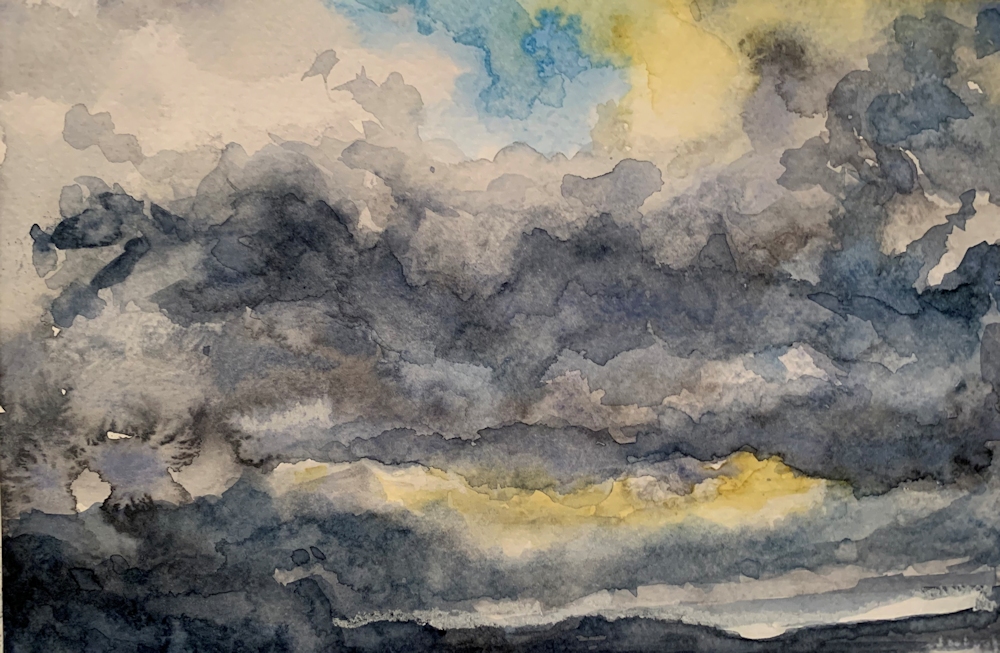
Watercolour
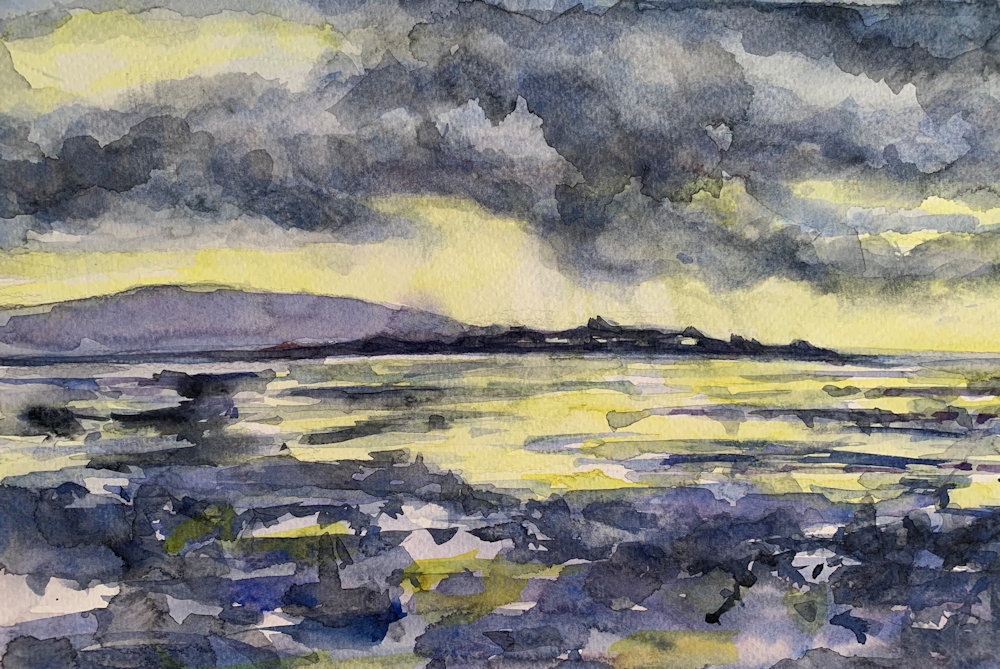
Watercolour
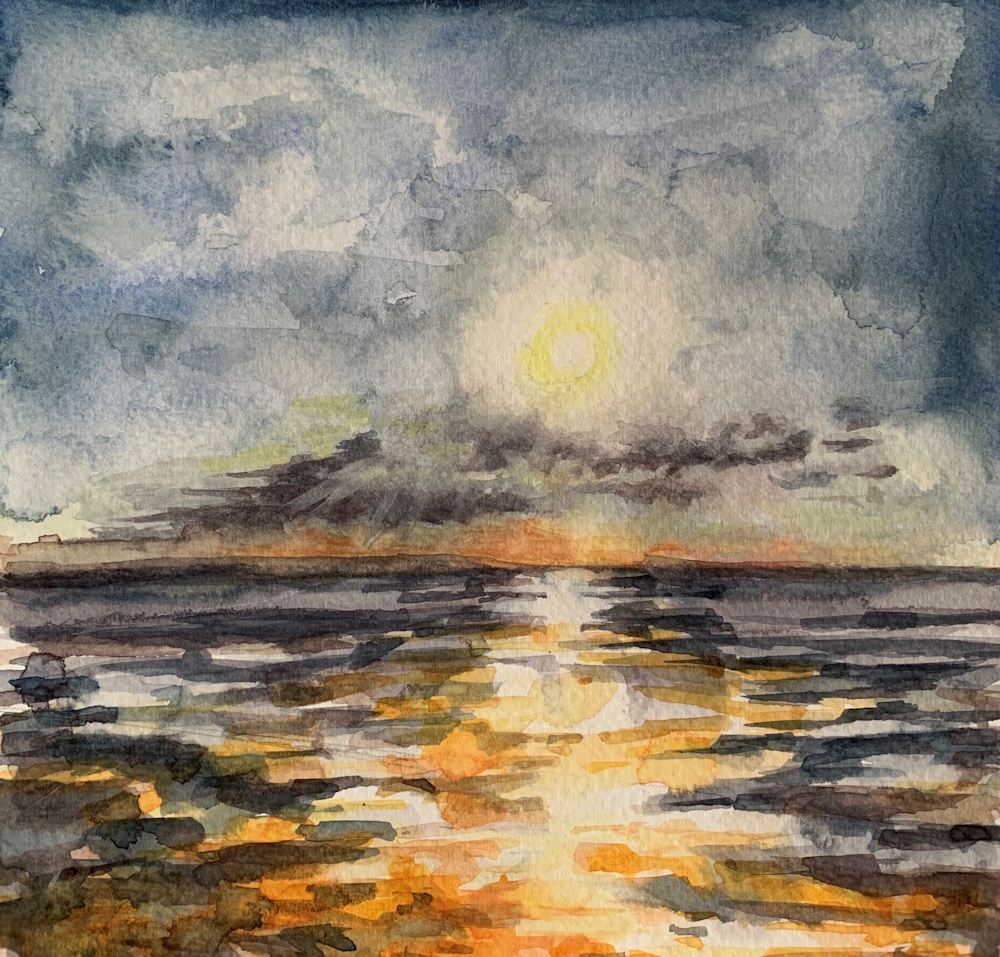
Watercolour
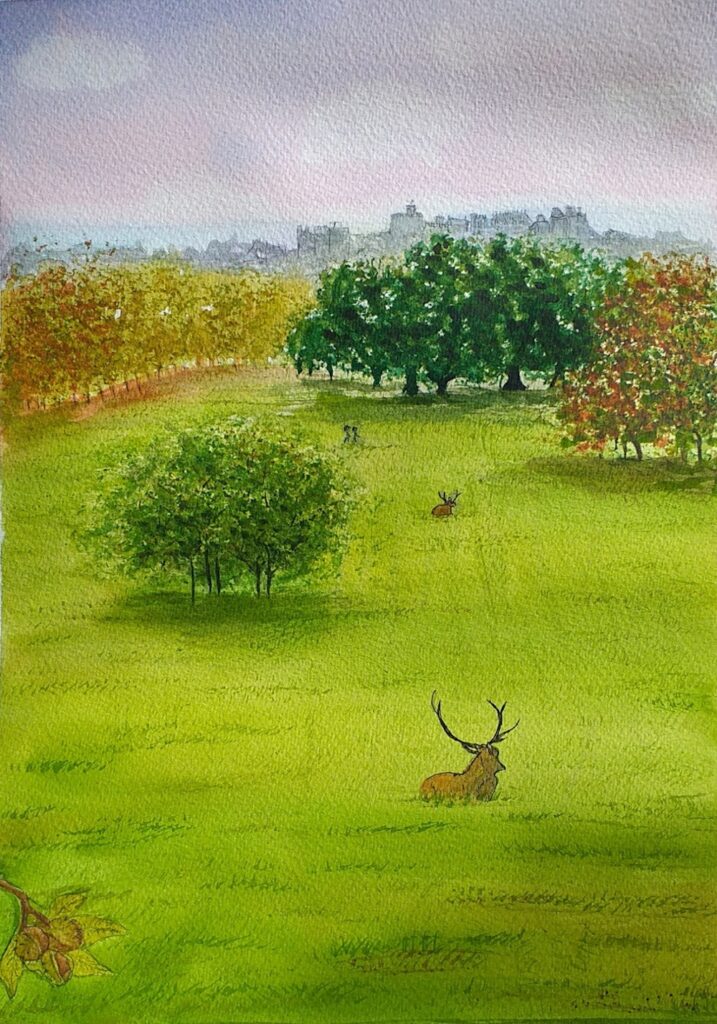
Watercolour
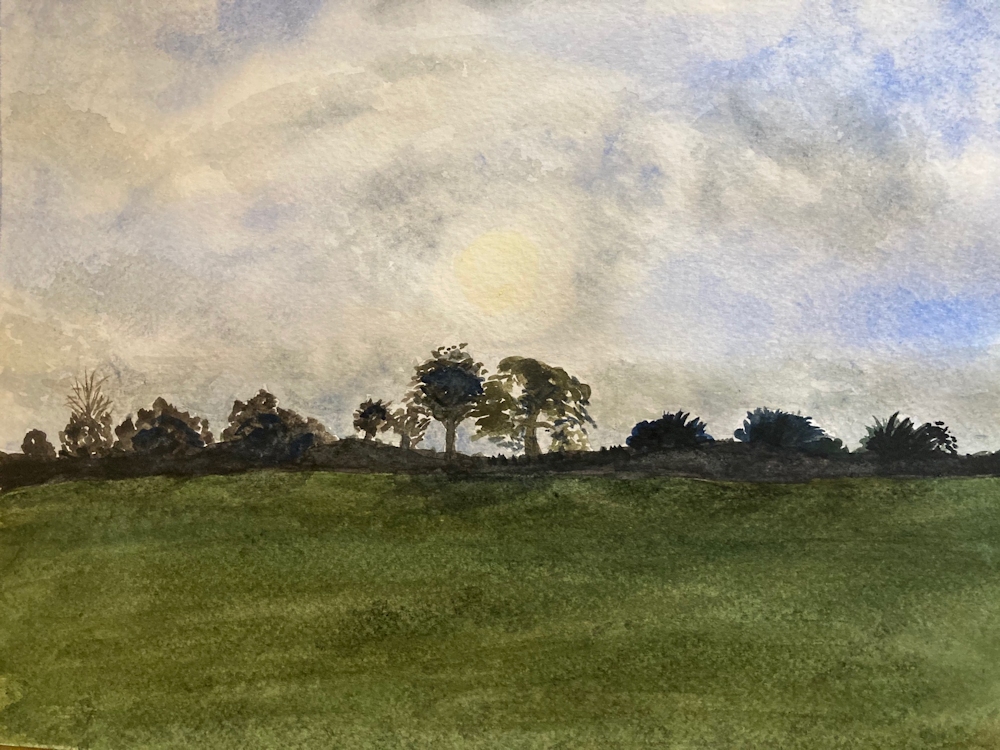
Watercolour







